903.6 Warning Signs: Difference between revisions
→903.6.11 Chevron Alignment Sign (W1-8) (MUTCD Section 2C.09): updated per RR3901 |
|||
| (48 intermediate revisions by 3 users not shown) | |||
| Line 6: | Line 6: | ||
|} | |} | ||
== | ==903.6.1 Function of Warning Signs ([https://mutcd.fhwa.dot.gov/ MUTCD] Section 2C.01)== | ||
'''Support.''' Warning signs call attention to unexpected conditions on or adjacent to a highway or | '''Support.''' Warning signs call attention to unexpected conditions on or adjacent to a highway, street or private road open to public travel and to situations that might not be readily apparent to road users. Warning signs alert road users to conditions that might call for a reduction of speed or an action in the interest of safety and efficient traffic operations. | ||
== | ==903.6.2 Application of Warning Signs ([https://mutcd.fhwa.dot.gov/ MUTCD] Section 2C.02)== | ||
'''Standard.''' The use of warning signs shall be based on an engineering study or on engineering judgment. | '''Standard.''' The use of warning signs shall be based on an engineering study or on engineering judgment. | ||
| Line 16: | Line 16: | ||
'''Guidance.''' The use of warning signs should be kept to a minimum as the unnecessary use of warning signs tends to increase disrespect for all signs. In situations where the condition or activity is seasonal or temporary, the warning sign should be removed or covered when the condition or activity does not exist. | '''Guidance.''' The use of warning signs should be kept to a minimum as the unnecessary use of warning signs tends to increase disrespect for all signs. In situations where the condition or activity is seasonal or temporary, the warning sign should be removed or covered when the condition or activity does not exist. | ||
'''Support.''' Warning signs | '''Option.''' Consistent with the provisions of the EPG, [https://epg.modot.org/index.php?title=616.6_Temporary_Traffic_Control_Zone_Devices_%28MUTCD_6F%29#616.6.60_Portable_Changeable_Message_Signs_.28MUTCD_6F.60.29 Changeable Message signs] may be used to display a warning message. Consistent with the provisions of [[903.2 Extent of Signing#903.2.17 Enhanced Conspicuity for Standard Signs (MUTCD Section 2A.15)|EPG 903.2.17, a Warning Beacon]] may be used in combination with a standard warning sign. | ||
'''Support.''' The categories of Warning signs are shown in Table 903.6.2. Warning signs provided in [[:Category:903 Highway Signing|EPG 903]] cover most of the conditions that are likely to be encountered. Additional warning signs for temporary traffic control zones, school areas, grade crossings, and bicycle facilities are discussed in [[903.18 Signing for School Areas|EPG 903.18 Signing for School Areas]], [[903.20 Signing for Rail and Light Rail Transit Grade Crossings|EPG 903.20 Signing for Rail and Light Rail Transit Grade Crossings]], and [[903.21 Signing for Bicycle Facilities|EPG 903.21 Signing for Bicycle Facilities]]. | |||
'''Option.''' Word message warning signs other than those specified in this article may be developed and installed. | '''Option.''' Word message warning signs other than those specified in this article may be developed and installed. | ||
=== | ===<center>Table 903.6.2 Categories of Warning Signs and Plaques</center>=== | ||
{| border="1" class="wikitable" style="margin: 1em auto 1em auto" style="text-align:center" | |||
|+ | |||
! style="background:#BEBEBE" |Category!! style="background:#BEBEBE" |Group !! style="background:#BEBEBE" |EPG Article !! style="background:#BEBEBE" |Signs or Plaques!! style="background:#BEBEBE"|Sign Numbers | |||
|- | |||
!rowspan="19"|Roadway Related | |||
|rowspan="8"|Changes in Horizontal Alignment||[[#903.6.7 Horizontal Alignment Signs (W1-1 through W1-5, W1-11, W1-15, W24-1L, W24-1cP) (MUTCD Section 2C.07)|903.6.7]]||Turn, Curve, Reverse Turn, Reverse Curve, Winding Road, Hairpin Curve||W1-1, 2, 3, 4, 5, 11, 15 | |||
|- | |||
| [[#903.6.46 Advisory Speed Supplemental Plaque (W13-1P) (MUTCD Section 2C.08)|903.6.46]]||Advisory Speed|| W13-1P | |||
|- | |||
|[[#903.6.11 Chevron Alignment Sign (W1-8) (MUTCD Section 2C.09)|903.6.11]] || Chevron Alignment|| W1-8 | |||
|- | |||
|[[#903.6.8 Combination Horizontal Alignment/Advisory Speed Sign (W1-1a, W1-2a) (MUTCD Section 2C.10)|903.6.8]] ||Combination Horizontal Alignment/Advisory Speed ||W1-1a, 2a | |||
|- | |||
|[[#903.6.9 Combination Horizontal Alignment/Intersection Signs (W1-10 Series) (MUTCD Section 2C.11)|903.6.9]] ||Combination Horizontal Alignment/Intersection ||W1-10, 10a, 10b, 10c, 10d | |||
|- | |||
|[[#903.6.10 One-Direction Large Arrow Sign (W1-6) (MUTCD Section 2C.12)|903.6.10]] ||Large Arrow (one direction) ||W1-6 | |||
|- | |||
|[[#903.6.12 Truck Rollover Warning Sign (W1-13) (MUTCD Section 2C.13)|903.6.12]] ||Truck Rollover ||W1-13 | |||
|- | |||
|[[#903.6.36 Advisory Exit and Ramp Speed Signs (W13-2 and W13-3) (MUTCD Section 2C.14)|903.6.36]] ||Advisory Exit or Ramp Speed ||W13-2, 3 | |||
|- | |||
|Vertical Alignment ||[[#903.6.13 Hill Signs (W7-1) (MUTCD Section 2C.16)|903.6.13]] ||Hill|| W7-1, 1a, 2P, 2bP, 3P, 3aP, 3bP | |||
|- | |||
|rowspan="5"|Cross-Section||[[#903.6.15 ROAD NARROWS Sign (W5-1) (MUTCD Section 2C.19)|903.6.15]] ||Road Narrows ||W5-1 | |||
|- | |||
|[[#903.6.16 NARROW BRIDGE Sign (W5-2) (MUTCD Section 2C.20)|903.6.16]], [[#903.6.17 ONE LANE BRIDGE Sign (W5-3) (MUTCD Section 2C.21)|903.6.17]] ||Narrow Bridge, One Lane Bridge ||W5-2, 3 | |||
|- | |||
|[[#903.6.18 Divided Highway Sign (W6-1) (MUTCD Section 2C.22)|903.6.18]] - [[#903.6.20 Double Arrow Sign (W12-1) (MUTCD Section 2C.25)|903.6.20]] ||Divided Highway, Divided Highway Ends, Double Arrow|| W6-1, 2; W12-1 | |||
|- | |||
|[[#903.6.21 DEAD END, NO OUTLET, and ROAD ENDS Signs (W14-1, W14-2, W14-13) (MUTCD Section 2C.26) |903.6.21]] ||Dead End, No Outlet ||W14-1, 1a, 2, 2a | |||
|- | |||
|[[#903.6.22 Low Clearance Sign (W12-2 and W12-2a) (MUTCD Section 2C.27)|903.6.22]] ||Low Clearance ||W12-2, 2a | |||
|- | |||
|rowspan="4"|Roadway Surface Condition|| [[#903.6.23 BUMP and DIP Signs (W8-1, W8-2) (MUTCD Section 2C.28)|903.6.23]] ||Bump, Dip ||W8-1, 2 | |||
|- | |||
| [[#903.6.24 PAVEMENT ENDS Sign (W8-3) (MUTCD Section 2C.30)|903.6.24]] ||Pavement Ends ||W8-3 | |||
|- | |||
| [[#903.6.25 SOFT SHOULDER Sign (W8-4) (MUTCD Section 2C.31)|903.6.25]] ||Soft Shoulder ||W8-4 | |||
|- | |||
|[[#903.6.26 Slippery When Wet Sign (W8-5) (MUTCD Section 2C.32)|903.6.26]], [[#903.6.27 FALLEN ROCKS Sign (W8-14) (MUTCD Section 2C.32)|903.6.27]] ||Slippery When Wet, Fallen Rocks ||W8-5, 20 | |||
|- | |||
|Weather || [[#903.6.52 IMPASSABLE DURING HIGH WATER Sign (W8-18, W8-19a, W8-34, W8-35) (MUTCD Section 2C.35)|903.6.52]] ||Road May Flood, Flood Gauge, Gusty Winds Area, Fog Area||W8-18, 19, 21, 22 | |||
|- | |||
!rowspan="7"|Traffic Related | |||
||Advance Traffic Control||[[#903.6.28 Advance Traffic Control Signs (W3-1, W3-2, W3-3, W3-4) (MUTCD Section 2C.36)|903.6.28]] - [[#903.6.30 Reduced Speed Limit Ahead Signs (W3-5) (MUTCD Section 2C.38)|903.6.30]] ||Stop Ahead, Yield Ahead, Signal Ahead, Be Prepared To Stop, Speed Reduction, Ramp Meter Ahead|| W3-1, | |||
2, 3, 4, 5, 5a, 6, 7, 8 | |||
|- | |||
|Traffic Flow || [[#903.6.31 Merge Signs (W4-1, W4-5) (MUTCD Section 2C.40)|903.6.31]] - [[#903.6.36 Advisory Exit and Ramp Speed Signs (W13-2 and W13-3) (MUTCD Section 2C.14)|903.6.36]] ||Merge, No Merge Area, Lane Ends, Added Lane, Two-Way Traffic, Right Lane Exit Only Ahead, No Passing Zone, Advisory Exit and Ramp Speed ||W4-1, 2, 3, 5, 5P, 6; W6-3;W9-1, 2, 7; W14-3 | |||
|- | |||
|rowspan="3"|Intersections || [[#903.6.37 Intersection Warning Signs (W2-1 through W2-8) (MUTCD Section 2C.46)|903.6.37]] ||Crossroad, Side Road, T, Y, Circular Intersection, Side Roads|| W2-1, 2, 3, 4, 5, 6, 7, 8; W16-12P, 17P | |||
|- | |||
| [[#903.6.38 Two-Direction Large Arrow Sign (W1-7) (MUTCD Section 2C.47)|903.6.38]] ||Large Arrow (two direction) ||W1-7 | |||
|- | |||
| [[#903.6.39 Traffic Signal Signs (W25-1, W25-2) (MUTCD Section 2C.48)|903.6.39]] ||Oncoming Extended Green ||W25-1, 2 | |||
|- | |||
|Vehicular Traffic|| [[#903.6.40 Vehicular Traffic Warning Signs (W11-1, W11-1b, W11-5, W11-8, W11-10, W11-12P, W11-14) (MUTCD Section 2C.49)|903.6.40]] ||Truck, Emergency Vehicle, Tractor, Bicycle, Golf Cart, Horse-Drawn Vehicle, Trail Crossing ||W8-6; W11-1, 5, 5a, 8, 10, 11, 12P, 14, 15, 15P, 15a; W16-13P | |||
|- | |||
|Non-Vehicular|| [[#903.6.41 Non-Vehicular Warning Signs (W11-2, W11-3, W11-4, W11-7, W11-32, W11-33, W16-9P) (MUTCD Section 2C.50)|903.6.41]] ||Pedestrian, Deer, Cattle, Snowmobile, Equestrian, Wheelchair, Large Animals ||W11-2, 3, 4, 6, 7, 9, 16, 17, 18, 19, 20, 21, 22; W16-13P | |||
|- | |||
!rowspan="7"|Other Supplemental Plaques | |||
||Location|| [[#903.6.41 Non-Vehicular Warning Signs (W11-2, W11-3, W11-4, W11-7, W11-32, W11-33, W16-9P) (MUTCD Section 2C.50)|903.6.41]] ||Downward Diagonal Arrow, Ahead|| W16-7P, 9P | |||
|- | |||
|Distance|| [[#903.6.45 Distance Supplemental Plaques (W16-2 Series, W16-3 Series, W16-4P, W7-3aP) (MUTCD Section 2C.55)|903.6.45]] ||XX Feet, XX Miles, Next XX Feet, Next XX Miles|| W7-3aP; W16-2P, 2aP, 3P, 3aP, 4P | |||
|- | |||
|Arrow || [[#903.6.47 Supplemental Arrow Plaque (W16-5P, W16-6P) (MUTCD Section 2C.56)|903.6.47]] ||Advance Arrow, Directional Arrow ||W16-5P, 6P | |||
|- | |||
|Street Name Plaque || [[#903.6.48 Advance Street Name Supplemental Plaque (W16-8P, W16-8aP) (MUTCD Section 2C.58)|903.6.48]] ||Advance Street Name ||W16-8P, 8aP | |||
|- | |||
|Intersection|| [[#903.6.49 CROSS TRAFFIC DOES NOT STOP Plaque (W4-4P) (MUTCD Section 2C.59)|903.6.49]] ||Cross Traffic Does Not Stop ||W4-4P, 4aP, 4bP | |||
|- | |||
|Share The Road|| [[#903.6.50 SHARE THE ROAD Supplemental Plaque (W16-1P) (MUTCD Section 2C.60)|903.6.50]] ||Share The Road ||W16-1P | |||
|- | |||
|Photo Enforced|| [[#903.6.51 PHOTO ENFORCED Plaque (W16-10aP) (MUTCD Section 2C.61)|903.6.51]] ||Photo Enforced ||W16-10P, 10aP | |||
|} | |||
==903.6.3 Design of Warning Signs ([https://mutcd.fhwa.dot.gov/ MUTCD] Section 2C.03)== | |||
'''Standard.''' Except as provided below or unless specifically designated otherwise, all warning signs shall be diamond-shaped (square with one diagonal vertical) with a black legend and border on a fluorescent yellow background. Warning signs shall be designed in accordance with the sizes, shapes, colors and legends contained in the [https://mutcd.fhwa.dot.gov/ser-shs_millennium.htm ''Standard Highway Signs and Markings''] book. | |||
''' | '''Option.''' A warning sign that is larger than the size shown in the Oversized column in Table 903.6.3 for that particular sign may be diamond-shaped or may be rectangular or square in shape. Warning signs regarding conditions associated with pedestrians, bicyclists and playgrounds may have a black legend and border on a fluorescent yellow background. | ||
''' | '''Standard.''' Warning signs regarding conditions associated with school buses and schools and their related supplemental plaques shall have a black legend and border on a fluorescent yellow-green background (see [[903.18 Signing for School Areas#903.18.9 School Zone Sign (S1-1) and Plaques (S4-3P) and END SCHOOL ZONE Sign (S5-2) (MUTCD Section 7B.09)|EPG 903.18.9]]). | ||
====<center> | ====<center>Table 903.6.3 Warning Sign and Plaque Sizes</center>==== | ||
{| border="1" class="wikitable" style="margin: 1em auto 1em auto" | {| border="1" class="wikitable" style="margin: 1em auto 1em auto" style="text-align:center" | ||
|+ | |+ | ||
! style="background:#BEBEBE"|Sign !! style="background:#BEBEBE"|Sign | ! style="background:#BEBEBE" ROWSPAN="2"|Sign or Plaque!! style="background:#BEBEBE" ROWSPAN="2"|Sign Designation !! style="background:#BEBEBE" ROWSPAN="2"|EPG Article !! style="background:#BEBEBE" colspan="3"|Conventional Road (in. x in.)!! style="background:#BEBEBE"|Freeway/Expressway (in. x in.) | ||
|- | |||
! style="background:#BEBEBE"|Single Lane !! style="background:#BEBEBE"|Multi-Lane !! style="background:#BEBEBE"| Oversized !! style="background:#BEBEBE"|Mainline & Ramps | |||
|- | |||
! Turn | |||
||W1-1 ||[[#903.6.7 Horizontal Alignment Signs (W1-1 through W1-5, W1-11, W1-15, W24-1L, W24-1cP) (MUTCD Section 2C.07) |903.6.7]] ||36 X 36||36 X 36||48 X 48|| 48 X 48 | |||
|- | |||
!Curve | |||
||W1-2 ||[[#903.6.7 Horizontal Alignment Signs (W1-1 through W1-5, W1-11, W1-15, W24-1L, W24-1cP) (MUTCD Section 2C.07) |903.6.7]] ||36 X 36||36 X 36||48 X 48|| 48 X 48 | |||
|- | |||
!Reverse Turn | |||
||W1-3 ||[[#903.6.7 Horizontal Alignment Signs (W1-1 through W1-5, W1-11, W1-15, W24-1L, W24-1cP) (MUTCD Section 2C.07) |903.6.7]] ||36 X 36||36 X 36||48 X 48|| 48 X 48 | |||
|- | |||
!Reverse Curve | |||
||W1-4 ||[[#903.6.7 Horizontal Alignment Signs (W1-1 through W1-5, W1-11, W1-15, W24-1L, W24-1cP) (MUTCD Section 2C.07) |903.6.7]] ||36 X 36||36 X 36||48 X 48|| 48 X 48 | |||
|- | |||
!Winding Road | |||
||W1-5 ||[[#903.6.7 Horizontal Alignment Signs (W1-1 through W1-5, W1-11, W1-15, W24-1L, W24-1cP) (MUTCD Section 2C.07) |903.6.7]] ||36 X 36||36 X 36||48 X 48|| 48 X 48 | |||
|- | |||
!Hairpin Curve | |||
||W1-11 ||[[#903.6.7 Horizontal Alignment Signs (W1-1 through W1-5, W1-11, W1-15, W24-1L, W24-1cP) (MUTCD Section 2C.07) |903.6.7]] ||36 X 36||36 X 36||48 X 48|| 48 X 48 | |||
|- | |||
!270° Curve | |||
||W1-15 ||[[#903.6.7 Horizontal Alignment Signs (W1-1 through W1-5, W1-11, W1-15, W24-1L, W24-1cP) (MUTCD Section 2C.07) |903.6.7]] ||36 X 36||36 X 36||48 X 48|| 48 X 48 | |||
|- | |||
!Double Reverse Curve Left | |||
||W24-1L|| [[#903.6.7 Horizontal Alignment Signs (W1-1 through W1-5, W1-11, W1-15, W24-1L, W24-1cP) (MUTCD Section 2C.07)|903.6.7]] || 36 X 36 || 36 X 36 || 48 X 48 ||48 X 48 | |||
|- | |||
!ALL LANES | |||
||W24-1cP || [[#903.6.7 Horizontal Alignment Signs (W1-1 through W1-5, W1-11, W1-15, W24-1L, W24-1cP) (MUTCD Section 2C.07)|903.6.7]]|| - || 24 X 18 || 36 X 24 || 36 X 24 | |||
|- | |||
!Combination Turn/Advisory Speed | |||
||W1-1a ||[[#903.6.8 Combination Horizontal Alignment/Advisory Speed Sign (W1-1a, W1-2a) (MUTCD Section 2C.10)|903.6.8]] ||36 X 36||36 X 36||48 X 48|| 48 X 48 | |||
|- | |||
!Combination Curve/Advisory Speed | |||
||W1-2a ||[[#903.6.8 Combination Horizontal Alignment/Advisory Speed Sign (W1-1a, W1-2a) (MUTCD Section 2C.10)|903.6.8]] ||36 X 36||36 X 36||48 X 48|| 48 X 48 | |||
|- | |||
!Combination Horizontal Alignment/Intersection | |||
||W1-10 ||[[#903.6.9 Combination Horizontal Alignment/Intersection Signs (W1-10 Series) (MUTCD Section 2C.11)|903.6.9]] ||36 X 36||36 X 36||48 X 48|| 48 X 48 | |||
|- | |||
!One-Direction Large Arrow | |||
||W1-6 ||[[#903.6.10 One-Direction Large Arrow Sign (W1-6) (MUTCD Section 2C.12)|903.6.10]] ||48 X 24||48 X 24||72 X 36|| 72 X 36 | |||
|- | |||
!Chevron | |||
||W1-8 ||[[#903.6.11 Chevron Alignment Sign (W1-8) (MUTCD Section 2C.09)|903.6.11]] ||18 X 24||18 X 24||30 X 36|| 30 X 36 | |||
|- | |- | ||
! | !Truck Rollover | ||
| | ||W1-13 ||[[#903.6.12 Truck Rollover Warning Sign (W1-13) (MUTCD Section 2C.13)|903.6.12]] ||- ||- ||- ||48 X 48 | ||
|- | |- | ||
! | !Hill | ||
| | ||W7-1 ||[[#903.6.13 Hill Signs (W7-1) (MUTCD Section 2C.16)|903.6.13]] ||36 X 36||36 X 36||48 X 48|| 48 X 48 | ||
|- | |- | ||
! | !ROAD NARROWS | ||
| | ||W5-1 ||[[#903.6.15 ROAD NARROWS Sign (W5-1) (MUTCD Section 2C.19)|903.6.15]] ||36 X 36||36 X 36||48 X 48|| 48 X 48 | ||
|- | |- | ||
! | !NARROW BRIDGE | ||
| | ||W5-2 ||[[#903.6.16 NARROW BRIDGE Sign (W5-2) (MUTCD Section 2C.20)|903.6.16]] ||36 X 36||36 X 36||48 X 48|| 48 X 48 | ||
|- | |- | ||
! | !ONE LANE BRIDGE | ||
| | ||W5-3 ||[[#903.6.17 ONE LANE BRIDGE Sign (W5-3) (MUTCD Section 2C.21)|903.6.17]] ||36 X 36||36 X 36||48 X 48|| 48 X 48 | ||
|- | |- | ||
! | !Divided Highway | ||
| | ||W6-1 ||[[#903.6.18 Divided Highway Sign (W6-1) (MUTCD Section 2C.22)|903.6.18]] ||36 X 36||36 X 36||48 X 48|| 48 X 48 | ||
|- | |- | ||
! | !Divided Highway Ends | ||
| | ||W6-2 ||[[#903.6.19 Divided Highway Ends Sign (W6-2) (MUTCD Section 2C.23)|903.6.19]] ||36 X 36||36 X 36||48 X 48|| 48 X 48 | ||
|- | |- | ||
! | !Double Down Arrow | ||
| | ||W12-1 ||[[#903.6.20 Double Arrow Sign (W12-1) (MUTCD Section 2C.25)|903.6.20]] ||30 X 30||36 X 36|| 36 X 36|| - | ||
|- | |- | ||
! | !DEAD END | ||
| | ||W14-1 || [[#903.6.21 DEAD END, NO OUTLET, and ROAD ENDS Signs (W14-1, W14-2, W14-13) (MUTCD Section 2C.26) |903.6.20]] ||36 X 36||36 X 36||36 X 36|| 36 X 36 | ||
|- | |- | ||
! | !NO OUTLET | ||
| | ||W14-2 ||[[#903.6.21 DEAD END, NO OUTLET, and ROAD ENDS Signs (W14-1, W14-2, W14-13) (MUTCD Section 2C.26) |903.6.20]] ||36 X 36||36 X 36||36 X 36|| 36 X 36 | ||
|- | |- | ||
! ROAD | !ROAD ENDS | ||
| | ||W14-13||[[#903.6.21 DEAD END, NO OUTLET, and ROAD ENDS Signs (W14-1, W14-2, W14-13) (MUTCD Section 2C.26) |903.6.20]] ||36 X 36||36 X 36||36 X 36|| 36 X 36 | ||
|- | |- | ||
! | !Low Clearance | ||
| | ||W12-2 ||[[#903.6.22 Low Clearance Sign (W12-2 and W12-2a) (MUTCD Section 2C.27)|903.6.22]] ||36 X 36||36 X 36||48 X 48|| 48 X 48 | ||
|- | |- | ||
! | !LOW CLEARNACE (overhead) | ||
| | ||W12-2a||[[#903.6.22 Low Clearance Sign (W12-2 and W12-2a) (MUTCD Section 2C.27)|903.6.22]] ||- ||- ||- ||84 X 24 | ||
|- | |- | ||
! | !PAVEMENT ENDS | ||
| | ||W8-3 ||[[#903.6.24 PAVEMENT ENDS Sign (W8-3) (MUTCD Section 2C.30)|903.6.24]] ||36 X 36||36 X 36|| -|| - | ||
|- | |- | ||
! | !SOFT SHOULDER | ||
| | ||W8-4 ||[[#903.6.25 SOFT SHOULDER Sign (W8-4) (MUTCD Section 2C.31)|903.6.25]] ||36 X 36||36 X 36||48 X 48|| 48 X 48 | ||
|- | |- | ||
! | !FALLEN ROCK | ||
| | ||W8-14 ||[[#903.6.27 FALLEN ROCKS Sign (W8-14) (MUTCD Section 2C.32)|903.6.27]] ||36 X 36||36 X 36||48 X 48|| 48 X 48 | ||
|- | |- | ||
! | !Stop Ahead | ||
| | ||W3-1 ||[[#903.6.28 Advance Traffic Control Signs (W3-1, W3-2, W3-3, W3-4) (MUTCD Section 2C.36)|903.6.28]] ||36 X 36||36 X 36||48 X 48|| 48 X 48 | ||
|- | |- | ||
! | !Yield Ahead | ||
| | ||W3-2 ||[[#903.6.28 Advance Traffic Control Signs (W3-1, W3-2, W3-3, W3-4) (MUTCD Section 2C.36)|903.6.28]] ||36 X 36||36 X 36||48 X 48|| 48 X 48 | ||
|- | |- | ||
! | !Signal Ahead | ||
| | ||W3-3 ||[[#903.6.28 Advance Traffic Control Signs (W3-1, W3-2, W3-3, W3-4) (MUTCD Section 2C.36)|903.6.28]] ||36 X 36||36 X 36||48 X 48|| 48 X 48 | ||
|- | |- | ||
! | !BE PREPARED TO STOP | ||
| | ||W3-4 ||[[#903.6.28 Advance Traffic Control Signs (W3-1, W3-2, W3-3, W3-4) (MUTCD Section 2C.36)|903.6.28]] ||36 X 36||36 X 36||48 X 48|| 48 X 48 | ||
|- | |- | ||
| | !Ramp Meter Ahead | ||
| | ||W3-7 || [[#903.6.29 Advance Ramp Control Signal Signs (W3-7 and W3-8) (MUTCD Section 2C.37)|903.6.29]] ||36 X 36||36 X 36|| -|| - | ||
|- | |- | ||
! | !Ramp Meter When Flashing | ||
| | ||W3-8 ||[[#903.6.29 Advance Ramp Control Signal Signs (W3-7 and W3-8) (MUTCD Section 2C.37)|903.6.29]] ||36 X 36||36 X 36|| -|| - | ||
|- | |- | ||
! | !Reduced Speed Ahead | ||
| | ||W3-5 ||[[#903.6.30 Reduced Speed Limit Ahead Signs (W3-5) (MUTCD Section 2C.38)|903.6.30]] ||36 X 36||36 X 36||48 X 48|| 48 X 48 | ||
|- | |- | ||
! | !Merge | ||
| | ||W4-1 ||[[#903.6.31 Merge Signs (W4-1, W4-5) (MUTCD Section 2C.40)|903.6.31]] ||36 X 36||36 X 36||48 X 48|| 48 X 48 | ||
|- | |- | ||
! | !Entering Roadway Merge | ||
| | ||W4-5 ||[[#903.6.31 Merge Signs (W4-1, W4-5) (MUTCD Section 2C.40)|903.6.31]] ||36 X 36||36 X 36||48 X 48|| 48 X 48 | ||
|- | |- | ||
! | !Added Lane | ||
| | ||W4-3 || [[#903.6.32 Added Lane Signs (W4-3, W4-6) (MUTCD Section 2C.41)|903.6.32]] ||36 X 36||36 X 36||48 X 48|| 48 X 48 | ||
|- | |- | ||
! | !Entering Roadway Added Lane | ||
| | ||W4-6 ||[[#903.6.32 Added Lane Signs (W4-3, W4-6) (MUTCD Section 2C.41)|903.6.32]] ||36 X 36||36 X 36||48 X 48|| 48 X 48 | ||
|- | |- | ||
! | !Lane Ends | ||
| | ||W4-2 || [[#903.6.33 LANE END Signs (W4-2, W9-1, W9-2) (MUTCD Section 2C.42)|903.6.33]] ||36 X 36||36 X 36||48 X 48|| 48 X 48 | ||
|- | |- | ||
! | !Left (Right) Lane Ends | ||
| | ||W9-1 ||[[#903.6.33 LANE END Signs (W4-2, W9-1, W9-2) (MUTCD Section 2C.42)|903.6.33]] ||36 X 36||36 X 36||48 X 48|| 48 X 48 | ||
|- | |- | ||
! | !Lane Ends Merge Left (Right) | ||
| | ||W9-2 ||[[#903.6.33 LANE END Signs (W4-2, W9-1, W9-2) (MUTCD Section 2C.42)|903.6.33]] ||36 X 36||36 X 36||48 X 48|| 48 X 48 | ||
|- | |- | ||
! | !Two-Way Traffic | ||
| | ||W6-3 ||[[#903.6.34 Two-Way Traffic Sign (W6-3, W16-9P) (MUTCD Section 2C.44)|903.6.34]] ||36 X 36||36 X 36||48 X 48||48 X 48 | ||
|- | |- | ||
! | !NO PASSING ZONE (pennant) | ||
| | ||W14-3 || [[#903.6.35 NO PASSING ZONE Sign (W14-3) (MUTCD Section 2C.45)|903.6.35]] ||48 X 30 ||- ||- ||- | ||
|- | |- | ||
! | !Advisory Exit Speed | ||
| | ||W13-2 ||[[#903.6.36 Advisory Exit and Ramp Speed Signs (W13-2 and W13-3) (MUTCD Section 2C.14)|903.6.36]] ||- ||- ||- ||48 X 60 | ||
|- | |- | ||
! | !Advisory Ramp Speed | ||
| | ||W13-3 ||[[#903.6.36 Advisory Exit and Ramp Speed Signs (W13-2 and W13-3) (MUTCD Section 2C.14)|903.6.36]] ||- ||- ||- ||48 X 60 | ||
|- | |- | ||
! | !Crossroad | ||
| | ||W2-1 ||[[#903.6.37 Intersection Warning Signs (W2-1 through W2-8) (MUTCD Section 2C.46)|903.6.37]] ||36 X 36||36 X 36||48 X 48|| 48 X 48 | ||
|- | |- | ||
! | !Side Road | ||
| | ||W2-2 ||[[#903.6.37 Intersection Warning Signs (W2-1 through W2-8) (MUTCD Section 2C.46)|903.6.37]] ||36 X 36||36 X 36||48 X 48|| 48 X 48 | ||
|- | |- | ||
! | !Side Road (45°) | ||
| | ||W2-3 ||[[#903.6.37 Intersection Warning Signs (W2-1 through W2-8) (MUTCD Section 2C.46)|903.6.37]] ||36 X 36||36 X 36||48 X 48|| 48 X 48 | ||
|- | |- | ||
! | !T Intersection | ||
| | ||W2-4 ||[[#903.6.37 Intersection Warning Signs (W2-1 through W2-8) (MUTCD Section 2C.46)|903.6.37]] ||36 X 36||36 X 36||48 X 48|| 48 X 48 | ||
|- | |- | ||
! | !Y Intersection | ||
| | ||W2-5 ||[[#903.6.37 Intersection Warning Signs (W2-1 through W2-8) (MUTCD Section 2C.46)|903.6.37]] ||36 X 36||36 X 36||48 X 48|| 48 X 48 | ||
|- | |- | ||
! | !Circular Intersection | ||
| | ||W2-6 ||[[#903.6.37 Intersection Warning Signs (W2-1 through W2-8) (MUTCD Section 2C.46)|903.6.37]] ||36 X 36||36 X 36||48 X 48|| 48 X 48 | ||
|- | |- | ||
! | !Two-Direction Large Arrow | ||
| | ||W1-7 ||[[#903.6.38 Two-Direction Large Arrow Sign (W1-7) (MUTCD Section 2C.47)|903.6.38]] ||48 X 24||48 X 24||72 X 36|| 72 X 36 | ||
|- | |- | ||
! | !TRAFFIC SIGNAL HAS EXTENDED GREEN | ||
| | ||W25-1 ||[[#903.6.39 Traffic Signal Signs (W25-1, W25-2) (MUTCD Section 2C.48)|903.6.39]] ||24 X 30||24 X 30|| -|| - | ||
|- | |- | ||
| | !TRAFFIC SIGNAL MAY HAVE EXTENDED GREEN | ||
| | ||W25-2 ||[[#903.6.39 Traffic Signal Signs (W25-1, W25-2) (MUTCD Section 2C.48)|903.6.39]] ||24 X 30||24 X 30|| -|| - | ||
| | |||
|- | |- | ||
! | !Bicycle | ||
| | ||W11-1 ||[[#903.6.40 Vehicular Traffic Warning Signs (W11-1, W11-1b, W11-5, W11-8, W11-10, W11-12P, W11-14) (MUTCD Section 2C.49)|903.6.40]] ||36 X 36||36 X 36|| -|| - | ||
|- | |- | ||
! | !Farm Vehicle | ||
| | ||W11-5 ||[[#903.6.40 Vehicular Traffic Warning Signs (W11-1, W11-1b, W11-5, W11-8, W11-10, W11-12P, W11-14) (MUTCD Section 2C.49)|903.6.40]] ||36 X 36||36 X 36||48 X 48|| 48 X 48 | ||
|- | |- | ||
! | !Emergency Vehicle | ||
| | ||W11-8 ||[[#903.6.40 Vehicular Traffic Warning Signs (W11-1, W11-1b, W11-5, W11-8, W11-10, W11-12P, W11-14) (MUTCD Section 2C.49)|903.6.40]] ||36 X 36||36 X 36||48 X 48|| 48 X 48 | ||
|- | |- | ||
! | !Truck | ||
| | ||W11-10|| [[#903.6.40 Vehicular Traffic Warning Signs (W11-1, W11-1b, W11-5, W11-8, W11-10, W11-12P, W11-14) (MUTCD Section 2C.49)|903.6.40]]||36 X 36||36 X 36||48 X 48|| 48 X 48 | ||
|- | |- | ||
! | !Horse-Drawn Vehicle | ||
| | ||W11-14||[[#903.6.40 Vehicular Traffic Warning Signs (W11-1, W11-1b, W11-5, W11-8, W11-10, W11-12P, W11-14) (MUTCD Section 2C.49)|903.6.40]] ||36 X 36||36 X 36||48 X 48|| 48 X 48 | ||
|- | |- | ||
! | !Pedestrian | ||
| | ||W11-2 ||[[#903.6.41 Non-Vehicular Warning Signs (W11-2, W11-3, W11-4, W11-7, W11-32, W11-33, W16-9P) (MUTCD Section 2C.50)|903.6.41]] ||36 X 36||48 x 48||48 X 48|| - | ||
|- | |- | ||
! | !Downward Diagonal Arrow | ||
| | ||W16-7P||[[#903.6.41 Non-Vehicular Warning Signs (W11-2, W11-3, W11-4, W11-7, W11-32, W11-33, W16-9P) (MUTCD Section 2C.50)|903.6.41]] ||30 X 18||30 X 18||30 X 18|| 30 X 18 | ||
|- | |- | ||
! | !Deer | ||
| | ||W11-3 ||[[#903.6.41 Non-Vehicular Warning Signs (W11-2, W11-3, W11-4, W11-7, W11-32, W11-33, W16-9P) (MUTCD Section 2C.50)|903.6.41]] ||36 X 36||36 X 36||48 X 48|| 48 X 48 | ||
|- | |- | ||
! | !Cattle | ||
| | ||W11-4 ||[[#903.6.41 Non-Vehicular Warning Signs (W11-2, W11-3, W11-4, W11-7, W11-32, W11-33, W16-9P) (MUTCD Section 2C.50)|903.6.41]] ||36 X 36||36 X 36|| -|| - | ||
|- | |- | ||
! | !Equestrian | ||
| | ||W11-7 ||[[#903.6.41 Non-Vehicular Warning Signs (W11-2, W11-3, W11-4, W11-7, W11-32, W11-33, W16-9P) (MUTCD Section 2C.50)|903.6.41]] ||36 X 36||36 X 36|| -|| - | ||
|- | |- | ||
! | !Pedestrian on Bridge | ||
| | ||W11-33||[[#903.6.41 Non-Vehicular Warning Signs (W11-2, W11-3, W11-4, W11-7, W11-32, W11-33, W16-9P) (MUTCD Section 2C.50)|903.6.41]] ||36 X 36||36 X 36||48 X 48|| 48 X 48 | ||
|- | |- | ||
! | !FERRY CROSSING AHEAD | ||
| | ||W3-18 ||[[#903.6.42 FERRY CROSSING AHEAD Sign (W3-18)|903.6.42]] ||36 X 36||36 X 36||48 X 48|| 48 X 48 | ||
|- | |- | ||
! | !_ FEET | ||
| | ||W16-2P||[[#903.6.45 Distance Supplemental Plaques (W16-2 Series, W16-3 Series, W16-4P, W7-3aP) (MUTCD Section 2C.55)|903.6.45]] ||24 X 18||24 X 18||30 X 24|| 30 X 24 | ||
|- | |- | ||
! | !_ MILES | ||
| | ||W16-3P|| [[#903.6.45 Distance Supplemental Plaques (W16-2 Series, W16-3 Series, W16-4P, W7-3aP) (MUTCD Section 2C.55)|903.6.45]]||24 X 18||24 X 18||30 X 24|| 30 X 24 | ||
|- | |- | ||
! | !NEXT _ FEET | ||
| | ||W16-4P|| [[#903.6.45 Distance Supplemental Plaques (W16-2 Series, W16-3 Series, W16-4P, W7-3aP) (MUTCD Section 2C.55)|903.6.45]]||30 X 24||30 X 24||30 X 24|| 30 X 24 | ||
|- | |- | ||
! | !NEXT _ MILES | ||
| | ||W7-3aP ||[[#903.6.45 Distance Supplemental Plaques (W16-2 Series, W16-3 Series, W16-4P, W7-3aP) (MUTCD Section 2C.55)|903.6.45]] ||24 X 18||24 X 18||30 X 24|| 30 X 24 | ||
|- | |- | ||
! | !Advisory Speed | ||
| | ||W13-1P||[[#903.6.46 Advisory Speed Supplemental Plaque (W13-1P) (MUTCD Section 2C.08)|903.6.46]]||24 X 24||24 X 24||30 X 30|| 30 X 30 | ||
|- | |- | ||
! | !Directional Arrow | ||
| | ||W16-5P|| [[#903.6.47 Supplemental Arrow Plaque (W16-5P, W16-6P) (MUTCD Section 2C.56)|903.6.47]]||24 X 18||24 X 18||30 X 24|| 30 X 24 | ||
|- | |- | ||
! | !Advance Turn Arrow | ||
| | ||W16-6P||[[#903.6.47 Supplemental Arrow Plaque (W16-5P, W16-6P) (MUTCD Section 2C.56)|903.6.47]] ||24 X 18||24 X 18||30 X 24|| 30 X 24 | ||
|- | |- | ||
! | !Percent Grade | ||
| | ||W7-3P ||[[#903.6.14 Hill-Related Supplemental Plaques (W7-3 Series) (MUTCD Section 2C.57)|903.6.14]] ||24 X 18||24 X 18||30 X 24|| 30 X 24 | ||
|- | |- | ||
| | !Advance Street Name | ||
| | ||W16-8P|| [[#903.6.48 Advance Street Name Supplemental Plaque (W16-8P, W16-8aP) (MUTCD Section 2C.58)|903.6.48]]||Varies X 15||Varies X 15||Varies X 15|| Varies X 15 | ||
| | |||
|- | |- | ||
! | !CROSS TRAFFIC DOES NOT STOP | ||
| | ||W4-4P || [[#903.6.49 CROSS TRAFFIC DOES NOT STOP Plaque (W4-4P) (MUTCD Section 2C.59)|903.6.49]] ||24 X 12||24 X 12||36 X 18|| 36 X 18 | ||
|- | |- | ||
! | !CROSS TRAFFIC FROM LEFT DOES NOT STOP | ||
| | ||W4-4aPL|| [[#903.6.49 CROSS TRAFFIC DOES NOT STOP Plaque (W4-4P) (MUTCD Section 2C.59)|903.6.49]] ||24x12|| 24x12|| 36 X 18|| 36 X 18 | ||
|- | |- | ||
! | !CROSS TRAFFIC FROM RIGHT DOES NOT STOP | ||
| | ||W4-4aPR|| [[#903.6.49 CROSS TRAFFIC DOES NOT STOP Plaque (W4-4P) (MUTCD Section 2C.59)|903.6.49]] ||24x12|| 24x12|| 36 X 18|| 36 X 18 | ||
|- | |- | ||
! | !ONCOMING TRAFFIC DOES NOT STOP | ||
| | ||W4-4bP|| [[#903.6.49 CROSS TRAFFIC DOES NOT STOP Plaque (W4-4P) (MUTCD Section 2C.59)|903.6.49]] ||24x12|| 24x12|| 36 X 18|| 36 X 18 | ||
|- | |- | ||
! | !SHARE THE ROAD | ||
| | ||W16-1P|| [[#903.6.50 SHARE THE ROAD Supplemental Plaque (W16-1P) (MUTCD Section 2C.60)|903.6.50]] ||24 X 30||24 X 30|| -|| 24 X 30 | ||
|- | |- | ||
! | !PHOTO ENFORCED | ||
| | ||W16-10aP|| [[#903.6.51 PHOTO ENFORCED Plaque (W16-10aP) (MUTCD Section 2C.61)|903.6.51]]||36 X 24||36 X 24|| -|| - | ||
|- | |- | ||
! | !WATER OVER ROAD | ||
| | ||W8-33 || - ||36 X 36||36 X 36||48 X 48|| 48 X 48 | ||
|- | |- | ||
! | !IMPASSABLE DURING HIGH WATER | ||
| | ||W8-34 || [[#903.6.52 IMPASSABLE DURING HIGH WATER Sign (W8-18, W8-19a, W8-34, W8-35) (MUTCD Section 2C.35)|903.6.52]] ||36 X 36||36 X 36||48 X 48|| 48 X 48 | ||
|- | |- | ||
! | !LOW WATER CROSSING | ||
| | ||W8-35 || [[#903.6.52 IMPASSABLE DURING HIGH WATER Sign (W8-18, W8-19a, W8-34, W8-35) (MUTCD Section 2C.35)|903.6.52]] ||36 X 36||36 X 36|| -|| - | ||
|- | |- | ||
! | !Water Gauge | ||
| | ||W8-19|| [[#903.6.52 IMPASSABLE DURING HIGH WATER Sign (W8-18, W8-19a, W8-34, W8-35) (MUTCD Section 2C.35)|903.6.52]]||12 X 72||12 X 72|| -|| - | ||
|- | |- | ||
! | !Passing Lane | ||
| | ||W6-6a || [[#903.6.56 Passing Lane Warning Signs (W6-6a, W6-6aP, W6-16, W6-17)|903.6.56]] ||36 X 36||36 X 36|| -|| - | ||
|- | |- | ||
! | !PASSING LANE | ||
| | ||W6-6aP|| [[#903.6.56 Passing Lane Warning Signs (W6-6a, W6-6aP, W6-16, W6-17)|903.6.56]]||42 X 12||42 X 12|| -|| - | ||
|- | |- | ||
! | !PASSING LANE ENDS | ||
| | ||W6-16 || [[#903.6.56 Passing Lane Warning Signs (W6-6a, W6-6aP, W6-16, W6-17)|903.6.56]] ||36 X 36||36 X 36|| -|| - | ||
|- | |- | ||
! | !WATCH FOR LEFT-TURNING TRAFFIC IN PASSING LANE | ||
| | ||W6-17 || [[#903.6.56 Passing Lane Warning Signs (W6-6a, W6-6aP, W6-16, W6-17)|903.6.56]] ||72 X 48||72 X 48|| -|| - | ||
|- | |- | ||
| | !TRAVEL SAFE ZONE | ||
||W26-1 || [[#903.6.57 TRAVEL SAFE ZONE – FINES DOUBLED Sign (W26-1)|903.6.57]] ||36 X 48||36 X 48||48 X 60|| 48 X 60 | |||
|} | |} | ||
== | ==903.6.4 Size of Warning Signs (MUTCD Section 2C.04)== | ||
'''Standard.''' | '''Standard.''' Except as provided in [[903.2 Extent of Signing#903.2.13 Dimensions (MUTCD Section 2A.11)|EPG 903.2.13]], the sizes for warning plaques shall be as shown in Table 903.6.4. | ||
===<center>Table 903.6.4, Minimum Size of Supplemental Warning Plaques=== | |||
<center> | |||
{| border="1" class="wikitable" style="margin: 1em auto 1em auto" style="text-align:center" | |||
|+ | |||
! style="background:#BEBEBE" rowspan="3"|Size of Warning Sign (in. x in.)!! style="background:#BEBEBE" colspan="4"|Size of Supplemental Plaque (in. x in.) | |||
|- | |||
! style="background:#BEBEBE" colspan="3"|Rectangular !! style="background:#BEBEBE" rowspan="2"|Square | |||
|- | |||
! style="background:#BEBEBE"|1 Line !! style="background:#BEBEBE"|2 Lines !! style="background:#BEBEBE"|Arrow | |||
|- | |||
|36 X 36||rowspan="2"| 30 X18 ||rowspan="2"|30 X 24|| rowspan="2"|30 X 18||rowspan="2"|24 X 24 | |||
|- | |||
|48 X 48 | |||
|} | |||
'''Option.''' | </center> | ||
'''Option.''' Larger sizes may be used for those special applications where speed, volume or other factors result in conditions where increased emphasis, improved recognition or increased legibility would be desirable. | |||
Signs larger than those shown in [[#Table 903.6.3 Warning Sign and Plaque Sizes|Table 903.6.3]] may be used with the approval of the State Highway Safety and Traffic Engineer. | |||
'''Guidance.''' The minimum size for all diamond-shaped warning signs facing traffic on exit and entrance ramps should be the same size sign as the mainline roadway classification. | |||
== | ==903.6.5 Sight Distance== | ||
'''Support.''' The decision to use most warning signs is based on prevailing conditions. The items to be considered when determining the need for a warning sign are sight distance and prevailing speed. Prevailing speed is determined by using either the posted or | '''Support.''' The decision to use most warning signs is based on prevailing conditions. The items to be considered when determining the need for a warning sign are sight distance and prevailing speed. Prevailing speed is determined by using either the posted or 85<sup>th</sup> percentile speed on the facility. Sight distance is the distance a driver requires to perceive, react, and respond to a condition. The prevailing speed affects the amount of sight distance required for a condition. | ||
It is a recommended to use Table 903.6.5 to determine the sight distance needed when considering the use of most warning signs. If the sight distance is less than that in Table 903.6.5, a sign may be needed. | It is a recommended to use Table 903.6.5 to determine the sight distance needed when considering the use of most warning signs. If the sight distance is less than that in Table 903.6.5, a sign may be needed. | ||
===<center>Table 903.6.5 Sight Distance Requirements</center>=== | |||
{| border="1" class="wikitable" style="margin: 1em auto 1em auto" | {| border="1" class="wikitable" style="margin: 1em auto 1em auto" | ||
|+ | |+ | ||
| Line 315: | Line 432: | ||
| align="center"|30|| align="center"| 200 | | align="center"|30|| align="center"| 200 | ||
|- | |- | ||
| align="center"|35 || align="center"| | | align="center"|35 || align="center"|250 | ||
|- | |- | ||
| align="center"|40|| align="center"| 305 | | align="center"|40|| align="center"| 305 | ||
| Line 331: | Line 448: | ||
| align="center"|70|| align="center"| 730 | | align="center"|70|| align="center"| 730 | ||
|- | |- | ||
|colspan="2"| | |colspan="2"|Note: Based on the AASHTO Green Book, 2001 Edition, Exhibit 3-1 | ||
|} | |} | ||
== | ==903.6.6 Placement of Warning Signs (MUTCD Section 2C.05)== | ||
'''Support.''' For information on placement of warning signs, see [[903. | '''Support.''' For information on placement of warning signs, see [[903.3 Post-Mounted Signing|EPG 903.3]] and [[903.4 Overhead Guide Sign Mounting|EPG 903.4]]. | ||
The | The time needed for detection, recognition, decision, and reaction is called the Perception-Response Time (PRT). | ||
Table 903.6.6 | Table 903.6.6 is provided as an aid for determining warning sign location. The distances shown in Table 903.6.6 can be adjusted for roadway features, other signing and to improve visibility. | ||
'''Standard.''' | '''Standard.''' The minimum visibility for warning signs shall be determined from Table 903.6.6. | ||
'''Guidance.''' | '''Guidance.''' Warning signs should be placed so that they provide an adequate PRT. The distances contained in Table 903.6.6 are for guidance purposes and should be applied with engineering judgment. Warning signs are not to be placed so far in advance of the condition that drivers tend to forget the warning because of other driving distractions, especially in urban areas. | ||
Minimum spacing between warning signs with different messages should be based on the estimated | Minimum spacing between warning signs with different messages should be based on the estimated PRT for driver comprehension of and reaction to the second sign. If an adjustment is necessary, every effort should be made to make it as small as possible. | ||
The effectiveness of the placement of warning signs should be periodically evaluated | The effectiveness of the placement of warning signs should be periodically evaluated. This is typically accomplished during routine sign inspection cycles. | ||
''' | '''Standard.''' When any part of a warning sign assembly (post, sign, plaque, etc.) is replaced, maintained or modified, the placement of the sign shall be reviewed based on the Table 903.6.6. Additionally, mounting height shall be reviewed for conformance with [[903.3 Ground-Mounted Sign Supports#903.3.3 Mounting Height (MUTCD Section 2A.18)|EPG 903.3.3 Mounting Height]]. | ||
Warning signs that advise road users about conditions that are not related to a specific location, such as | '''Option.''' Warning signs that advise road users about conditions that are not related to a specific location, such as Non-Vehicle signs or SOFT SHOULDER, may be installed in an appropriate location, based on engineering judgment, since they are not covered in Table 903.6.6. | ||
===<center>Table 903.6.6 Guidelines for Advance Placement of Warning Sign</center>=== | |||
{| border="1" class="wikitable" style="margin: 1em auto 1em auto" | {| border="1" class="wikitable" style="margin: 1em auto 1em auto" | ||
|+ | |+ | ||
!style="background:#BEBEBE" rowspan="3"|Posted or 85th Percentile Speed !! style="background:#BEBEBE" colspan="9"|Advance Placement Distance<sup>1 | !style="background:#BEBEBE" rowspan="3"|Posted or 85th Percentile Speed !! style="background:#BEBEBE" colspan="9"|Advance Placement Distance<sup>1</sup> | ||
|- | |- | ||
!style="background:#BEBEBE" rowspan="2"|Condition A: Speed reduction and lane changing in heavy traffic<sup>2!!style="background:#BEBEBE" colspan="8"|Condition B: Deceleration to the listed advisory speed (mph) for the condition | !style="background:#BEBEBE" rowspan="2"|Condition A: Speed reduction and lane changing in heavy traffic<sup>2!!style="background:#BEBEBE" colspan="8"|Condition B: Deceleration to the listed advisory speed (mph) for the condition | ||
|- | |- | ||
!0<sup>3!!10!!20!!30!!40!!50!!60!!70 | !0<sup>3!!10<sup>4!!20<sup>4!!30<sup>4!!40<sup>4!!50<sup>4!!60<sup>4!!70<sup>4 | ||
|- | |- | ||
| align="center"|20 mph|| align="center"|225 ft.|| | | align="center"|20 mph|| align="center"|225 ft.|| 100 ft.<sup>6||N/A<sup>5|| - ||-||-||-||-||- | ||
|- | |- | ||
| align="center"|25 mph|| align="center"|325 ft.|| | | align="center"|25 mph|| align="center"|325 ft.|| 100 ft.<sup>6||N/A<sup>5|| N/A<sup>5 ||-||-||-||-||- | ||
|- | |- | ||
| align="center"|30 mph|| align="center"| | | align="center"|30 mph|| align="center"|460 ft.|| 100 ft.<sup>6||N/A<sup>5|| N/A<sup>5 ||-||-||-||-||- | ||
|- | |- | ||
| align="center"|35 mph|| align="center"| | | align="center"|35 mph|| align="center"|565 ft.|| 100 ft.<sup>6||N/A<sup>5|| N/A<sup>5 ||N/A<sup>5||-||-||-||- | ||
|- | |- | ||
| align="center"|40 mph|| align="center"| | | align="center"|40 mph|| align="center"|670 ft.|| 125 ft.||100 ft.<sup>6|| 100 ft.<sup>6 ||N/A<sup>5||-||-||-||- | ||
|- | |- | ||
| align="center"|45 mph|| align="center"| | | align="center"|45 mph|| align="center"|775 ft.|| 175 ft.||125 ft.|| 100 ft.<sup>6 ||100 ft.<sup>6||N/A<sup>5||-||-||- | ||
|- | |- | ||
| align="center"|50 mph|| align="center"| | | align="center"|50 mph|| align="center"|885 ft.|| 250 ft.||200 ft.||175 ft. ||125 ft.||100 ft.<sup>6||-||-||- | ||
|- | |- | ||
| align="center"|55 mph|| align="center"| | | align="center"|55 mph|| align="center"|990 ft.|| 325 ft.||275 ft.||225 ft. ||200 ft.||125 ft.||N/A<sup>5||-||- | ||
|- | |- | ||
| align="center"|60 mph|| align="center"|1100 ft.|| 400 ft.||350 ft.|| | | align="center"|60 mph|| align="center"|1100 ft.|| 400 ft.||350 ft.||325 ft. ||275 ft.||200 ft.||100 ft.<sup>6||-||- | ||
|- | |- | ||
| align="center"|65 mph|| align="center"|1200 ft.|| 475 ft.|| | | align="center"|65 mph|| align="center"|1200 ft.|| 475 ft.||450 ft.||400 ft. ||350 ft.||275 ft.||200 ft.||100 ft.<sup>6||- | ||
|- | |- | ||
| align="center"|70 mph|| align="center"|1250 ft.|| 550 ft.||525 ft.||500 ft. || | | align="center"|70 mph|| align="center"|1250 ft.|| 550 ft.||525 ft.||500 ft. ||450 ft.||375 ft.||275 ft.||150 ft.||- | ||
|- | |- | ||
| align="center"|75 mph|| align="center"|1350 ft.|| 650 ft.||625 ft.||600 ft. || | | align="center"|75 mph|| align="center"|1350 ft.|| 650 ft.||625 ft.||600 ft. ||550 ft.||475 ft.||375 ft.||250 ft.||100 ft.<sup>6 | ||
|- | |- | ||
|colspan="10"|Notes: | |colspan="10"|Notes: | ||
1 The distances are adjusted for a sign legibility distance of | '''1''' The distances are adjusted for a sign legibility distance of 180 ft. for Condition A. The distances for Condition B have been adjusted for a sign legibility distance of 250 ft., which is appropriate for an alignment warning symbol sign. For Conditions A and B, warning signs with less than 6 in. legend or more than four words, a minimum of 100 ft. should be added to the advance placement distance to provide adequate legibility of the warning sign. | ||
'''2''' Typical conditions are locations where the road user must use extra time to adjust speed and change lanes in heavy traffic because of a complex driving situation. Typical signs are Merge and Right Lane Ends. The distances are determined by providing the driver a PRT of 14.0 to 14.5 seconds for vehicle maneuvers (2005 AASHTO Policy, Exhibit 3-3, Decision Sight Distance, Avoidance Maneuver E) minus the legibility distance of 180 ft. for the appropriate sign. | |||
'''3''' Typical condition is the warning of a potential stop situation. Typical signs are Stop Ahead, Yield Ahead, Signal Ahead, and Intersection Warning signs. The distances are based on the 2004 AASHTO Policy, Exhibit 3-1, Stopping Sight Distance, providing a PRT of 2.5 seconds, a deceleration rate of 11.2 ft./sec<sup>2</sup>, minus the sign legibility distance of 180 feet. | |||
'''4''' Typical conditions are locations where the road user must decrease speed to maneuver through the warned condition. Typical signs are Turn, Curve, Reverse Turn, or Reverse Curve. The distance is determined by providing a 2.5 second PRT, a vehicle deceleration rate of 10 ft./sec<sup>2</sup>, minus the sign legibility distance of 250 feet. | |||
'''5''' No suggested distances are provided for these speeds, as the placement location is dependent on site conditions and other signing. An alignment warning sign may be placed anywhere from the point of curvature up to 100 ft. in advance of the curve. However, the alignment warning sign should be installed in advance of the curve and at least 100 ft. from any signs. | |||
'''6''' The minimum advance placement distance is listed as 100 ft. to provide adequate spacing between signs. | |||
|} | |} | ||
== | ==903.6.7 Horizontal Alignment Signs (W1-1 through W1-5, W1-11, W1-15, W24-1L, W24-1cP) ([https://mutcd.fhwa.dot.gov/ MUTCD] Section 2C.07)== | ||
{| style="margin: 1em auto 1em auto" | {| style="margin: 1em auto 1em auto" | ||
|- | |- | ||
|[[image:W1-1.gif|left|thumb|<center>'''W1-1'''</center>|75px]] | |[[image:W1-1.gif|left|thumb|<center>'''W1-1'''</center>|75px]] | ||
||[[image:W1-2. | ||[[image:W1-2.jpg|left|75px|thumb|<center>'''W1-2'''</center>]] | ||
||[[image:W1-3. | ||[[image:W1-3.jpg|left|75px|thumb|<center>'''W1-3'''</center>]] | ||
||[[image:W1-4. | ||[[image:W1-4.jpg|left|75px|thumb|<center>'''W1-4'''</center>]] | ||
||[[image:W1-5.gif|left|75px|thumb|<center>'''W1-5'''</center>]] | ||[[image:W1-5.gif|left|75px|thumb|<center>'''W1-5'''</center>]] | ||
||[[image:W1-11.gif|left|75px|thumb|<center>'''W1-11'''</center>]] | ||[[image:W1-11.gif|left|75px|thumb|<center>'''W1-11'''</center>]] | ||
||[[image:W1-15.jpg|left|75px|thumb|<center>'''W1-15'''</center>]] | |||
||[[image:W24-1L.jpg|left|75px|thumb|<center>'''W24-1L'''</center>]] | |||
||[[image:W24-1cP.jpg|left|55px|thumb|<center>'''W24-1cP'''</center>]] | |||
|} | |} | ||
'''Support.''' A variety of horizontal alignment warning signs, pavement markings, and delineation can be used to advise motorists of a change in the roadway alignment. Uniform application of these traffic control devices with respect to the amount of change in the roadway alignment conveys a consistent message establishing driver expectancy and promoting effective roadway operations. The design and application of horizontal alignment warning signs to meet those requirements are addressed in EPG 903.6.7.1 through 903.6.7.6. | |||
'''Standard.''' All horizontal alignment signs shall have an Advisory Speed Supplemental Plaque (W13-1P) mounted below the primary warning when the difference between the posted speed limit and the advisory speed is 5 mph or greater. See [[#903.6.46 Advisory Speed Supplemental Plaque (W13-1P) (MUTCD Section 2C.08)|EPG 903.6.46]] for additional guidance on the application of the Advisory Speed Supplemental Plaque (W13-1P). | |||
'''Option.''' If engineering judgment indicates the need for the horizontal alignment sign for a curve that can be driven at or above the posted speed limit, horizontal alignment signs may be installed with the Advisory Speed Supplemental Plaque (W13-1P) displaying an advisory speed equal to the posted speed limit. | |||
===903.6.7.1 Turn and Curve Signs (W1-1, W1-2)=== | |||
'''Standard.''' A Curve sign (W1-2) shall be used when the difference between the speed limit and advisory speed is 5 mph or greater, unless a different sign is recommended or allowed. A Turn sign (W1-1) shall be used instead of a Curve sign in advance of curves that have advisory speeds of 30 mph or less. | |||
===903.6.7.2 Reverse Turn and Reverse Curve Signs (W1-3, W1-4)=== | |||
'''Guidance.''' Where there are two changes in roadway alignment in opposite directions that are separated by a tangent distance of less than 600 ft., the Reverse Turn (W1-3) sign should be used instead of multiple Turn (W1-1) signs and the Reverse Curve (W1-4) sign should be used instead of multiple Curve (W1-2) signs. | |||
===903.6.7.3 Winding Road Sign (W1-5)=== | |||
'''Option.''' A Winding Road (W1-5) sign may be used instead of multiple Turn (W1-1) or Curve (W1-2) signs where there are three or more changes in roadway alignment each separated by a tangent distance of less than 600 feet. | |||
A NEXT XX MILES (W7-3aP) supplemental distance plaque may be installed below the Winding Road sign where continuous roadway curves exist for a specific distance. | |||
===903.6.7.4 Hairpin Curve (W1-11) and 270-Loop Signs (W1-15)=== | |||
''' | '''Option.''' If the curve has a change in horizontal alignment of 135 degrees or more, the Hairpin Curve (W1-11) sign may be used instead of a Curve or Turn sign. | ||
If the curve has a change of direction of approximately 270 degrees, such as on a cloverleaf interchange ramp, the 270-degree Loop (W1-15) sign may be used instead of a Curve or Turn sign. | |||
Guidance. When the Hairpin Curve sign or the 270-degree Loop sign is installed, either a One-Direction Large Arrow (W1-6) sign or Chevron Alignment (W1-8) signs should be installed on the outside of the turn or curve. | |||
===903.6.7.5 Double Reverse Curve Left Sign (W24-1L) – [[234.6 Diverging Diamond Interchanges|Diverging Diamond Interchange (DDI)]] Application=== | |||
'''Standard.''' A double reverse curve left sign (W24-1L) shall be used on the crossroad approaches to a DDI when the difference between the speed limit and advisory speed for the DDI is 5 mph or greater. | |||
===903.6.7.6 ALL LANES Supplemental Plaque (W24-1cP) – [[234.6 Diverging Diamond Interchanges|Diverging Diamond Interchange (DDI)]] Application=== | |||
'''Standard.''' An ALL LANES supplemental plaque (W24-1cP) shall be placed below the double reverse curve left sign (W24-1L) for a diverging diamond interchange when there are two or more lanes in the direction the sign references. | |||
===<center>Table 903.6.7 Horizontal Alignment Sign Usage</center>=== | |||
{| border="1" class="wikitable" style="margin: 1em auto 1em auto" | {| border="1" class="wikitable" style="margin: 1em auto 1em auto" | ||
|+ | |+ | ||
!style="background:#BEBEBE" rowspan="2"|Number of Alignment Changes !! style="background:#BEBEBE" colspan="2"|Advisory Speed | !style="background:#BEBEBE" rowspan="2"|Number of Alignment Changes !! style="background:#BEBEBE" colspan="2"|Advisory Speed | ||
|- | |- | ||
!Less than or equal to 30 mph!!Greater than 30 mph | !style="background:#BEBEBE"|Less than or equal to 30 mph!!style="background:#BEBEBE"|Greater than 30 mph | ||
|- | |- | ||
| align="center"|1|| align="center"|Turn (W1-1) | | align="center"|1|| align="center"|Turn (W1-1)|| align="center"|Curve (W1-2) | ||
|- | |- | ||
| align="center"|2<sup> | | align="center"|2<sup>'''1'''</sup>|| align="center"|Reverse Turn (W1-3)<sup>'''2'''</sup>|| align="center"|Reverse Curve (W1-4)<sup>'''2'''</sup> | ||
|- | |- | ||
| align="center"|3 or more<sup> | | align="center"|3 or more<sup>'''1'''</sup>||colspan="2" align="center"|Winding Road (W1-5)<sup>'''2'''</sup> | ||
|- | |- | ||
|colspan="3"|Notes: | |colspan="3"|Notes: | ||
<sup>1 | <sup>'''1'''</sup> Alignment changes are in opposite directions and are separated by a tangent distance of 600 ft. or less. | ||
or less. | |||
<sup> | <sup>'''2'''</sup> A Right Reverse Turn (W1-3R), Right Reverse Curve (W1-4R) or Right Winding (W1-5R) sign is used if the first change in alignment is the right; a Left Reverse Turn (W1-3L), Left Reverse Curve (W1-4L) or Left Winding (W1-5L) sign is used if the first change in alignment is the left. | ||
|} | |} | ||
[[image:Figure 903.6.7.1. | [[image:Figure 903.6.7.1.jpg|center|650px|thumb|'''Figure 903.6.7.1 Example For Placement of Curve Warning Sign, Condition B: Speed Plaque at 40 and Posted Speed at 50 mph''']] | ||
[[image:Figure 903.6.7.2. | [[image:Figure 903.6.7.2.jpg|center|650px|thumb|'''Figure 903.6.7.2 Winding Road Distance Plaque Application''']] | ||
== | ==903.6.8 Combination Horizontal Alignment/Advisory Speed Sign (W1-1a, W1-2a) ([https://mutcd.fhwa.dot.gov/ MUTCD] Section 2C.10)== | ||
{| style="margin: 1em auto 1em auto" | {| style="margin: 1em auto 1em auto" | ||
|- | |- | ||
|[[image:W1-1a.gif|left|thumb|<center>'''W1-1a'''</center>|100px]] | |[[image:W1-1a.gif|left|thumb|<center>'''W1-1a'''</center>|100px]] | ||
||[[image:W1-2a. | ||[[image:W1-2a.jpg|left|100px|thumb|<center>'''W1-2a'''</center>]] | ||
|} | |} | ||
'''Option.''' | '''Option.''' The Turn (W1-1) sign or the Curve (W1-2) sign may be combined with the Advisory Speed (W13-1P) plaque (see [[#903.6.45 Distance Supplemental Plaques (W16-2 Series, W16-3 Series, W16-4P, W7-3aP) (MUTCD Section 2C.55)|EPG 903.6.45]]) to create a combination Turn/Advisory Speed (W1-1a) sign or combination Curve/Advisory Speed (W1-2a) sign. | ||
The combination Horizontal Alignment/Advisory Speed sign may be used to supplement the advance Horizontal Alignment warning sign and Advisory Speed plaque based upon an engineering study. | |||
'''Standard.''' | '''Standard.''' If used, the combination Horizontal Alignment/Advisory Speed sign shall not be used alone and shall not be used as a substitute for a Horizontal Alignment warning sign and Advisory Speed sign, but shall only be used as a supplement to the advance Horizontal Alignment warning sign. If used, the combination Horizontal Alignment/Advisory Speed sign shall be installed at the beginning of the turn or curve and the speed displayed shall match the advisory speed below the Horizontal Alignment sign. | ||
== | ==903.6.9 Combination Horizontal Alignment/Intersection Signs (W1-10 Series) ([https://mutcd.fhwa.dot.gov/ MUTCD] Section 2C.11)== | ||
[[image:W1-10.gif|center|125px|thumb|<center>'''W1-10'''</center>]] | [[image:W1-10.gif|center|125px|thumb|<center>'''W1-10'''</center>]] | ||
'''Option.''' The Turn (W1-1) sign or the Curve (W1-2) sign may be combined with the Cross Road (W2-1) sign or the Side Road (W2-2 or W2-3) sign to create a combination Horizontal Alignment/Intersection (W1-10) sign that depicts the condition where an intersection occurs within a turn or curve. | '''Option.''' The Turn (W1-1) sign or the Curve (W1-2) sign may be combined with the Cross Road (W2-1) sign or the Side Road (W2-2 or W2-3) sign to create a combination Horizontal Alignment/Intersection (W1-10 series) sign that depicts the condition where an intersection occurs within or immediately adjacent to a turn or curve. | ||
'''Guidance.''' | '''Guidance.''' Elements of the combination Horizontal Alignment/Intersection sign related to horizontal alignment should comply with the provisions of [[#903.6.7 Horizontal Alignment Signs (W1-1 through W1-5, W1-11, W1-15, W24-1L, W24-1cP) (MUTCD Section 2C.07)|EPG 903.6.7, Horizontal Alignment Signs]], and elements related to intersection configuration should comply with the provisions of [[#903.6.37 Intersection Warning Signs (W2-1 through W2-8) (MUTCD Section 2C.46)|EPG 903.6.37 Intersection Warning Signs]]. The symbol design should approximate the configuration of the intersecting roadway(s). No more than one Cross Road or two Side Road symbols should be displayed on any one combination Horizontal Alignment/Intersection sign. | ||
A layout of the proposed sign should be included when ordering. | A layout of the proposed sign should be included when ordering. | ||
'''Standard.''' | '''Standard.''' If used, a Curve/Sideroad Left (W1-10L) sign shall indicate a curve to the left, while a Curve/Sideroad Right (W1-10R) sign shall indicate a curve to the right. | ||
[[image: | ==903.6.10 One-Direction Large Arrow Sign (W1-6) ([https://mutcd.fhwa.dot.gov/ MUTCD] Section 2C.12)== | ||
[[image:W1-6.gif|center|125px|thumb|<center>'''W1-6'''</center>]] | |||
'''Standard.''' The One-Direction Large Arrow sign shall be a horizontal rectangle with an arrow pointing to the left or right. The use of the One-Direction Large Arrow sign shall be in accordance with the information shown in [[#Table 903.6.7 Horizontal Alignment Sign Usage|Table 903.6.7]]. If used, the One-Direction Large Arrow sign shall be installed on the outside of a turn or curve in line with and at approximately a right angle to approaching traffic. The One-Direction Large Arrow sign shall not be used where there is no alignment change in the direction of travel, such as at the beginnings and ends of medians or at center piers. The One-Direction Large Arrow sign directing traffic to the right shall not be used in the central island of a roundabout. | |||
[[ | |||
A One-Direction Large Arrow (W1-6) sign shall be used to delineate a change in horizontal alignment where the advisory speed is 30 mph or lower for a turn or reverse turn. (See Fig. 903.6.10.) | |||
''' | '''Option. ''' A One-Direction Large Arrow (W1-6) sign may be supplemented, or replaced with, Chevron Alignment signs to delineate a change in horizontal alignment of 30 mph or lower. | ||
'''Guidance.''' | '''Guidance.''' If used, the One-Direction Large Arrow sign should be visible for a sufficient distance to provide the road user with adequate time to react to the change in alignment. | ||
If chevrons are used to supplement the One-Direction Large Arrow sign, chevrons and arrow signs should be installed so they do not visually block each other. See Figure 903.6.10. | |||
[[image:903.6.10.jpg|center|600px|thumb|<center>'''Figure 903.6.10 One-Direction Large Arrow Board'''</center>]] | |||
== | ==903.6.11 Chevron Alignment Sign (W1-8) ([https://mutcd.fhwa.dot.gov/ MUTCD] Section 2C.09)== | ||
[[image:W1-8.gif|center|125px|thumb|<center>'''W1-8'''</center>]] | [[image:W1-8.gif|center|125px|thumb|<center>'''W1-8'''</center>]] | ||
''' | '''Support.''' Examples of when to use Chevron signs include locations where there is a crash history, evidence of drivers losing control on a curve or turn, a sharp change in alignment not readily visible to the driver, or as a systemic curve improvement program. | ||
The majority of fatal and serious injury crashes are attributed to lane departure crashes (State Strategic Highway Safety Plan). Chevrons are a highly cost-effective way to reduce lane departure crashes in curves and turns. | |||
Implementation of the 2009 MUTCD requirements for chevron deployments resulted in a statewide reduction in severe lane departure crashes in horizontal curves. To maintain this observed safety benefit, MoDOT has established standards based on the 2009 MUTCD criteria, which is above the minimum requirements in the 2023 edition of the MUTCD. For more details on the safety benefits of chevrons, contact the Highway Safety and Traffic Division. | |||
'''Standard.''' The use of the Chevron Alignment (W1-8 series) sign to provide additional emphasis and guidance for a change in horizontal alignment shall be applied to roadways with 1,000 AADT or more, on curves where the difference between the advisory speed for the curve and the posted speed limit for the roadway is 15 mph or greater. | |||
The Chevron Alignment sign shall be a vertical rectangle. No border shall be used on the Chevron Alignment sign. If used, Chevron Alignment signs shall be installed on the outside of a turn or curve, in line with and at approximately a right angle to approaching traffic. Chevron Alignment signs shall be installed at a minimum height of 4 feet, measured vertically from the bottom of the sign to the elevation of the near edge of the traveled way. This will place the sign at approximately the driver’s eye height. | |||
Guidance. Based on engineering judgement, chevron alignment signs may be omitted within incorporated city limits. | |||
As chevrons are installed, all horizontal alignment signing (chevrons, curve and turn signing, advisory speed plaques and arrow boards) on a corridor should be evaluated to assure their installations meet current standards. Aspects of existing horizontal alignment signs to look at can include spacing of existing chevrons, offset and mounting heights of any horizontal alignment sign as well as the distance advanced warning signs are installed from the curve/turn. The need for curve/turn signs could also be reevaluated if the ball banking these signs were installed under is out of date due to roadway/pavement improvements or simply the changes in vehicle performance. | |||
'''Option.''' Chevron Alignment signs may also be used on any other roadways based on engineering judgment. | |||
Chevron Alignment signs may be used instead of, or in addition to, the One-Direction Large Arrow (W1-6) sign on turns posted at 30 mph or less. | |||
LEDs may be used to enhance the conspicuity of Chevron Alignment signs in accordance with [[903.2_Extent_of_Signing#903.2.9_Retroreflectivity_and_Illumination_.28MUTCD_Section_2A.07.29|EPG 903.2.9]]. | |||
'''Guidance.''' The approximate spacing of Chevron Alignment signs on the turn or curve measured from the point of curvature (PC) should be as shown in Table 903.6.11. The Chevron Alignment signs should be visible for a sufficient distance to provide the road user with adequate time to react to the change in alignment. In addition to the Chevron Alignment signs placed throughout the curve, there shall be one sign in advance of the PC and one after the PT. These signs shall be spaced the same as the Chevron Alignment signs in the curve. | |||
The | Table 903.6.11 should be used for determining spacing. The values in Table 903.6.11 are typical and variances for driveways, public roads, and other signs may alter the spacing. Engineering judgment may also be used to modify the spacing as long as travelers always have at least two Chevron Alignment signs in view until the change in alignment eliminates the need for the signs. | ||
At the end of a divided highway, where the traffic reduces to two lanes, chevrons should be used to direct traffic from the dual lanes that are ending and being redirected to the two-lane roadway. | |||
The | The single-sided Chevron sign side should only be used where only one direction of travel is impacted, such as on an expressway. | ||
The double-side Chevron (W1-8D) should be used on two-lane, two-way roads. | |||
'''Standard.''' If used, the LEDs used in the Chevron Alignment sign shall consist of yellow LEDs outlining the chevron symbol. | |||
Chevron Alignment signs shall not be placed on the far side of a T-intersection facing traffic on the stem approach to warn drivers that a through movement is not physically possible, as this is the function of a Two-Direction (or One-Direction) Large Arrow sign. Chevron Alignment signs shall not be used to mark obstructions within or adjacent to the roadway, including the beginning of guardrails or barriers, as this is the function of an object marker. | |||
Chevron Alignment signs directing traffic to the right shall not be used in the central island of a roundabout or a neighborhood traffic circle. | |||
===<center>Table 903.6.11 Typical Spacing of Chevron Alignment Signs on Horizontal Curves=== | |||
{| border="1" class="wikitable" style="margin: 1em auto 1em auto" | <center> | ||
{| border="1" class="wikitable" style="margin: 1em auto 1em auto" style="text-align:center" | |||
|+ | |+ | ||
! style="background:#BEBEBE"| | ! style="background:#BEBEBE"|Advisory Speed !! style="background:#BEBEBE"|Sign Spacing | ||
|- | |- | ||
| | |width="200"|15 mph or less ||width="150"|40 feet | ||
|- | |- | ||
| | |20 to 30 mph ||60 feet | ||
|- | |- | ||
| | |35 to 45 mph ||80 feet | ||
| | |||
|- | |- | ||
| | |50 to 60 mph ||100 feet | ||
|- | |- | ||
| | |More than 60 mph ||140 feet | ||
|} | |} | ||
</center> | |||
== | ==903.6.12 Truck Rollover Warning Sign (W1-13) ([https://mutcd.fhwa.dot.gov/ MUTCD] Section 2C.13)== | ||
[[image:W1-13.gif|center|125px|thumb|<center>'''W1-13'''</center>]] | [[image:W1-13.gif|center|125px|thumb|<center>'''W1-13'''</center>]] | ||
'''Option.''' A Truck Rollover Warning (W1-13) sign may be used to warn drivers of vehicles with a high center of gravity, such as trucks, tankers and recreational vehicles of a curve or turn | '''Option.''' A Truck Rollover Warning (W1-13) sign may be used to warn drivers of vehicles with a high center of gravity, such as trucks, tankers, and recreational vehicles of a curve or turn where geometric conditions might contribute to a loss of control and a rollover as determined by an engineering study. | ||
'''Standard.''' | '''Standard.''' If a Truck Rollover Warning (W1-13) sign is used, an Advisory Speed Plaque (W13-1P) plaque indicating the recommended speed for vehicles with a higher center of gravity shall accompany it. | ||
'''Option.''' | '''Option.''' The Truck Rollover Warning sign may be displayed as a static sign, as a static sign supplemented by a flashing warning beacon, or as a changeable message sign activated by the detection of an approaching vehicle with a high center of gravity that is traveling in excess of the recommended speed for the condition. | ||
The curved arrow on the Truck Rollover Warning sign shows the direction of roadway curvature. The truck tips in the opposite direction. | |||
== | ==903.6.13 Hill Signs (W7-1) ([https://mutcd.fhwa.dot.gov/ MUTCD] Section 2C.16)== | ||
{| style="margin: 1em auto 1em auto" | {| style="margin: 1em auto 1em auto" | ||
| Line 661: | Line 712: | ||
|} | |} | ||
'''Guidance.''' The Hill (W7-1) sign should be used in advance of a downgrade where the length, percent of grade, horizontal curvature and/or other physical features requires special precautions on the part of road users. | '''Guidance.''' The Hill (W7-1) sign should be used in advance of a downgrade where the length, percent of grade, horizontal curvature, and/or other physical features requires special precautions on the part of road users. | ||
The Hill sign and supplemental grade (W7- | The Hill sign and supplemental grade (W7-3P) plaque (refer to [[#903.6.14 Hill-Related Supplemental Plaques (W7-3 Series) (MUTCD Section 2C.57)|EPG 903.6.14]]) used in combination should be installed in advance of downgrades for the following conditions: | ||
A. 5% grade that is more than 3,000 ft. | A. 5% grade that is more than 3,000 ft. long; | ||
B. 6% grade that is more than 2,000 ft. | B. 6% grade that is more than 2,000 ft. long; | ||
C. 7% grade that is more than 1,000 ft. | C. 7% grade that is more than 1,000 ft. long; | ||
D. 8% grade that is more than 750 ft. | D. 8% grade that is more than 750 ft. long; | ||
E. 9% grade that is more than 500 ft. | E. 9% grade that is more than 500 ft. long; | ||
F. 11% grade that is more than 400 ft. | F. 11% grade that is more than 400 ft. long; | ||
G. 13% grade that is more than 300 ft. | G. 13% grade that is more than 300 ft. long; | ||
H. 15% grade that is more than 200 ft. | H. 15% grade that is more than 200 ft. long; or | ||
I. 16% or more grade that is any length. | I. 16% or more grade that is any length. | ||
| Line 685: | Line 736: | ||
These signs are also to be installed for steeper grades or where crash experience and field observations indicate a need or at grades of five percent or more where any part of the grade is on a curve sharper than four degrees. | These signs are also to be installed for steeper grades or where crash experience and field observations indicate a need or at grades of five percent or more where any part of the grade is on a curve sharper than four degrees. | ||
Supplemental plaques (refer to | Supplemental plaques (refer to EPG 903.6.14, below) and larger signs should be used for emphasis or where special hill characteristics exist. On longer grades, the use of the Hill sign with a distance (W7-3aP) plaque at periodic intervals of approximately 1 mile spacing should be considered. | ||
'''Standard.''' | '''Standard.''' If the percent grade is displayed on a supplemental plaque, the plaque shall be placed below the Hill (W7-1) sign. | ||
'''Support.''' The Uphill (W7-1c) sign is also available by special request. | '''Support.''' The Uphill (W7-1c) sign is also available by special request. | ||
== | ==903.6.14 Hill-Related Supplemental Plaques (W7-3 Series) ([https://mutcd.fhwa.dot.gov/ MUTCD] Section 2C.57)== | ||
''' | {| style="margin: 1em auto 1em auto" | ||
|- | |||
|[[image:W7-3aP.jpg|left|thumb|<center>'''W7-3aP'''</center>|100px]] | |||
||[[image:W7-3P.jpg|left|100px|thumb|<center>'''W7-3P'''</center>]] | |||
|} | |||
''' | '''Guidance.''' Hill-Related (W7-3 series) supplemental plaques or other appropriate legends and larger signs should be used for emphasis or where special hill characteristics exist. On longer grades, the use of the supplemental distance plaque (W7-3aP) at periodic intervals of approximately 1 mile spacing should be considered. | ||
== | ==903.6.15 ROAD NARROWS Sign (W5-1) ([https://mutcd.fhwa.dot.gov/ MUTCD] Section 2C.19)== | ||
[[image:W5-1.gif|center|125px|thumb|<center>'''W5-1'''</center>]] | [[image:W5-1.gif|center|125px|thumb|<center>'''W5-1'''</center>]] | ||
'''Guidance.''' | '''Guidance.''' Except as provided below, a ROAD NARROWS (W5-1) sign should be used in advance of a transition on two-lane roads where the pavement width is reduced abruptly to such a narrow width that vehicles traveling in opposite direction cannot simultaneously travel through the narrow portion of the roadway without reducing speed. | ||
'''Option.''' Additional emphasis may be provided by the use of object markers and delineators. The Advisory Speed (W13-1) plaque may be used to indicate the recommended speed. | '''Option.''' The ROAD NARROWS (W5-1) sign may be omitted on low-volume local streets that have speed limits of 30 mph or less. Additional emphasis may be provided by the use of object markers and delineators. The Advisory Speed (W13-1) plaque may be used to indicate the recommended speed. | ||
== | ==903.6.16 NARROW BRIDGE Sign (W5-2) ([https://mutcd.fhwa.dot.gov/ MUTCD] Section 2C.20)== | ||
[[image:W5-2.gif|center|125px|thumb|<center>'''W5-2'''</center>]] | [[image:W5-2.gif|center|125px|thumb|<center>'''W5-2'''</center>]] | ||
'''Guidance.''' A NARROW BRIDGE (W5-2) sign should be used in advance of any bridge or culvert having a two-way roadway clearance width of 16 to 18 ft., or any bridge or culvert having a roadway narrower than the width of the approach travel lanes. | '''Guidance.''' A NARROW BRIDGE (W5-2) sign should be used in advance of any bridge or culvert having a two-way roadway clearance width of 16 ft. to 18 ft., or any bridge or culvert having a roadway narrower than the width of the approach travel lanes. | ||
Additional emphasis should be provided by the use of object markers, delineators and/or pavement markings. | Additional emphasis should be provided by the use of object markers, delineators, and/or pavement markings. | ||
'''Option.''' A NARROW BRIDGE sign may be used in advance of a bridge or culvert on which the approach shoulders are narrowed or eliminated. | '''Option.''' A NARROW BRIDGE sign may be used in advance of a bridge or culvert on which the approach shoulders are narrowed or eliminated. | ||
== | ==903.6.17 ONE LANE BRIDGE Sign (W5-3) ([https://mutcd.fhwa.dot.gov/ MUTCD] Section 2C.21)== | ||
[[image:W5-3.gif|center|125px|thumb|<center>'''W5-3'''</center>]] | [[image:W5-3.gif|center|125px|thumb|<center>'''W5-3'''</center>]] | ||
| Line 729: | Line 783: | ||
C. Having a clear roadway width of 18 ft. or less where the sight distance is limited on the approach to the structure. | C. Having a clear roadway width of 18 ft. or less where the sight distance is limited on the approach to the structure. | ||
Additional emphasis should be provided by the use of object markers, delineators and/or pavement markings. | Additional emphasis should be provided by the use of object markers, delineators, and/or pavement markings. | ||
== | ==903.6.18 Divided Highway Sign (W6-1) ([https://mutcd.fhwa.dot.gov/ MUTCD] Section 2C.22)== | ||
{| style="margin: 1em auto 1em auto" | {| style="margin: 1em auto 1em auto" | ||
|- | |- | ||
|[[image:W6-1.gif|left|thumb|<center>'''W6-1'''</center>|100px]] | |[[image:W6-1.gif|left|thumb|<center>'''W6-1'''</center>|100px]] | ||
|} | |} | ||
'''Guidance.''' A Divided Highway (W6-1) | '''Guidance.''' A Divided Highway (W6-1) sign should be used on the approaches to a section of highway (not an intersection or junction) where the opposing flows of traffic are separated by a median or other physical barrier. | ||
'''Standard.''' | '''Standard.''' DIVIDED HIGHWAY supplemental plaque (W6-1c) has been discontinued. MoDOT shall no longer provide DIVIDED HIGHWAY supplemental plaque (W6-1c). Existing DIVIDED HIGHWAY supplemental plaque (W6-1c) shall be left in place until they reach the end of their service life. The Divided Highway (W6-1) sign shall not be used instead of a Keep Right (R4-7 series) sign on the approach end of a median island. | ||
== | ==903.6.19 Divided Highway Ends Sign (W6-2) ([https://mutcd.fhwa.dot.gov/ MUTCD] Section 2C.23)== | ||
{| style="margin: 1em auto 1em auto" | {| style="margin: 1em auto 1em auto" | ||
|- | |- | ||
|[[image:W6-2.gif|left|thumb|<center>'''W6-2'''</center>|100px]] | |[[image:W6-2.gif|left|thumb|<center>'''W6-2'''</center>|100px]] | ||
|} | |} | ||
'''Guidance.''' A Divided Highway Ends (W6-2) | '''Guidance.''' A Divided Highway Ends (W6-2) sign should be used in advance of the end of a section of physically divided highway (not an intersection or junction) as a warning of two-way traffic ahead. | ||
'''Standard.''' | '''Standard.''' DIVIDED HIGHWAY ENDS supplemental plaque (W6-2c) has been discontinued. MoDOT shall no longer provide DIVIDED HIGHWAY ENDS supplemental plaque (W6-2c). Existing DIVIDED HIGHWAY ENDS supplemental plaque (W6-2c) shall be left in place until they reach the end of their service life. | ||
== | ==903.6.20 Double Arrow Sign (W12-1) ([https://mutcd.fhwa.dot.gov/ MUTCD] Section 2C.25)== | ||
[[image:W12-1.gif|center|125px|thumb|<center>'''W12-1'''</center>]] | [[image:W12-1.gif|center|125px|thumb|<center>'''W12-1'''</center>]] | ||
'''Option.''' The Double Arrow (W12-1) sign may be used to advise road users that traffic is permitted to pass on either side of an island, obstruction, or gore in the roadway (see | '''Option.''' The Double Arrow (W12-1) sign may be used to advise road users that traffic is permitted to pass on either side of an island, obstruction, or gore in the roadway (see Fig. 903.6.20). Traffic separated by this sign may either rejoin or change directions. | ||
'''Guidance.''' If used on an island, the Double Arrow sign should be mounted near the approach end. If used in front of a pier or obstruction, the Double Arrow sign should be mounted on the face of, or just in front of, the obstruction. Where stripe markings are used on the obstruction, they should be discontinued to leave a 3 in. space around the outside of the sign. | '''Guidance.''' If used on an island, the Double Arrow sign should be mounted near the approach end. If used in front of a pier or obstruction, the Double Arrow sign should be mounted on the face of, or just in front of, the obstruction. Where stripe markings are used on the obstruction, they should be discontinued to leave a 3 in. space around the outside of the sign. | ||
[[image: | [[image:903.6.20.jpg|center|500px|thumb|<center>'''Fig. 903.6.20 Installation For Double Down Arrow Sign'''</center> | ||
'''Note:''' The Type 1 Object Marker may be added to this installation if additional emphasis is required, except at signalized intersections. See [[903.17 Delineation and Object Markers#903.17.2 Object Marker Design and Placement Height (MUTCD Section 2C.63)|EPG 903.17.2 Object Marker Design and Placement Height]] for mounting height of Type 1 Object Marker.]] | |||
== | ==903.6.21 DEAD END, NO OUTLET, and ROAD ENDS Signs (W14-1, W14-2, W14-13) ([https://mutcd.fhwa.dot.gov/ MUTCD] Section 2C.26)== | ||
{| style="margin: 1em auto 1em auto" | {| style="margin: 1em auto 1em auto" | ||
|- | |- | ||
|[[image:W14-1.gif|left|thumb|<center>'''W14-1'''</center>|100px]] | |[[image:W14-1.gif|left|thumb|<center>'''W14-1'''</center>|100px]] | ||
||[[image:W14-2.gif|left|100px|thumb|<center>'''W14-2'''</center>]]||[[image:W14-7.gif|left|100px|thumb|<center>'''W14- | ||[[image:W14-2.gif|left|100px|thumb|<center>'''W14-2'''</center>]]||[[image:W14-7.gif|left|100px|thumb|<center>'''W14-13'''</center>]] | ||
|} | |} | ||
'''Option.''' The DEAD END (W14-1) sign may be used at the entrance of a single road or street that terminates in a dead end or cul-de-sac. The NO OUTLET (W14-2) sign may be used at the entrance to a road or road network from which there is no other exit in place of the DEAD END sign. | '''Option.''' The DEAD END (W14-1) sign may be used at the entrance of a single road or street that terminates in a dead end or cul-de-sac. The NO OUTLET (W14-2) sign may be used at the entrance to a road or road network from which there is no other exit in place of the DEAD END sign. | ||
The ROAD ENDS (W14- | The ROAD ENDS (W14-13) sign may be used to warn of a roadway which has no outlet and which terminates in a dead end and may be used in place of the DEAD END or NO OUTLET sign where the use of the DEAD END and NO OUTLET signs would have a negative effect on traffic generators or public perceptions due to the negative connotation of the message. | ||
'''Standard.''' When the W14-1 or W14- | '''Standard.''' When the W14-1, W14-2, or W14-13 sign is used, the sign shall be posted as near as practical to the entry point or at a sufficient advance distance to permit the road user to avoid the dead end or no outlet condition by turning off at the nearest intersecting street. | ||
The DEAD END sign shall be placed at the appropriate distance from the end of the roadway | The DEAD END sign shall be placed at the appropriate distance from the end of the roadway. | ||
The W14-2 or W14- | The W14-2 or W14-13 sign shall not be used in place of the DEAD END sign at the end of the roadway. | ||
The DEAD END sign shall be installed at the end of any state route that physically ends or ends at a private entrance. | The DEAD END sign shall be installed at the end of any state route that physically ends or ends at a private entrance. | ||
The W14-1, W14-2 or W14- | The W14-1, W14-2, or W14-13 sign shall not be used in place of the ROAD CLOSED (R11-2) sign for temporary conditions, such as high water, bridge out, etc. | ||
'''Guidance.''' The W14-1, W14-2 or W14- | '''Guidance.''' The W14-1, W14-2, or W14-13 sign should be installed just beyond the entrance to all state-maintained roadways where this condition exists. | ||
== | ==903.6.22 Low Clearance Sign (W12-2 and W12-2a) ([https://mutcd.fhwa.dot.gov/ MUTCD] Section 2C.27)== | ||
{| style="margin: 1em auto 1em auto" | {| style="margin: 1em auto 1em auto" | ||
|- | |- | ||
|[[image:W12-2.gif|left|thumb|<center>'''W12-2'''</center>|100px]] | |[[image:W12-2.gif|left|thumb|<center>'''W12-2'''</center>|100px]] | ||
||[[image:W12- | ||[[image:W12-2p.gif|left|100px|thumb|<center>'''W12-2a'''</center>]] | ||
|} | |} | ||
'''Standard.''' | '''Standard.''' Low Clearance signing shall be installed to display vertical clearances available under structures within specified limits of statutory maximum vehicle heights. The clearance posted on the signs shall be 2 inches less than the measured clearance to account for possible packed snow and ice, for example, a measured vertical clearance of 15 ft. shall be posted as 14 ft. 10 in. All clearance measurements shall be rounded down to the nearest full inch, for example, a measured vertical clearance of 14 ft. 9 ½ in. would be rounded down to 14 ft. 9 in. and posted as 14 ft. 7 in. The statutory maximum vehicle heights and vertical clearances are as follows: | ||
:* Within Commercial Zones = 15 ft. statutory maximum vehicle height (16’ 0” maximum posting) | |||
:* On Interstate and designated highway network routes and on all routes within 10 miles of Interstate and designated highway network routes = 14 ft. statutory maximum vehicle height (15’ 0” maximum posting) | |||
:* On routes greater than 10 miles from Interstate and designated highway network routes = 13 ft. 6 in. statutory maximum vehicle height (15’ 0” maximum posting). | |||
For specific details on commercial zone limits and designated highway network routes, see [https://www.modot.org/media/14314 Missouri Vehicle Route Map] ([https://www.modot.org/media/14315 map inset]). | |||
Posting requirements for Low Clearance signs are as follows: | Posting requirements for Low Clearance signs are as follows: | ||
: Case I – Two Signs: Where the | : '''Case I – Two Signs Required:''' Where the measured vertical clearance is 15 ft. 2 in. or less, but more than 13 ft. 8 in., two signs shall be used. First, the clearance shall be posted on the structure by an Overhead Low Clearance (W12-2a) sign and, second, a shoulder mounted Low Clearance (W12-2) sign shall be placed approximately 750 ft. in advance of the structure. When an interchange is involved, the shoulder-mounted Low Clearance (W12-2) sign shall be located approximately 750 ft. in advance of the off-ramp. The maximum vertical clearance shown on the signs under these conditions shall be 15 feet. | ||
: '''Case II – Three Signs:''' Where the measured vertical clearance is 13 ft. 8 in. or less, three signs shall be used. First, the clearance shall be posted on the structure by an Overhead Low Clearance (W12-2a) sign, second, a shoulder mounted Low Clearance (W12-2) sign shall be placed approximately 750 ft. in advance of the structure, and third, an additional Low Clearance (W12-2) sign shall be placed at the nearest intersecting road or wide point in the road at which a vehicle can detour or turn around. The maximum height shown on the signs under these conditions shall be 13 ft. 6 inches. | |||
''' | : '''Case III – One Sign:''' Where the measured vertical clearance is 15 ft. 2 in. or less and where the bridge is state maintained but the road beneath is not, the Overhead Low Clearance (W12-2a) sign shall be mounted on the structure, but the shoulder mounted Low Clearance (W12-2) sign shall not be installed by MoDOT, but may be installed and maintained by the local jurisdiction. | ||
: '''Case IV – Commercial Zones:''' Vertical clearance signing shall be provided for structures within commercial zones (see [https://revisor.mo.gov/main/OneChapter.aspx?chapter=304 Missouri Statute 304.190]). Any structure with a measured vertical clearance of 16 ft. 2 in. or less within the commercial zone limits shall be posted. The signing for measured vertical clearances greater than 15 ft. 2 in. and equal to or less than 16 ft. 2 in. within commercial zones shall be posted on the structure by an Overhead Low Clearance (W12-2a) sign. The signing for measured vertical clearances of 15 ft. 2 in. or less within commercial zones shall be the same as Case I and Case III. | |||
'''Standard.''' The Overhead Low Clearance (W12-2a) sign should be mounted on a structure centered over the lane or lanes affected. The vertical clearance displayed on the sign shall represent the smallest vertical clearance for that span. | |||
In the case of an arch structure or a structure which has a sloping span resulting in different vertical clearances per lane, one Overhead Low Clearance (W12-2a) sign shall be centered over each lane displaying the vertical clearance available for that lane. One sign per lane shall be applied if the difference in vertical clearance between adjacent lanes is 6 inches or greater or when the vertical clearance between the far right lane and far left lane is 12 inches or greater. | |||
'''Option.''' When only one Overhead Low Clearance (W12-2a) sign is required and mounting one sign centered over the roadway is not practical the W12-2a sign may be double posted with one sign mounted to the right of the travel lanes and one sign mounted to the left of the travel lanes. | |||
''' | '''Guidance.''' Clearances should be evaluated periodically, particularly when resurfacing operations have occurred, to assure the displayed clearances are accurate and the information should be updated in TMS. | ||
'''Standard.''' | '''Standard.''' Low Clearance (W2-12b) sign has been discontinued. MoDOT shall no longer provide Low Clearance (W2-12b) signs. Existing Low Clearance (W2-12b) sign shall be left in place until they reach the end of their service life. | ||
== | ==903.6.23 BUMP and DIP Signs (W8-1, W8-2) ([https://mutcd.fhwa.dot.gov/ MUTCD] Section 2C.28)== | ||
''' | '''Standard.''' The BUMP and DIP warning signs (W8-1, W8-2) are a limited use sign, only being used for locations where the condition is normal and cannot be corrected, such as low water crossings or rail road grade crossings. BUMP and DIP signs will be available as temporary traffic control signs (WO8-1, WO8-2) for locations where the condition is temporary and/or where the condition can be corrected in the future. Guidance can be found in [[616.6 Temporary Traffic Control Zone Devices (MUTCD 6F)#616.6.50 Other Warning Signs (MUTCD 6F.50)|EPG 616.6.50 Other Warning Signs]]. | ||
== | ==903.6.24 PAVEMENT ENDS Sign (W8-3) ([https://mutcd.fhwa.dot.gov/ MUTCD] Section 2C.30)== | ||
[[image:W8-3.gif|center|100px|thumb|<center>'''W8-3'''</center>]] | [[image:W8-3.gif|center|100px|thumb|<center>'''W8-3'''</center>]] | ||
| Line 852: | Line 887: | ||
'''Guidance.''' A PAVEMENT ENDS (W8-3) word message sign should be used where a paved surface changes to either a gravel treated surface or an earth road surface. | '''Guidance.''' A PAVEMENT ENDS (W8-3) word message sign should be used where a paved surface changes to either a gravel treated surface or an earth road surface. | ||
== | ==903.6.25 SOFT SHOULDER Sign (W8-4) ([https://mutcd.fhwa.dot.gov/ MUTCD] Section 2C.31)== | ||
[[image:W8-4.gif|center|100px|thumb|<center>'''W8-4'''</center>]] | [[image:W8-4.gif|center|100px|thumb|<center>'''W8-4'''</center>]] | ||
| Line 860: | Line 895: | ||
'''Guidance.''' Additional shoulder signs should be placed at appropriate intervals along the road where the condition continually exists. | '''Guidance.''' Additional shoulder signs should be placed at appropriate intervals along the road where the condition continually exists. | ||
'''Standard.''' When used, SOFT SHOULDER sign shall be placed in advance of the condition | '''Standard.''' When used, the SOFT SHOULDER sign shall be placed in advance of the condition. See [[#Table 903.6.6 Guidelines for Advance Placement of Warning Sign|Table 903.6.6]]. | ||
==903.6.26 Slippery When Wet Sign (W8-5) ([https://mutcd.fhwa.dot.gov/ MUTCD] Section 2C.32)== | |||
'''Standard.''' Slippery When Wet warning (W8-5) signs are a limited use sign that should not be installed for locations where the condition can be corrected. Existing Slippery When Wet (W8-5) signs shall be left in place until the condition is corrected. Black on Orange Slippery When Wet Temporary Traffic Control signs (WO8-5) will be available to warn of this condition temporarily until the condition can be corrected. Guidance can be found in [[616.6 Temporary Traffic Control Zone Devices (MUTCD 6F)#616.6.50 Other Warning Signs (MUTCD 6F.50)|EPG 616.6.50 Other Warning Signs]]. | |||
'''Option.''' Black on Yellow Slippery When Wet warning (W8-5) signs for special circumstances can be requested as a special from Central Office Highway Safety and Traffic. | |||
==903.6.27 FALLEN ROCKS Sign (W8-14) ([https://mutcd.fhwa.dot.gov/ MUTCD] Section 2C.32)== | |||
'''Option.''' The FALLEN ROCKS (W8-14) sign may be used in advance of an area that is adjacent to a hillside, mountain, or cliff where rocks frequently fall onto the roadway. | |||
''' | '''Standard.''' The district shall perform an evaluation of the Fallen Rocks site to determine whether this sign is still necessary. If it is determined that Fallen Rocks is not an issue at the site, the sign will not be replaced at the end of the service life. | ||
== | ==903.6.28 Advance Traffic Control Signs (W3-1, W3-2, W3-3, W3-4) ([https://mutcd.fhwa.dot.gov/ MUTCD] Section 2C.36)== | ||
{| style="margin: 1em auto 1em auto" | {| style="margin: 1em auto 1em auto" | ||
| Line 891: | Line 918: | ||
|} | |} | ||
'''Standard.''' The Advance Traffic Control symbol signs include the Stop Ahead (W3-1), Yield Ahead (W3-2), and Signal Ahead (W3-3) signs. These signs shall be installed on an approach to a primary traffic control device that is not visible for a sufficient distance to permit the road user to respond to the device | '''Standard.''' The Advance Traffic Control symbol signs include the Stop Ahead (W3-1), Yield Ahead (W3-2), and Signal Ahead (W3-3) signs. These signs shall be installed on an approach to a primary traffic control device that is not visible for a sufficient distance to permit the road user to respond to the device. The visibility criteria for a traffic control signal shall be based on having a continuous view of at least two signal faces for the distance specified in [[#Table 903.6.6 Guidelines for Advance Placement of Warning Sign|Table 903.6.6]]. The criteria for the STOP AHEAD (W3-1) and YIELD AHEAD (W3-2) are specified in [[#Table 903.6.6 Guidelines for Advance Placement of Warning Sign|Table 903.6.6]]. (See Fig. 903.6.28 for an example application.) | ||
'''Support.''' Permanent obstructions causing the limited visibility might include roadway alignment or structures. Intermittent obstructions might include foliage or parked vehicles. | '''Support.''' Permanent obstructions causing the limited visibility might include roadway alignment or structures. Intermittent obstructions might include foliage or parked vehicles. | ||
| Line 897: | Line 924: | ||
'''Guidance.''' Where intermittent obstructions occur, engineering judgment should determine the treatment to be implemented. | '''Guidance.''' Where intermittent obstructions occur, engineering judgment should determine the treatment to be implemented. | ||
The minimum visibility distance of a signal for a facility with a speed limit above 60 mph should be determined by summing the stopping sight distance (see Table 903.6.5) and the assumed queue length. The assumed queue length should be determined by engineering judgment. | The minimum visibility distance of a signal for a facility with a speed limit above 60 mph should be determined by summing the stopping sight distance (see [[#Table 903.6.5 Sight Distance Requirements|Table 903.6.5]]) and the assumed queue length. The assumed queue length should be determined by engineering judgment. | ||
If an advance traffic control sign is warranted for an approach at an intersection of a MoDOT maintained road and non-MoDOT maintained road, the maintainer of the non-MoDOT road should be notified of the condition. | If an advance traffic control sign is warranted for an approach at an intersection of a MoDOT maintained road and non-MoDOT maintained road, the maintainer of the non-MoDOT road should be notified of the condition. | ||
'''Option.''' An Advance Traffic Control sign may be used for additional emphasis of the primary traffic control device, even when the visibility distance to the device is satisfactory. | '''Option.''' An Advance Traffic Control sign may be used for additional emphasis of the primary traffic control device, even when the visibility distance to the device is satisfactory. An advance street name plaque (refer to [[#903.6.48 Advance Street Name Supplemental Plaque (W16-8P, W16-8aP) (MUTCD Section 2C.58)|EPG 903.6.48]]) may be installed below an Advance Traffic Control sign. | ||
The Signal Ahead (W3-3) signs may be double posted on the right-hand and left-hand shoulders on a high speed divided approach. | |||
A warning beacon may be used with an Advance Traffic Control sign. | A warning beacon may be used with an Advance Traffic Control sign. | ||
| Line 908: | Line 936: | ||
A BE PREPARED TO STOP (W3-4) sign may be used to warn of stopped traffic caused by a traffic control signal or in advance of a section of roadway that regularly experiences traffic congestion. | A BE PREPARED TO STOP (W3-4) sign may be used to warn of stopped traffic caused by a traffic control signal or in advance of a section of roadway that regularly experiences traffic congestion. | ||
[[image:Figure 903.6.28 2014.jpg|600px|center|thumb|<center>'''Fig. 903.6.28. Example For Placement of Stop Ahead Sign, Condition B: Posted Speed at 55 mph.'''</center>]] | |||
'''Standard.''' When a BE PREPARED TO STOP (W3-4) sign is used in advance of a traffic control signal, it shall be used in addition to a Signal Ahead (W3-3) sign and shall be placed downstream from the Signal Ahead (W3-3) sign. | |||
'''Option.''' The BE PREPARED TO STOP (W3-4) sign may be supplemented with a warning beacon. | |||
'''Guidance.''' When the warning beacon is interconnected with a traffic control signal or queue detection system, the BE PREPARED TO STOP sign should be supplemented with a WHEN FLASHING (W16-13P) plaque. | |||
==903.6.29 Advance Ramp Control Signal Signs (W3-7 and W3-8) ([https://mutcd.fhwa.dot.gov/ MUTCD] Section 2C.37)== | |||
''' | '''Option.''' A RAMP METER AHEAD (W3-7) sign may be used to warn road users that a freeway entrance ramp is metered and that they will encounter a ramp control signal. | ||
''' | '''Guidance.''' When the ramp control signals are operated only during certain periods of the day, a RAMP METERED WHEN FLASHING (W3-8) sign should be installed in advance of the ramp control signal near the entrance to the ramp, or on the arterial on the approach to the ramp, to alert road users to the presence and operation of ramp meters. | ||
''' | '''Standard.''' The RAMP METERED WHEN FLASHING sign shall be supplemented with a warning beacon that flashes when the ramp control signal is in operation. | ||
== | ==903.6.30 Reduced Speed Limit Ahead Signs (W3-5) ([https://mutcd.fhwa.dot.gov/ MUTCD] Section 2C.38)== | ||
[[image:W3-5. | [[image:W3-5.jpg|center|100px|thumb|<center>'''W3-5'''</center>]] | ||
'''Standard.''' | '''Standard.''' If used, Reduced Speed Limit Ahead signs shall be followed by a Speed Limit (R2-1) sign installed at the beginning of the zone where the speed limit applies. | ||
The speed limit displayed on the Reduced Speed Limit Ahead sign shall be identical to the speed limit displayed on the subsequent Speed Limit sign. | |||
Speed Reduction signs shall be installed in advance of a speed reduction of 15 mph or greater from the posted speed limit. | |||
'''Option.''' | '''Option.''' Speed Reduction signs may be installed in advance of a speed reduction of 10 mph or less from the posted speed limit based on engineering judgement. | ||
== | ==903.6.31 Merge Signs (W4-1, W4-5) ([https://mutcd.fhwa.dot.gov/ MUTCD] Section 2C.40)== | ||
{| style="margin: 1em auto 1em auto" | {| style="margin: 1em auto 1em auto" | ||
|- | |- | ||
|[[image:W4-1. | |[[image:W4-1.jpg|left|thumb|<center>'''W4-1'''</center>|100px]] | ||
||[[image:W4-5.gif|left|100px|thumb|<center>'''W4-5'''</center>]] | ||[[image:W4-5.gif|left|100px|thumb|<center>'''W4-5'''</center>]] | ||
|} | |} | ||
'''Guidance.''' The Merge sign should be installed on the side of the major roadway where merging traffic will be encountered and in such a position as to not obstruct the road user’s view of entering traffic. Where two roadways of approximately equal importance converge, a Merge sign should be placed on each roadway. When a Merge sign is to be installed on an entering roadway that curves before merging with the major roadway, such as a ramp with a curving horizontal alignment as it approaches the major roadway, the Entering Roadway Merge (W4-5) sign should be used to better portray the actual geometric conditions to road users on the entering roadway. The Merge sign should not be used where two roadways converge and merging movements are not required. The Merge sign should not be used in place of a Lane Ends sign where lanes of traffic moving on a single roadway must merge because of a reduction in the actual or usable pavement width. | |||
'''Guidance.''' | |||
The Merge sign | |||
== | ==903.6.32 Added Lane Signs (W4-3, W4-6) ([https://mutcd.fhwa.dot.gov/ MUTCD] Section 2C.41)== | ||
{| style="margin: 1em auto 1em auto" | {| style="margin: 1em auto 1em auto" | ||
|- | |- | ||
|[[image:W4-3. | |[[image:W4-3.jpg|left|thumb|<center>'''W4-3'''</center>|100px]] | ||
||[[image:W4-6.gif|left|100px|thumb|<center>'''W4-6'''</center>]] | ||[[image:W4-6.gif|left|100px|thumb|<center>'''W4-6'''</center>]] | ||
|} | |} | ||
| Line 986: | Line 986: | ||
When an Added Lane sign should be installed on a roadway that curves before converging with another roadway that has a tangent alignment at the point of convergence, the Entering Roadway Added Lane (W4-6) sign should be used to better portray the actual geometric conditions to road users on the curving roadway. | When an Added Lane sign should be installed on a roadway that curves before converging with another roadway that has a tangent alignment at the point of convergence, the Entering Roadway Added Lane (W4-6) sign should be used to better portray the actual geometric conditions to road users on the curving roadway. | ||
== | ==903.6.33 LANE END Signs (W4-2, W9-1, W9-2) ([https://mutcd.fhwa.dot.gov/ MUTCD] Section 2C.42)== | ||
{| style="margin: 1em auto 1em auto" | {| style="margin: 1em auto 1em auto" | ||
|- | |- | ||
|[[image:W4-2. | |[[image:W4-2.jpg|left|thumb|<center>'''W4-2'''</center>|100px]] | ||
||[[image:W9-1. | ||[[image:W9-1.jpg|left|100px|thumb|<center>'''W9-1'''</center>]]||[[image:W9-2.jpg|left|100px|thumb|<center>'''W9-2'''</center>]] | ||
|} | |} | ||
'''Guidance.''' | '''Guidance.''' The LANE ENDS MERGE LEFT (RIGHT) (W9-2) sign or the Lane Ends (W4-2) sign should be used to warn of the reduction in the number of traffic lanes in the direction of travel on a multi-lane highway. | ||
'''Option.''' | '''Option.''' The RIGHT (LEFT) LANE ENDS (W9-1) sign may be used in advance of the Lane Ends (W4-2) sign or the LANE ENDS MERGE LEFT (RIGHT) (W9-2) sign as additional warning or to emphasize that the traffic lane is ending and that a merging maneuver will be required. | ||
On one-way streets or on divided highways where the width of the median will permit, two Lane Ends (W4-2) signs may be placed facing approaching traffic; one on the right-hand side and the other on the left-hand side or median. | |||
'''Support.''' [[620.2 Pavement and Curb Markings (MUTCD Chapter 3B)#620.2.9 Lane Reduction Transition Markings (MUTCD Section 3B.09)|EPG 620.2.9 Lane Reduction Transition Markings]] contains information regarding the use of pavement markings in conjunction with a lane reduction. | |||
'''Guidance.''' Where an extra lane has been provided for slower moving traffic (see SLOWER TRAFFIC KEEP RIGHT Sign), a Lane Ends (W9-2) word sign or a Lane Ends (W4-2) symbol sign should be installed in advance of the downstream end of the extra lane. | |||
Lane Ends signs should not be installed in advance of the downstream end of an acceleration lane of an interchange on ramp. | |||
''' | '''Standard.''' In dropped lane situations, regulatory signs (see [[903.5 Regulatory Signs#903.5.12 Intersection Lane Control Signs (R3-5 through R3-8) (MUTCD Section 2B.19)|EPG 903.5.12]]) shall be used to inform road users that a through lane is becoming a mandatory turn lane. The W4-2, W9-1, and W9-2 signs shall not be used in dropped lane situations. | ||
== | ==903.6.34 Two-Way Traffic Sign (W6-3, W16-9P) ([https://mutcd.fhwa.dot.gov/ MUTCD] Section 2C.44)== | ||
{| style="margin: 1em auto 1em auto" | {| style="margin: 1em auto 1em auto" | ||
|- | |- | ||
|[[image:W6-3.gif|left|thumb|<center>'''W6-3'''</center>|100px]] | |[[image:W6-3.gif|left|thumb|<center>'''W6-3'''</center>|100px]] | ||
||[[image:W16-9p.gif|left|100px|thumb|<center>'''W16-9P'''</center>]] | |||
|} | |} | ||
'''Guidance.''' A Two-Way Traffic (W6-3) sign should be used to warn road users of a transition from a multi-lane divided section of roadway to a two-lane, two-way section of roadway. | |||
A Two-Way Traffic (W6-3) sign with an AHEAD (W16-9P) plaque should be used to warn road users of a transition from a one-way street to a two-lane, two-way section of roadway. | |||
A Two-Way Traffic (W6-3) sign with an AHEAD (W16- | |||
'''Option.''' | '''Option.''' The Two-Way Traffic sign may be used at intervals along a two-lane, two-way roadway and may be used to supplement the Divided Highway Ends (W6-2) sign discussed in [[#903.6.19 Divided Highway Ends Sign (W6-2) (MUTCD Section 2C.23)|EPG 903.6.19]]. | ||
'''Standard.''' | '''Standard.''' The TWO WAY TRAFFIC supplemental plaque (W6-3c) has been discontinued. MoDOT shall no longer provide TWO WAY TRAFFIC supplemental plaques (W6-3c). Existing TWO WAY TRAFFIC supplemental plaques (W6-3c) shall be left in place until they reach the end of their service life. | ||
== | ==903.6.35 NO PASSING ZONE Sign (W14-3) ([https://mutcd.fhwa.dot.gov/ MUTCD] Section 2C.45)== | ||
[[image:W14-3.gif|center|thumb|<center>'''W14-3'''</center>|100px]] | [[image:W14-3.gif|center|thumb|<center>'''W14-3'''</center>|100px]] | ||
'''Support.''' The NO PASSING ZONE (W14-3) sign is not to be used on a system-wide basis. It is intended for special use at locations where passing crashes are present and as a measure to correct those accidents. | '''Support.''' The NO PASSING ZONE (W14-3) sign is not to be used on a system-wide basis. It is intended for special use at locations where passing crashes are present and as a measure to correct those accidents. | ||
'''Standard.''' The NO PASSING ZONE sign shall be a pennant-shaped isosceles triangle with its longer axis horizontal and pointing to the right. When used, the NO PASSING ZONE sign shall be installed on the left side of the roadway at the beginning of no-passing zones identified by | '''Standard.''' The NO PASSING ZONE (W14-3) sign shall be a pennant-shaped isosceles triangle with its longer axis horizontal and pointing to the right. When used, the NO PASSING ZONE sign shall be installed on the left side of the roadway at the beginning of no-passing zones identified by pavement markings or DO NOT PASS (R4-1) signs or both (see [[903.5 Regulatory Signs#903.5.16 DO NOT PASS Sign (R4-1) (MUTCD Section 2B.28)|EPG 903.5.16]]). | ||
The use of the NO PASSING ZONE sign shall be approved by the State Traffic Engineer. | The use of the NO PASSING ZONE sign shall be approved by the State Highway Safety and Traffic Engineer. | ||
== | ==903.6.36 Advisory Exit and Ramp Speed Signs (W13-2 and W13-3) ([https://mutcd.fhwa.dot.gov/ MUTCD] Section 2C.14)== | ||
{| style="margin: 1em auto 1em auto" | {| style="margin: 1em auto 1em auto" | ||
|- | |- | ||
|[[image:W13-2.gif|left|thumb|<center>'''W13-2 | |[[image:W13-2.gif|left|thumb|<center>'''W13-2'''</center>|100px]] | ||
|} | |} | ||
'''Standard.''' | '''Standard.''' Advisory Exit Speed (W13-2) and Advisory Ramp Speed (W13-3) signs shall be vertical rectangles. | ||
'''Guidance.''' | '''Guidance.''' If used, the Advisory Exit Speed sign should be installed along the deceleration lane and the advisory speed displayed should be based on an engineering study. When a Truck Rollover (W1-13) sign (see [[#903.6.12 Truck Rollover Warning Sign (W1-13) (MUTCD Section 2C.13)|EPG 903.6.12]]) is also installed for the ramp, the advisory exit speed should be based on the truck advisory speed for the horizontal alignment using recommended engineering practices. If used, the Advisory Exit Speed sign should be visible in time for the road user to decelerate and make an exiting maneuver. | ||
''' | '''Guidance.''' If used, the Advisory Ramp Speed sign should be installed on the ramp to confirm the ramp advisory speed. | ||
'''Option.''' Where there is a need to remind road users of the recommended advisory speed, a horizontal alignment warning sign with an advisory speed plaque may be installed at or beyond the beginning of the exit curve or on the outside of the curve, provided that it is apparent that the sign applies only to exiting traffic. These signs may also be used at intermediate points along the ramp, especially if the ramp curvature changes and the subsequent curve on the ramp have a different advisory speed than the initial ramp curve. | |||
[[image:Figure 903.6.36.jpg|thumb|center|350px|<center>'''Fig. 903.6.36 Example of Advisory Speed Signing for an Exit Ramp'''</center>]] | |||
[[image:Figure 903.6. | |||
== | ==903.6.37 Intersection Warning Signs (W2-1 through W2-8) ([https://mutcd.fhwa.dot.gov/ MUTCD] Section 2C.46)== | ||
{| style="margin: 1em auto 1em auto" | {| style="margin: 1em auto 1em auto" | ||
| Line 1,057: | Line 1,059: | ||
|[[image:W2-4.gif|left|thumb|<center>'''W2-4'''</center>|100px]] | |[[image:W2-4.gif|left|thumb|<center>'''W2-4'''</center>|100px]] | ||
||[[image:W2-5.gif|left|100px|thumb|<center>'''W2-5'''</center>]] | ||[[image:W2-5.gif|left|100px|thumb|<center>'''W2-5'''</center>]] | ||
|} | |} | ||
'''Support.''' Intersection Warning Signs are used when there is limited sight distance, crashes, or based on engineering judgment. | |||
''' | '''Option.''' A Crossroad (W2-1) symbol, Side Road (W2-2 or W2-3) symbol, T-Symbol (W2-4), or Y-Symbol (W2-5) sign may be used in advance of an intersection to indicate the presence of an intersection and the possibility of turning or entering traffic. | ||
Intersection Warning signs may be used with Advance Traffic Control signs, but not replace the Advance Traffic Control sign. | |||
The relative importance of the intersecting roadways may be shown by different widths of lines in the symbol. | |||
An Advance Street Name plaque (see [[#903.6.48 Advance Street Name Supplemental Plaque (W16-8P, W16-8aP) (MUTCD Section 2C.58)|EPG 903.6.48]]) may be installed above or below an Intersection Warning sign. | |||
The | '''Guidance.''' The Intersection Warning sign should illustrate and depict the general configuration of the intersecting roadway, such as crossroad, side road, T-intersection, or Y-intersection. | ||
Where the side roads are not opposite each other, the symbol for the intersection should indicate a slight offset. | |||
===Roundabout Warning Signs (W2-6 and W16-17P)=== | |||
''' | '''Standard.''' The Circular Intersection sign shall be installed in advance of any roundabout intersection. The ROUNDABOUT (W16-17P) plaque along with the appropriate Advisory Speed supplemental plaque (W13-1P) shall be installed below the Circular Intersection sign. | ||
{| style="margin: 1em auto 1em auto" | |||
|- | |||
||[[image:W2-6.gif|left|100px|thumb|<center>'''W2-6'''</center>]] | |||
||[[image:W2-6a.gif|left|100px|thumb|<center>'''W16-17P'''</center>]] | |||
|} | |||
'''Option.''' If other circular intersections exist, that would not be classified as a roundabout, the Circular Intersection (W2-6) sign may be used. | |||
[[image:Figure 903.6. | [[image:Figure 903.6.37.jpg|center|675px|thumb|<center>'''Fig. 903.6.37 Example of Markings for Roundabout Intersections With One-Lane Approaches'''</center>]] | ||
==903.6.38 Two-Direction Large Arrow Sign (W1-7) ([https://mutcd.fhwa.dot.gov/ MUTCD] Section 2C.47)== | |||
[[image:W1-7.gif|center|100px|thumb|'''W1-7''']] | |||
'''Standard.''' The Two-Direction Large Arrow (W1-7) sign shall be a horizontal rectangle. If used, it shall be installed on the far side of a T-Intersection in line with, and at approximately a right angle to, traffic approaching from the stem of the T-intersection (see Figure 903.6.38). | |||
The Two-Direction Large Arrow sign shall not be used where there is no change in the direction of travel such as at the beginnings and ends of medians or at center piers. | |||
The Two-Direction Large Arrow sign shall not be used | The Two-Direction Large Arrow sign directing traffic to the left and right shall not be used in the central island of a roundabout. | ||
'''Guidance.''' | '''Guidance.''' The Two-Direction Large Arrow sign should be visible for a sufficient distance to provide the road user with adequate time to react to the intersection configuration. | ||
[[image:Figure 903.6. | [[image:Figure 903.6.38.jpg|thumb|center|650px|<center>'''Fig. 903.6.38 Double Arrow Board'''</center>]] | ||
== | ==903.6.39 Traffic Signal Signs (W25-1, W25-2) ([https://mutcd.fhwa.dot.gov/ MUTCD] Section 2C.48)== | ||
{| style="margin: 1em auto 1em auto" | {| style="margin: 1em auto 1em auto" | ||
| Line 1,105: | Line 1,111: | ||
|} | |} | ||
'''Support.''' | '''Support.''' If a left turn trap exists a Traffic Signal sign is needed, unless the signal has a permissive left that is tied to the opposing through (i.e. Dallas phasing). | ||
'''Standard.''' | '''Standard.''' At locations where either a W25-1 or a W25-2 sign is required based on the provisions in [[902.5 Traffic Control Signal Features (MUTCD Chapter 4D)#902.5.11 Application of Steady Signal Indications (MUTCD Section 4D.05)|EPG 902.5.11 Application of Steady Signal Indications]], the W25-1 or W25-2 sign shall be installed near the left-most signal head. The W25-1 and W25-2 signs shall be vertical rectangles. | ||
== | ==903.6.40 Vehicular Traffic Warning Signs (W11-1, W11-1b, W11-5, W11-8, W11-10, W11-12P, W11-14) ([https://mutcd.fhwa.dot.gov/ MUTCD] Section 2C.49)== | ||
{| style="margin: 1em auto 1em auto" | {| style="margin: 1em auto 1em auto" | ||
|- | |- | ||
|[[image:W11-1.gif|left|thumb|<center>'''W11-1'''</center>|100px]] | |[[image:W11-1.gif|left|thumb|<center>'''W11-1'''</center>|100px]] | ||
||[[image:W11-5.gif|left|100px|thumb|<center>'''W11-5'''</center>]] | ||[[image:W11-5.gif|left|100px|thumb|<center>'''W11-5'''</center>]] | ||
||[[image:W11-8.gif|left|thumb|<center>'''W11-8'''</center>|100px]] | ||[[image:W11-8.gif|left|thumb|<center>'''W11-8'''</center>|100px]] | ||
| Line 1,120: | Line 1,125: | ||
|- | |- | ||
|[[image:W11-10.gif|left|100px|thumb|<center>'''W11-10'''</center>]] | |[[image:W11-10.gif|left|100px|thumb|<center>'''W11-10'''</center>]] | ||
||[[image:W11-12p.gif|left|thumb|<center>'''W11- | ||[[image:W11-12p.gif|left|thumb|<center>'''W11-12P'''</center>|100px]] | ||
||[[image:W11-14.gif|left|100px|thumb|<center>'''W11-14'''</center>]] | ||[[image:W11-14.gif|left|100px|thumb|<center>'''W11-14'''</center>]] | ||
|} | |} | ||
'''Option.''' | '''Option.''' Vehicular Traffic Warning (W11-1, W11-5, W11-8, W11-10, W11-12P, W11-14) signs may be used to alert road users to locations where unexpected entries into the roadway by trucks, bicyclists, farm vehicles, emergency vehicles, horse-drawn vehicles, or other vehicles might occur. | ||
'''Support.''' These locations may be relatively confined or occur randomly over a roadway segment. | |||
''' | '''Guidance.''' Vehicular Traffic Warning signs should be used only at locations where the road user’s sight distance is restricted, or the condition, activity, or entering traffic would be unexpected. If the condition or activity is seasonal or temporary, the Vehicular Traffic Warning sign should be removed or covered when the condition or activity does not exist. | ||
Haul routes that are sporadic should use the portable or turnable Truck Crossing installations and have a contract for Signs at Truck Crossings (TR12) executed. The [https://epg.modot.org/index.php/903.16_Signing_Agreements#903.16.2_TR-12_contract_for_Signs_at_Truck_Crossing TR12 Agreement] can be found in [http://sp/sites/eagreements/SitePages/Home.aspx eAgreements]. | |||
When the HORSE DRAWN VEHICLE sign (W11-14) or the BICYLE sign (W11-1) is used to notify motorists of these vehicles traveling along a roadway, the Share the Road supplemental plaque (W16-1P) should be installed below the sign and be repeated in accordance with the [[#903.6.50 SHARE THE ROAD Supplemental Plaque (W16-1P) (MUTCD Section 2C.60)|Share the Road sign guidance]]. | |||
'''Option.''' Supplemental Warning plaques (refer to [[#903.6.42 FERRY CROSSING AHEAD Sign (W3-18)|EPG 903.6.42]]) with legends such as AHEAD (W16-9P), XX FEET or NEXT XX MILES may be mounted below Vehicular Traffic signs to provide advance notice to road users of unexpected entries. | |||
'''Standard.''' For an entrance to be eligible for “Emergency Vehicle Entrance” signing, the facility shall be adjacent and visible from the roadway, shall be recognizable as such and shall have direct access to the state roadway system. If the entrance is signalized, the Emergency Vehicle (W11-8) sign with the EMERGENCY SIGNAL AHEAD (W11-12P) supplemental plaque shall be placed in advance of all emergency-vehicle traffic control signals. | |||
The Bicycle/Pedestrian Crossing (W11-15) sign shall be used to mark the crossing of a shared use path. A shared use path shall be a minimum of 8 feet wide serving both pedestrian and bicycle traffic. The Bicycle/Pedestrian Crossing sign shall be installed in advance of a marked shared use path crossing. At the shared use path crossing a Bicycle/Pedestrian Crossing sign with a Downward Diagonal Arrow (W16-7P) plaque shall be used, except at signalized and stop controlled intersections. When the shared use path also includes equestrian traffic, the TRAIL CROSSING (W11-15a) sign shall be used instead of the Bicycle/Pedestrian Crossing (W11-15) sign. | |||
== | ==903.6.41 Non-Vehicular Warning Signs (W11-2, W11-3, W11-4, W11-7, W11-32, W11-33, W16-9P) ([https://mutcd.fhwa.dot.gov/ MUTCD] Section 2C.50)== | ||
{| style="margin: 1em auto 1em auto" | {| style="margin: 1em auto 1em auto" | ||
| Line 1,151: | Line 1,153: | ||
||[[image:W11-4.gif|left|100px|thumb|<center>'''W11-4'''</center>]] | ||[[image:W11-4.gif|left|100px|thumb|<center>'''W11-4'''</center>]] | ||
||[[image:W11-7.gif|left|thumb|<center>'''W11-7'''</center>|100px]] | ||[[image:W11-7.gif|left|thumb|<center>'''W11-7'''</center>|100px]] | ||
|} | |} | ||
'''Option.''' Non-Vehicular Warning signs may be used to alert road users in advance of locations where unexpected entries into the roadway might occur or where shared use of the roadway by pedestrians, animals, or equestrians might occur. | |||
''' | '''Support.''' The conflicts may be relatively confined or occur randomly over a roadway segment. | ||
''' | '''Standard.''' Equestrian (W11-7) Crossing signs should only be installed at Public Equestrian Trail Crossings. Existing Equestrian (W11-7) Crossing signs that do not meet the Public Equestrian Trail Crossing criteria, shall be left in place until they reach the end of their service life. | ||
Deer (W11-3) Crossing has been discontinued due to studies proving these signs provide little or no safety benefit. Existing signs shall be removed at the end of their service life. | |||
The Pedestrian (W11-2) sign shall be used in advance of a marked pedestrian crossing. At a marked pedestrian crossing the Pedestrian sign and the Downward Diagonal Arrow (W16-7P) plaque shall be used, except at signalized and stop controlled intersections. | |||
If a post-mounted W11-2 or W11-7 sign is placed at the location of the crossing point where pedestrians or equestrians might be crossing the roadway, a diagonal downward pointing arrow (W16-7P) plaque shall be mounted below the sign. If the W11-2 or W11-7 sign is mounted overhead, the W16-7P plaque shall not be used. | |||
The | The Cattle (W11-4) sign shall be issued to an individual only when the Application for Sign at Cattle Crossings contract (TR09) is fully executed. The [https://epg.modot.org/index.php/903.16_Signing_Agreements#903.16.1_TR-09_Contract_for_Signs_at_Cattle_Crossing TR09 Agreement] can be found in [http://sp/sites/eagreements/SitePages/Home.aspx eAgreements]. | ||
'''Option.''' Supplemented plaques with the legend AHEAD or XX FEET may be displayed below crossing signs to inform road users that they are approaching a point where crossing activity might occur. | |||
The crossing location may be defined with crosswalk markings (see [[620.2 Pavement and Curb Markings (MUTCD Chapter 3B)#620.2.18 Crosswalk Markings (MUTCD Section 3B.18)|EPG 620.2.18 Crosswalk Markings]]). | |||
'''Guidance.''' The mixing of standard fluorescent yellow and fluorescent yellow-green backgrounds within a selected site area should be avoided. | |||
== | ==903.6.42 FERRY CROSSING AHEAD Sign (W3-18)== | ||
[[image:W3-10.gif|center|thumb|<center>'''W3- | [[image:W3-10.gif|center|thumb|<center>'''W3-18'''</center>|100px]] | ||
'''Option.''' The FERRY CROSSING | '''Option.''' The FERRY CROSSING AHEAD (W3-18) sign may be erected for a ferry crossing. A STOP (R1-1) sign at the ferry crossing may be used as a supplement. | ||
== | ==903.6.43 Use of Supplemental Warning Plaques ([https://mutcd.fhwa.dot.gov/ MUTCD] Section 2C.53)== | ||
''' | '''Option.''' A supplemental warning plaque may be displayed with a warning or regulatory sign when engineering judgment indicates that road users require additional warning information beyond that contained in the main message of the warning or regulatory sign. | ||
'''Standard.''' Supplemental warning plaques shall be used only in combination with warning or regulatory signs. They shall not be mounted alone or displayed alone. If used, a supplemental warning plaque shall be installed on the same post(s) as the warning or regulatory sign that it supplements. | |||
Unless otherwise provided in this guidance for a particular plaque, supplemental warning plaques shall be mounted below the sign they supplement. | |||
==903.6.44 Design of Supplemental Warning Plaques ([https://mutcd.fhwa.dot.gov/ MUTCD] Section 2C.54)== | |||
'''Standard.''' A supplemental warning plaque used with a warning sign shall have the same legend, border, and background color as the warning sign with which it is displayed. A supplemental warning plaque used with a regulatory sign shall have a black legend and border on a yellow background. Supplemental warning plaques shall be square or rectangular. | |||
==903.6.45 Distance Supplemental Plaques (W16-2 Series, W16-3 Series, W16-4P, W7-3aP) ([https://mutcd.fhwa.dot.gov/ MUTCD] Section 2C.55)== | |||
{| style="margin: 1em auto 1em auto" | {| style="margin: 1em auto 1em auto" | ||
|- | |- | ||
|[[image: | ||[[image:W7-3aP.jpg|left|thumb|<center>'''W7-3aP'''</center>|100px]] | ||
|[[image:W16-2P.jpg|left|thumb|<center>'''W16-2P'''</center>|100px]] | |||
|} | |} | ||
{| style="margin: 1em auto 1em auto" | {| style="margin: 1em auto 1em auto" | ||
|- | |- | ||
|[[image:W16- | ||[[image:W16-3P.jpg|left|100px|thumb|<center>'''W16-3P'''</center>]] | ||
|[[image:W16-4.gif|left|100px|thumb|<center>'''W16-4P'''</center>]] | |||
|} | |} | ||
'''Option.''' The Distance Ahead (W16-2 series and W16-3 series) supplemental plaques may be used to inform the road user of the distance to the condition indicated by the warning sign. | '''Option.''' The Distance Ahead (W16-2 series and W16-3 series) supplemental plaques may be used to inform the road user of the distance to the condition indicated by the warning sign. | ||
The Next Distance (W7- | The Next Distance (W7-3aP and W16-4P) supplemental plaques may be used to inform road users of the length of roadway over which the condition indicated by the warning sign exists. | ||
'''Standard.''' Distances shall be shown in ¼ | '''Standard.''' Distances shall be shown in ¼ mile or 100 ft. increments. If the distance is less than a ½ mile then feet shall be used. | ||
== | ==903.6.46 Advisory Speed Supplemental Plaque (W13-1P) ([https://mutcd.fhwa.dot.gov/ MUTCD] Section 2C.08)== | ||
[[image:W13-1.gif|center|100px|thumb|<center>'''W13- | [[image:W13-1.gif|center|100px|thumb|<center>'''W13-1P'''</center>]] | ||
'''Option.''' The Advisory Speed (W13- | '''Option.''' The Advisory Speed (W13-1P) plaque may be used to supplement any warning sign to indicate the advisory speed for a condition. | ||
The Advisory Speed supplemental plaque may be used in conjunction with any standard warning sign. | The Advisory Speed supplemental plaque may be used in conjunction with any standard warning sign. | ||
| Line 1,232: | Line 1,221: | ||
{|style="padding: 0.3em; margin-left:7px; border:2px solid #a9a9a9; text-align:left; font-size: 95%; background:#f5f5f5" width="410px" align="right" | {|style="padding: 0.3em; margin-left:7px; border:2px solid #a9a9a9; text-align:left; font-size: 95%; background:#f5f5f5" width="410px" align="right" | ||
|- | |- | ||
|<center>'''Engineering Study for | |<center>'''Engineering Study for Ball-Banking'''</center> | ||
|- | |- | ||
|The procedure to determine the safe speed on a curve or turn is a ball bank study. To correctly use the ball bank indicator, the ball bank indicator should be mounted on the dashboard of a passenger car and adjusted to read "0" when the car is stationary on a level grade with the ball bank indicator being in a vertical plane. When adjusting the indicator, all personnel who are to be in the car while testing should be in their seats and all four tires should have the same pressure. It is usually best for at least two persons to be in the car while taking the ball bank reading: one for driving, the other for observation and recording. | |The procedure to determine the safe speed on a curve or turn is a ball-bank study. To correctly use the ball-bank indicator, the ball-bank indicator should be mounted on the dashboard of a passenger car and adjusted to read "0" when the car is stationary on a level grade with the ball-bank indicator being in a vertical plane. When adjusting the indicator, all personnel who are to be in the car while testing should be in their seats and all four tires should have the same pressure. It is usually best for at least two persons to be in the car while taking the ball-bank reading: one for driving, the other for observation and recording. | ||
|- | |- | ||
|The 10-degree reading that can be maintained the complete length of a curve is the appropriate safe speed for that curve. Care must be taken to maintain the car in its proper lane and to maintain a smooth even speed throughout the curve. It will occasionally be found that a curve will have a higher safe speed in one direction than the other. In such cases, the lower safe speed should be used for both directions. Only increments of 5 mph are used on the Advisory Speed Plaque, therefore the curve shall be posted to the nearest 5 mph speed from the survey. | |The 10-degree reading that can be maintained the complete length of a curve is the appropriate safe speed for that curve. Care must be taken to maintain the car in its proper lane and to maintain a smooth even speed throughout the curve. It will occasionally be found that a curve will have a higher safe speed in one direction than the other. In such cases, the lower safe speed should be used for both directions. Only increments of 5 mph are used on the Advisory Speed Plaque, therefore the curve shall be posted to the nearest 5 mph speed from the survey. | ||
|} | |} | ||
'''Standard.''' The Advisory Speed | |||
'''Standard.''' The Advisory Speed plaque shall be used where an engineering study indicates a need to advise road users of the advisory speed for other roadway conditions. The Advisory Speed plaque shall be used with all curve, turn and winding road signs where the curve(s) ball-bank at least 5 mph below the posted speed. If the curve(s) ball-bank at, or above, the posted speed limit, the advisory speed plaque shall display the posted speed limit speed. If used, the Advisory Speed plaque shall carry the message XX MPH. The speed displayed shall be a multiple of 5 mph. | |||
Except in emergencies or when the condition is temporary, an Advisory Speed | Except in emergencies or when the condition is temporary, an Advisory Speed plaque shall not be installed until the advisory speed has been determined by an engineering study. The Advisory Speed plaques shall never be mounted alone. The maximum advisory speed posted shall never be more than the posted speed limit. The Advisory Speed plaque shall only be used to supplement a warning sign and shall not be installed as a separate sign installation. The advisory speed shall be determined by an engineering study that follows established engineering practices. | ||
'''Guidance.''' | '''Guidance.''' Because changes in conditions, such as roadway geometrics, surface characteristics, or sight distance, might affect the advisory speed, each location should be evaluated periodically or when conditions change. | ||
'''Support.''' | '''Support.''' The Advisory Speed supplemental plaques are available in 5 mph increments. | ||
== | ==903.6.47 Supplemental Arrow Plaque (W16-5P, W16-6P) ([https://mutcd.fhwa.dot.gov/ MUTCD] Section 2C.56)== | ||
{| style="margin: 1em auto 1em auto" | {| style="margin: 1em auto 1em auto" | ||
|- | |- | ||
|[[image:W16- | |[[image:W16-5P.jpg|left|thumb|<center>'''W16-5P'''</center>|100px]] | ||
||[[image:W16- | ||[[image:W16-6P.gif|left|100px|thumb|<center>'''W16-6P'''</center>]] | ||
|} | |} | ||
'''Guidance.''' If the condition indicated by a warning sign is located on an intersecting road and the distance between the intersection and condition is not sufficient to provide adequate advance placement of the warning sign, a Supplemental Arrow (W16- | '''Guidance.''' If the condition indicated by a warning sign is located on an intersecting road and the distance between the intersection and condition is not sufficient to provide adequate advance placement of the warning sign, a Supplemental Arrow (W16-5P and W16-6P) plaque should be used below the warning sign. | ||
'''Standard.''' Supplemental Arrow plaques shall have the same legend design as the Advance Turn Arrow and Directional Arrow auxiliary signs except that they shall have a black legend and border on a fluorescent yellow or fluorescent yellow-green background, as appropriate. | '''Standard.''' Supplemental Arrow plaques shall have the same legend design as the Advance Turn Arrow and Directional Arrow auxiliary signs except that they shall have a black legend and border on a fluorescent yellow or fluorescent yellow-green background, as appropriate. | ||
== | ==903.6.48 Advance Street Name Supplemental Plaque (W16-8P, W16-8aP) ([https://mutcd.fhwa.dot.gov/ MUTCD] Section 2C.58)== | ||
{| style="margin: 1em auto 1em auto" | {| style="margin: 1em auto 1em auto" | ||
|- | |- | ||
|[[image:W16-8.gif|left|thumb|<center>'''W16- | |[[image:W16-8.gif|left|thumb|<center>'''W16-8P'''</center>|100px]] | ||
||[[image:W16- | ||[[image:W16-8aP.jpg|left|140px|thumb|<center>'''W16-8aP'''</center>]] | ||
|} | |} | ||
'''Support.''' Advance street name signing can provide valuable information to the motorist. Intersections that are signed with Intersection Warning (W2 series) or Advance Traffic Control (W3 series) signs typically have inherent sight distance concerns. The addition of the street name to the warning sign can aid a motorist in making decisions in a timely manner. | '''Support.''' Advance street name signing can provide valuable information to the motorist. Intersections that are signed with Intersection Warning (W2 series) or Advance Traffic Control (W3 series) signs typically have inherent sight distance concerns. The addition of the street name to the warning sign can aid a motorist in making decisions in a timely manner. | ||
'''Option.''' An Advance Street Name (W16- | '''Option.''' An Advance Street Name (W16-8P or W16-8aP) plaque may be used with any Intersection sign (W2 series) or Advance Traffic Control (W3 series) sign to identify the name of the intersecting street. | ||
If the side road being signed is maintained by a public agency, the addition of the street name sign may be considered on request. | If the side road being signed is maintained by a public agency, the addition of the street name sign may be considered on request. | ||
| Line 1,290: | Line 1,267: | ||
When used, the Advance Street Name supplemental plaque shall only be mounted below the W2 or W3 series warning sign or the Mileage Plaque on the same post. The Advance Street Name supplemental plaque for a 36 in. x 36 in. warning sign shall be a maximum of 36 in. wide and for a 48 in. x 48 in. warning sign shall be a maximum of 48 in. wide. | When used, the Advance Street Name supplemental plaque shall only be mounted below the W2 or W3 series warning sign or the Mileage Plaque on the same post. The Advance Street Name supplemental plaque for a 36 in. x 36 in. warning sign shall be a maximum of 36 in. wide and for a 48 in. x 48 in. warning sign shall be a maximum of 48 in. wide. | ||
== | The lettering on Advance Street Name plaques shall be composed of a combination of lower-case letters with initial upper-case letters. | ||
If two street names are used on the Advance Street Name plaque, a directional arrow pointing in the direction of the street shall be placed next to each street name. Arrows pointing to the left shall be placed to the left of the street name, and arrows pointing to the right shall be placed to the right of the street name. | |||
==903.6.49 CROSS TRAFFIC DOES NOT STOP Plaque (W4-4P) ([https://mutcd.fhwa.dot.gov/ MUTCD] Section 2C.59)== | |||
[[image:W4-4.gif|center|thumb|<center>'''W4- | [[image:W4-4.gif|center|thumb|<center>'''W4-4P'''</center>|100px]] | ||
'''Option.''' The CROSS TRAFFIC DOES NOT STOP (W4- | '''Option.''' The CROSS TRAFFIC DOES NOT STOP (W4-4P) plaque may be used in combination with a STOP sign when engineering judgment indicates that conditions are present that are causing or could cause drivers to misinterpret the intersection as an all-way stop. | ||
'''Standard.''' If | '''Standard.''' If a W4-4P plaque or a plaque with an alternate message is used, it shall be mounted below the STOP sign. | ||
== | ==903.6.50 SHARE THE ROAD Supplemental Plaque (W16-1P) ([https://mutcd.fhwa.dot.gov/ MUTCD] Section 2C.60)== | ||
[[image:W16-1.gif|center|thumb|<center>'''W16- | [[image:W16-1.gif|center|thumb|<center>'''W16-1P'''</center>|100px]] | ||
'''Option.''' In situations where there is a need to warn drivers to watch for other slower forms of transportation traveling along the highway, such as bicycles or horse-drawn vehicles, a SHARE THE ROAD (W16- | '''Option.''' In situations where there is a need to warn drivers to watch for other slower forms of transportation traveling along the highway, such as bicycles or horse-drawn vehicles, a SHARE THE ROAD (W16-1P) plaque may be used. | ||
'''Guidance.''' SHARE THE ROAD (W16-1P) plaques should be installed at a point where vehicles will first encounter slower forms of transportation. | |||
''' | '''Option.''' SHARE THE ROAD plaques may be installed after any major intersections where new traffic might enter the roadway. | ||
'''Standard.''' A W16-1P plaque shall not be used alone. If a W16-1P plaque is used, it shall be mounted below either a BICYCLE (W11-1) or a HORSE DRAWN VEHCLE (W11-14) sign. The background color of the W16-1P plaque shall match the background color of the warning sign with which it is displayed. | |||
[ | ==903.6.51 PHOTO ENFORCED Plaque (W16-10aP) ([https://mutcd.fhwa.dot.gov/ MUTCD] Section 2C.61)== | ||
''' | [[image:W16-10.gif|center|thumb|<center>'''W16-10aP'''</center>|100px]] | ||
''' | '''Support.''' The PHOTO ENFORCED (W16-10aP) word message plaque is no longer used on MoDOT roadways due judicial issues. The limited number of red light photo enforcement sites are signed using the R10-18a, see [[#903.6.31 Merge Signs (W4-1, W4-5) (MUTCD Section 2C.40)|EPG 903.5.31]]. | ||
== | ==903.6.52 IMPASSABLE DURING HIGH WATER Sign (W8-18, W8-19a, W8-34, W8-35) ([https://mutcd.fhwa.dot.gov/ MUTCD] Section 2C.35)== | ||
{| style="margin: 1em auto 1em auto" | {| style="margin: 1em auto 1em auto" | ||
|- | |- | ||
|[[image:W8- | |[[image:W8-18.jpg|left|thumb|<center>'''W8-18'''</center>|100px]] | ||
||[[image:W8- | ||[[image:W8-19a.jpg|left|40px|thumb|<center>'''W8-19a'''</center>]] | ||
||[[image:W8- | ||[[image:W8-17.gif|left|100px|thumb|<center>'''W8-34'''</center>]] | ||
||[[image:W8- | ||[[image:W8-18.gif|left|thumb|<center>'''W8-35'''</center>|100px]] | ||
|} | |} | ||
'''Option.''' The IMPASSABLE DURING HIGH WATER (W18-34) sign may be used to warn of a low water crossing, or a section of highway where normal rainfall will cause water to be over the roadway, see [[616.23 Traffic Control for Field Operations|EPG 616.23 Traffic Control For Field Operations]]. Where used, this sign may be a flip sign with the combination of a ROAD MAY FLOOD sign (W8-18). | |||
The LOW WATER CROSSING (W8-35) may also be used to warn of low water crossings. | |||
The LOW WATER CROSSING (W8- | |||
'''Standard.''' The Flood Gauge (W8-19) sign shall be used at all low water crossings as a supplement to the IMPASSABLE DURING HIGH WATER sign and shall indicate the depth of the water at the deepest point on the roadway. | |||
'''Standard.''' | |||
== | ==903.6.53 Sign Barricades ([https://mutcd.fhwa.dot.gov/ MUTCD] Section 2B.67)== | ||
{| style="margin: 1em auto 1em auto" | {| style="margin: 1em auto 1em auto" | ||
|- | |- | ||
|[[image:GB- | |[[image:GB-4L.gif|left|100px|thumb|<center>'''GB-2'''</center>]] | ||
||[[image:GB-4R.gif|left|100px|thumb|<center>'''GB- | ||[[image:GB-4R.gif|left|100px|thumb|<center>'''GB-3'''</center>]] | ||
||[[image:GB- | ||[[image:GB-4D.gif|left|100px|thumb|<center>'''GB-4'''</center>]] | ||
||[[image:GB- | ||[[image:GB-4E.gif|left|thumb|<center>'''GB-5'''</center>|100px]] | ||
|} | |} | ||
'''Option.''' Sign Barricades (GB- | '''Option.''' Sign Barricades (GB-2 or GB-3) may be used when added emphasis is needed for a change in horizontal roadway alignment (see Fig. 903.6.53.1). | ||
Sign Barricades (GB- | Sign Barricades (GB-4) may be used opposite the stem of the tee intersection (see Fig. 903.6.53.2). | ||
'''Guidance.''' | '''Guidance.''' Sign barricades should be centered with the approaching lane of traffic. Sign barricades should not be used at transitions from 4-lane divided to 2-lane roadways for typical signing at these locations. | ||
'''Standard.''' Sign Barricades | '''Standard.''' Sign Barricades shall be installed per [https://www.modot.org/media/16920 Std. Plan 903.02]. | ||
GB- | GB-4 barricades shall be placed on the far side of the T-intersection with the lines sloping downward in both directions from the center of the barricade. | ||
GB- | GB-3 barricades shall be placed in the line of site of the driver approaching the left turn with the stripes sloping downward from the right to the left. | ||
GB- | GB-2 barricades shall be placed in the line of site of the driver approaching the right turn with the stripes sloping downward from the left to the right. | ||
GB- | GB-5 barricade shall be placed where roadways end and no vehicular movements are provided, the stripes shall slope downward toward the center of the barricade. | ||
[[image:Figure 903.6. | [[image:Figure 903.6.54.1.jpg|thumb|center|650px|<center>'''Fig. 903.6.53.1 Right and Left Barricade Boards'''</center>]] | ||
[[image:Figure 903.6. | [[image:Figure 903.6.54.2.gif|thumb|center|650px|<center>'''Fig. 903.6.53.2 Barricade Board'''</center>]] | ||
== | ==903.6.54 Shoulder Barricade Assembly== | ||
[[image:GB-1.gif|thumb|center|125px|<center>'''GB-1'''</center>]] | [[image:GB-1.gif|thumb|center|125px|<center>'''GB-1'''</center>]] | ||
| Line 1,446: | Line 1,350: | ||
'''Option.''' Shoulder barricades may be used for added emphasis of standard warning sign installations at the direction of the engineer. | '''Option.''' Shoulder barricades may be used for added emphasis of standard warning sign installations at the direction of the engineer. | ||
'''Standard.''' The shoulder barricade assembly shall consist of three horizontal boards (GB-1L | '''Standard.''' The shoulder barricade assembly shall consist of three horizontal boards (GB-1L or GB-1R) marked with reflective diagonal stripes and a 48-inch standard warning sign and a 48 in. standard warning sign with the appropriate 30-inch advisory plaque. See Figure 903.6.54 for typical construction. | ||
GB-1R shoulder barricades shall be installed on the right side of the travelway and have diagonal stripes sloping downward from the right to the left. | GB-1R shoulder barricades shall be installed on the right side of the travelway and have diagonal stripes sloping downward from the right to the left. | ||
| Line 1,456: | Line 1,360: | ||
'''Guidance.''' Shoulder Barricades should be installed on the appropriate sized wood post or on wide flanged structural steel posts. | '''Guidance.''' Shoulder Barricades should be installed on the appropriate sized wood post or on wide flanged structural steel posts. | ||
[[image:Figure 903.6. | [[image:Figure 903.6.55.jpg|thumb|center|650px|<center>'''Fig. 903.6.54 Shoulder Barricade Assembly'''</center>]] | ||
== | ==903.6.55 Warning Signs Provided for Other Agencies== | ||
'''Support.''' MoDOT will provide, if requested by the appropriate local traffic authority, warning signs for conditions beyond the end of | '''Support.''' MoDOT will provide, if requested by the appropriate local traffic authority, warning signs for conditions beyond the end of state-maintained right of way. | ||
If the location for placement of an advance warning sign for a curve, turn, paved road, stop condition or other condition deemed appropriate falls on | If the location for placement of an advance warning sign for a curve, turn, paved road, stop condition or other condition deemed appropriate falls on state-maintained right of way, MoDOT will place and maintain the traffic control device on state-maintained right of way at the request of the local traffic authority. | ||
'''Standard.''' The placement of all traffic control devices on the state highway system shall be governed by the ''Engineering Policy Guide''. MoDOT is responsible for the placement and maintenance of all signs on | '''Standard.''' The placement of all traffic control devices on the state highway system shall be governed by the [https://epg.modot.org/index.php/Main_Page ''Engineering Policy Guide'']. MoDOT is responsible for the placement and maintenance of all signs on state-maintained right of way. | ||
== | ==903.6.56 Passing Lane Warning Signs (W6-6a, W6-6aP, W6-16, W6-17)== | ||
{| style="margin: 1em auto 1em auto" | {| style="margin: 1em auto 1em auto" | ||
|- | |- | ||
|[[image:W4- | |[[image:W4-12.gif|left|100px|thumb|<center>'''W6-6a'''</center>]]||[[image:W4-12a.gif|left|100px|thumb|<center>'''W6-6aP'''</center>]]||[[image:W4-10.gif|left|thumb|<center>'''W6-16'''</center>|100px]]||[[image:W4-11.gif|left|100px|thumb|<center>'''W6-17'''</center>]] | ||
||[[image:W4- | |||
[[image:W4- | |||
|} | |} | ||
'''Support.''' Alternating passing lanes may be provided on rural, two-lane highways to provide motorists with an opportunity to pass slower vehicles without crossing the centerline. Where passing lanes are provided, operations and safety may be improved by giving motorists advance information about the location of passing lanes. Providing motorists with advance notice of passing lanes may reduce the number of passing maneuvers. | '''Support.''' Alternating passing lanes may be provided on rural, two-lane highways to provide motorists with an opportunity to pass slower vehicles without crossing the centerline. Where passing lanes are provided, operations and safety may be improved by giving motorists advance information about the location of passing lanes. Providing motorists with advance notice of passing lanes may reduce the number of passing maneuvers. | ||
'''Standard.''' The PASSING LANE ENDS ( | '''Standard.''' The PASSING LANE ENDS (W6-16), WATCH FOR LEFT-TURNING TRAFFIC IN PASSING LANE (W6-17), PASSING LANE SYMBOL (W6-6a), and PASSING LANE PLAQUE (W6-6aP) signs shall be black legend and fluorescent yellow background and shall only be used in alternating passing lane sections. | ||
The PASSING LANE ENDS sign shall be used prior to the end of the passing lane to warn motorists the passing lane in that direction of travel is ending and merging back to a single lane. The sign shall be placed in advance of the LANE ENDS MERGE RIGHT (W9- | The PASSING LANE ENDS sign shall be used prior to the end of the passing lane to warn motorists the passing lane in that direction of travel is ending and merging back to a single lane. The sign shall be placed in advance of the LANE ENDS MERGE RIGHT (W9-2) sign at a distance determined by [[#Table 903.6.6 Guidelines for Advance Placement of Warning Sign|Table 903.6.6 Guidelines for Advance Placement of Warning Sign]]. | ||
The PASSING LANE SYMBOL sign shall be placed at the beginning of each passing lane to indicate a passing lane is now available. The sign shall be oriented so that the arrows on the sign correspond to the actual lane configurations. The PASSING LANE PLAQUE ( | The PASSING LANE SYMBOL sign shall be placed at the beginning of each passing lane to indicate a passing lane is now available. The sign shall be oriented so that the arrows on the sign correspond to the actual lane configurations. The PASSING LANE PLAQUE (W6-6aP) shall be used above the PASSING LANE SYMBOL. The supplemental distance plaque (W7-3aP) shall be used below the PASSING LANE PLAQUE. | ||
'''Option.''' The WATCH FOR LEFT TURNING TRAFFIC IN PASSING LANE sign may be used at locations in a passing lane segment where left turns are common, such as at a county road. This sign may be installed at the judgement of the engineer. | '''Option.''' The WATCH FOR LEFT TURNING TRAFFIC IN PASSING LANE sign may be used at locations in a passing lane segment where left turns are common, such as at a county road. This sign may be installed at the judgement of the engineer. | ||
==903.6.57 TRAVEL SAFE ZONE – FINES DOUBLED Sign (W26-1)== | |||
[[image:903.6.63.jpg|center|130px|thumb|<center>'''W26-1'''</center>]] | [[image:903.6.63.jpg|center|130px|thumb|<center>'''W26-1'''</center>]] | ||
'''Support:''' The TRAVEL SAFE ZONE - FINES DOUBLED (W26-1) sign is not to be used on a system-wide basis. It is intended for special use at locations where severe crashes are occurring. There is a requirement for regional support to focus a safety campaign involving local law enforcement and public information efforts to reduce the number and severity of crashes within the [[907.3 Travel Safe Zones|travel safe zone]]. | '''Support:''' The TRAVEL SAFE ZONE - FINES DOUBLED (W26-1) sign is not to be used on a system-wide basis. It is intended for special use at locations where severe crashes are occurring. There is a requirement for regional support to focus a safety campaign involving local law enforcement and public information efforts to reduce the number and severity of crashes within the travel safe zone (see [[907.3 Travel Safe Zones|EPG 907.3]]). | ||
'''Standard:''' A TRAVEL SAFE ZONE – FINES DOUBLED sign shall be used to mark the beginning of a designated travel safe zone. This sign is installed in conjunction with the [[903.5 Regulatory Signs#903.5.52 FINES DOUBLED ENDS Sign (R2-20)|FINES DOUBLED ENDS]] (R2-20) sign. | |||
==903.6.58 NOTICE Plaque (W16-18P) ([https://mutcd.fhwa.dot.gov/ MUTCD] Section 2A.15)== | |||
[[image:903.6.59.jpg|center|150px|thumb|<center>'''W16-18P'''</center>]] | |||
'''Support:''' It is sometimes necessary to increase the conspicuity of a regulatory sign to attract drivers’ attention to the message the sign is conveying. This may be necessary to help notify drivers to a speed limit reduction, turning movement prohibition, or bridge weight restriction. The NOTICE (W16-18P) plaque is an alternate to the use of red flags (see [[903.2 Extent of Signing#903.2.17 Enhanced Conspicuity for Standard Signs (MUTCD Section 2A.15)|EPG 903.2.17 Enhanced Conspicuity for Standard Signs]]). | |||
'''Option:''' Based on engineering judgment, where the improved conspicuity of a standard regulatory sign is desired, a NOTICE (W16-18P) plaque may be mounted above regulatory signs to attract additional attention to the sign. | |||
'''Standard:''' | '''Standard:''' The NOTICE (W16-18P) plaque shall not be used alone and the plaque shall be installed directly above the regulatory sign it is enhancing. | ||
'''Guidance:''' The use of the NOTICE (W16-18P) plaque should be based on engineering judgment and not systematically applied to a specific sign unless otherwise specified in the EPG. | |||
[[image:903.6.jpg|center|775px]] | [[image:903.6.jpg|center|775px]] | ||
==903.6.59 Vehicle Speed Feedback Plaque (W13-20aP) ([https://mutcd.fhwa.dot.gov/ MUTCD] Section 2c.13)== | |||
<gallery mode="nolines" class="center" heights=175px> | |||
file:W13-20aP.png|'''W13-20aP''' | |||
</gallery> | |||
'''Option:''' A Vehicle Speed Feedback (W13-20aP) plaque that displays the speed of an approaching vehicle to the vehicle operator may be used to provide warning to drivers of their speed in relation to a speed limit sign. | |||
'''Standard:''' When used to display the speed of an approaching vehicle in relation to the posted speed limit, the Vehicle Speed Feedback (W13-20aP) plaque shall be mounted below a Speed Limit (R2-1) sign. The speed limit sign shall be a minimum of 30”x36” on conventional roads and a minimum of 36”x48” on freeways and expressways. The Vehicle Speed Feedback assembly shall not be installed at a location where the posted speed limit on the route changes. Vehicle Speed Feedback assemblies shall be placed anywhere downstream of a speed limit change but shall be a minimum of 200 feet down stream of a speed limit change on conventional routes and a minimum of 400 feet down stream of a speed limit change on expressways of freeways. Vehicle Speed Feedback assemblies shall be installed in accordance with the [https://epg.modot.org/forms/general_files/TS/TA_Your_Speed_Feedback_Assembly.pdf Vehicle Speed Feedback Assembly Typical Application]. | |||
The legend YOUR SPEED shall be a black legend on a yellow retroreflective background with the YOUR SPEED text on one line. The changeable legend displaying the speed of the approaching vehicle shall be a yellow luminous legend on a black opaque background. The vehicle speed displayed on the changeable portion of the sign shall be displayed as an integer. The Vehicle Speed Feedback sign and plaque shall not flash, strobe, change color, or use other animated elements integrated into the changeable legend display. When no vehicles are approaching, the changeable display shall not display a legend. | |||
No Speed Sign shall have the capability to collect, store or transmit data of any type. | |||
'''Guidance:''' The changeable portion of the Vehicle Speed Feedback legend should be approximately the same height, width, and stroke of those on the Speed Limit sign it supplements or is mounted below. | |||
The W13-20aP should be approximately the same width of the Speed Limit sign it is mounted below. | |||
[[Category:903 Highway Signing|903.06]] | [[Category:903 Highway Signing|903.06]] | ||
Latest revision as of 13:15, 21 November 2024
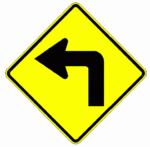 |
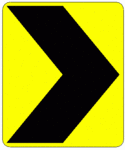 |
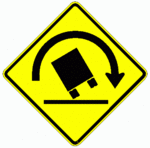 |
903.6.1 Function of Warning Signs (MUTCD Section 2C.01)
Support. Warning signs call attention to unexpected conditions on or adjacent to a highway, street or private road open to public travel and to situations that might not be readily apparent to road users. Warning signs alert road users to conditions that might call for a reduction of speed or an action in the interest of safety and efficient traffic operations.
903.6.2 Application of Warning Signs (MUTCD Section 2C.02)
Standard. The use of warning signs shall be based on an engineering study or on engineering judgment.
Guidance. The use of warning signs should be kept to a minimum as the unnecessary use of warning signs tends to increase disrespect for all signs. In situations where the condition or activity is seasonal or temporary, the warning sign should be removed or covered when the condition or activity does not exist.
Option. Consistent with the provisions of the EPG, Changeable Message signs may be used to display a warning message. Consistent with the provisions of EPG 903.2.17, a Warning Beacon may be used in combination with a standard warning sign.
Support. The categories of Warning signs are shown in Table 903.6.2. Warning signs provided in EPG 903 cover most of the conditions that are likely to be encountered. Additional warning signs for temporary traffic control zones, school areas, grade crossings, and bicycle facilities are discussed in EPG 903.18 Signing for School Areas, EPG 903.20 Signing for Rail and Light Rail Transit Grade Crossings, and EPG 903.21 Signing for Bicycle Facilities.
Option. Word message warning signs other than those specified in this article may be developed and installed.
Table 903.6.2 Categories of Warning Signs and Plaques
| Category | Group | EPG Article | Signs or Plaques | Sign Numbers |
|---|---|---|---|---|
| Roadway Related | Changes in Horizontal Alignment | 903.6.7 | Turn, Curve, Reverse Turn, Reverse Curve, Winding Road, Hairpin Curve | W1-1, 2, 3, 4, 5, 11, 15 |
| 903.6.46 | Advisory Speed | W13-1P | ||
| 903.6.11 | Chevron Alignment | W1-8 | ||
| 903.6.8 | Combination Horizontal Alignment/Advisory Speed | W1-1a, 2a | ||
| 903.6.9 | Combination Horizontal Alignment/Intersection | W1-10, 10a, 10b, 10c, 10d | ||
| 903.6.10 | Large Arrow (one direction) | W1-6 | ||
| 903.6.12 | Truck Rollover | W1-13 | ||
| 903.6.36 | Advisory Exit or Ramp Speed | W13-2, 3 | ||
| Vertical Alignment | 903.6.13 | Hill | W7-1, 1a, 2P, 2bP, 3P, 3aP, 3bP | |
| Cross-Section | 903.6.15 | Road Narrows | W5-1 | |
| 903.6.16, 903.6.17 | Narrow Bridge, One Lane Bridge | W5-2, 3 | ||
| 903.6.18 - 903.6.20 | Divided Highway, Divided Highway Ends, Double Arrow | W6-1, 2; W12-1 | ||
| 903.6.21 | Dead End, No Outlet | W14-1, 1a, 2, 2a | ||
| 903.6.22 | Low Clearance | W12-2, 2a | ||
| Roadway Surface Condition | 903.6.23 | Bump, Dip | W8-1, 2 | |
| 903.6.24 | Pavement Ends | W8-3 | ||
| 903.6.25 | Soft Shoulder | W8-4 | ||
| 903.6.26, 903.6.27 | Slippery When Wet, Fallen Rocks | W8-5, 20 | ||
| Weather | 903.6.52 | Road May Flood, Flood Gauge, Gusty Winds Area, Fog Area | W8-18, 19, 21, 22 | |
| Traffic Related | Advance Traffic Control | 903.6.28 - 903.6.30 | Stop Ahead, Yield Ahead, Signal Ahead, Be Prepared To Stop, Speed Reduction, Ramp Meter Ahead | W3-1,
2, 3, 4, 5, 5a, 6, 7, 8 |
| Traffic Flow | 903.6.31 - 903.6.36 | Merge, No Merge Area, Lane Ends, Added Lane, Two-Way Traffic, Right Lane Exit Only Ahead, No Passing Zone, Advisory Exit and Ramp Speed | W4-1, 2, 3, 5, 5P, 6; W6-3;W9-1, 2, 7; W14-3 | |
| Intersections | 903.6.37 | Crossroad, Side Road, T, Y, Circular Intersection, Side Roads | W2-1, 2, 3, 4, 5, 6, 7, 8; W16-12P, 17P | |
| 903.6.38 | Large Arrow (two direction) | W1-7 | ||
| 903.6.39 | Oncoming Extended Green | W25-1, 2 | ||
| Vehicular Traffic | 903.6.40 | Truck, Emergency Vehicle, Tractor, Bicycle, Golf Cart, Horse-Drawn Vehicle, Trail Crossing | W8-6; W11-1, 5, 5a, 8, 10, 11, 12P, 14, 15, 15P, 15a; W16-13P | |
| Non-Vehicular | 903.6.41 | Pedestrian, Deer, Cattle, Snowmobile, Equestrian, Wheelchair, Large Animals | W11-2, 3, 4, 6, 7, 9, 16, 17, 18, 19, 20, 21, 22; W16-13P | |
| Other Supplemental Plaques | Location | 903.6.41 | Downward Diagonal Arrow, Ahead | W16-7P, 9P |
| Distance | 903.6.45 | XX Feet, XX Miles, Next XX Feet, Next XX Miles | W7-3aP; W16-2P, 2aP, 3P, 3aP, 4P | |
| Arrow | 903.6.47 | Advance Arrow, Directional Arrow | W16-5P, 6P | |
| Street Name Plaque | 903.6.48 | Advance Street Name | W16-8P, 8aP | |
| Intersection | 903.6.49 | Cross Traffic Does Not Stop | W4-4P, 4aP, 4bP | |
| Share The Road | 903.6.50 | Share The Road | W16-1P | |
| Photo Enforced | 903.6.51 | Photo Enforced | W16-10P, 10aP |
903.6.3 Design of Warning Signs (MUTCD Section 2C.03)
Standard. Except as provided below or unless specifically designated otherwise, all warning signs shall be diamond-shaped (square with one diagonal vertical) with a black legend and border on a fluorescent yellow background. Warning signs shall be designed in accordance with the sizes, shapes, colors and legends contained in the Standard Highway Signs and Markings book.
Option. A warning sign that is larger than the size shown in the Oversized column in Table 903.6.3 for that particular sign may be diamond-shaped or may be rectangular or square in shape. Warning signs regarding conditions associated with pedestrians, bicyclists and playgrounds may have a black legend and border on a fluorescent yellow background.
Standard. Warning signs regarding conditions associated with school buses and schools and their related supplemental plaques shall have a black legend and border on a fluorescent yellow-green background (see EPG 903.18.9).
Table 903.6.3 Warning Sign and Plaque Sizes
| Sign or Plaque | Sign Designation | EPG Article | Conventional Road (in. x in.) | Freeway/Expressway (in. x in.) | ||
|---|---|---|---|---|---|---|
| Single Lane | Multi-Lane | Oversized | Mainline & Ramps | |||
| Turn | W1-1 | 903.6.7 | 36 X 36 | 36 X 36 | 48 X 48 | 48 X 48 |
| Curve | W1-2 | 903.6.7 | 36 X 36 | 36 X 36 | 48 X 48 | 48 X 48 |
| Reverse Turn | W1-3 | 903.6.7 | 36 X 36 | 36 X 36 | 48 X 48 | 48 X 48 |
| Reverse Curve | W1-4 | 903.6.7 | 36 X 36 | 36 X 36 | 48 X 48 | 48 X 48 |
| Winding Road | W1-5 | 903.6.7 | 36 X 36 | 36 X 36 | 48 X 48 | 48 X 48 |
| Hairpin Curve | W1-11 | 903.6.7 | 36 X 36 | 36 X 36 | 48 X 48 | 48 X 48 |
| 270° Curve | W1-15 | 903.6.7 | 36 X 36 | 36 X 36 | 48 X 48 | 48 X 48 |
| Double Reverse Curve Left | W24-1L | 903.6.7 | 36 X 36 | 36 X 36 | 48 X 48 | 48 X 48 |
| ALL LANES | W24-1cP | 903.6.7 | - | 24 X 18 | 36 X 24 | 36 X 24 |
| Combination Turn/Advisory Speed | W1-1a | 903.6.8 | 36 X 36 | 36 X 36 | 48 X 48 | 48 X 48 |
| Combination Curve/Advisory Speed | W1-2a | 903.6.8 | 36 X 36 | 36 X 36 | 48 X 48 | 48 X 48 |
| Combination Horizontal Alignment/Intersection | W1-10 | 903.6.9 | 36 X 36 | 36 X 36 | 48 X 48 | 48 X 48 |
| One-Direction Large Arrow | W1-6 | 903.6.10 | 48 X 24 | 48 X 24 | 72 X 36 | 72 X 36 |
| Chevron | W1-8 | 903.6.11 | 18 X 24 | 18 X 24 | 30 X 36 | 30 X 36 |
| Truck Rollover | W1-13 | 903.6.12 | - | - | - | 48 X 48 |
| Hill | W7-1 | 903.6.13 | 36 X 36 | 36 X 36 | 48 X 48 | 48 X 48 |
| ROAD NARROWS | W5-1 | 903.6.15 | 36 X 36 | 36 X 36 | 48 X 48 | 48 X 48 |
| NARROW BRIDGE | W5-2 | 903.6.16 | 36 X 36 | 36 X 36 | 48 X 48 | 48 X 48 |
| ONE LANE BRIDGE | W5-3 | 903.6.17 | 36 X 36 | 36 X 36 | 48 X 48 | 48 X 48 |
| Divided Highway | W6-1 | 903.6.18 | 36 X 36 | 36 X 36 | 48 X 48 | 48 X 48 |
| Divided Highway Ends | W6-2 | 903.6.19 | 36 X 36 | 36 X 36 | 48 X 48 | 48 X 48 |
| Double Down Arrow | W12-1 | 903.6.20 | 30 X 30 | 36 X 36 | 36 X 36 | - |
| DEAD END | W14-1 | 903.6.20 | 36 X 36 | 36 X 36 | 36 X 36 | 36 X 36 |
| NO OUTLET | W14-2 | 903.6.20 | 36 X 36 | 36 X 36 | 36 X 36 | 36 X 36 |
| ROAD ENDS | W14-13 | 903.6.20 | 36 X 36 | 36 X 36 | 36 X 36 | 36 X 36 |
| Low Clearance | W12-2 | 903.6.22 | 36 X 36 | 36 X 36 | 48 X 48 | 48 X 48 |
| LOW CLEARNACE (overhead) | W12-2a | 903.6.22 | - | - | - | 84 X 24 |
| PAVEMENT ENDS | W8-3 | 903.6.24 | 36 X 36 | 36 X 36 | - | - |
| SOFT SHOULDER | W8-4 | 903.6.25 | 36 X 36 | 36 X 36 | 48 X 48 | 48 X 48 |
| FALLEN ROCK | W8-14 | 903.6.27 | 36 X 36 | 36 X 36 | 48 X 48 | 48 X 48 |
| Stop Ahead | W3-1 | 903.6.28 | 36 X 36 | 36 X 36 | 48 X 48 | 48 X 48 |
| Yield Ahead | W3-2 | 903.6.28 | 36 X 36 | 36 X 36 | 48 X 48 | 48 X 48 |
| Signal Ahead | W3-3 | 903.6.28 | 36 X 36 | 36 X 36 | 48 X 48 | 48 X 48 |
| BE PREPARED TO STOP | W3-4 | 903.6.28 | 36 X 36 | 36 X 36 | 48 X 48 | 48 X 48 |
| Ramp Meter Ahead | W3-7 | 903.6.29 | 36 X 36 | 36 X 36 | - | - |
| Ramp Meter When Flashing | W3-8 | 903.6.29 | 36 X 36 | 36 X 36 | - | - |
| Reduced Speed Ahead | W3-5 | 903.6.30 | 36 X 36 | 36 X 36 | 48 X 48 | 48 X 48 |
| Merge | W4-1 | 903.6.31 | 36 X 36 | 36 X 36 | 48 X 48 | 48 X 48 |
| Entering Roadway Merge | W4-5 | 903.6.31 | 36 X 36 | 36 X 36 | 48 X 48 | 48 X 48 |
| Added Lane | W4-3 | 903.6.32 | 36 X 36 | 36 X 36 | 48 X 48 | 48 X 48 |
| Entering Roadway Added Lane | W4-6 | 903.6.32 | 36 X 36 | 36 X 36 | 48 X 48 | 48 X 48 |
| Lane Ends | W4-2 | 903.6.33 | 36 X 36 | 36 X 36 | 48 X 48 | 48 X 48 |
| Left (Right) Lane Ends | W9-1 | 903.6.33 | 36 X 36 | 36 X 36 | 48 X 48 | 48 X 48 |
| Lane Ends Merge Left (Right) | W9-2 | 903.6.33 | 36 X 36 | 36 X 36 | 48 X 48 | 48 X 48 |
| Two-Way Traffic | W6-3 | 903.6.34 | 36 X 36 | 36 X 36 | 48 X 48 | 48 X 48 |
| NO PASSING ZONE (pennant) | W14-3 | 903.6.35 | 48 X 30 | - | - | - |
| Advisory Exit Speed | W13-2 | 903.6.36 | - | - | - | 48 X 60 |
| Advisory Ramp Speed | W13-3 | 903.6.36 | - | - | - | 48 X 60 |
| Crossroad | W2-1 | 903.6.37 | 36 X 36 | 36 X 36 | 48 X 48 | 48 X 48 |
| Side Road | W2-2 | 903.6.37 | 36 X 36 | 36 X 36 | 48 X 48 | 48 X 48 |
| Side Road (45°) | W2-3 | 903.6.37 | 36 X 36 | 36 X 36 | 48 X 48 | 48 X 48 |
| T Intersection | W2-4 | 903.6.37 | 36 X 36 | 36 X 36 | 48 X 48 | 48 X 48 |
| Y Intersection | W2-5 | 903.6.37 | 36 X 36 | 36 X 36 | 48 X 48 | 48 X 48 |
| Circular Intersection | W2-6 | 903.6.37 | 36 X 36 | 36 X 36 | 48 X 48 | 48 X 48 |
| Two-Direction Large Arrow | W1-7 | 903.6.38 | 48 X 24 | 48 X 24 | 72 X 36 | 72 X 36 |
| TRAFFIC SIGNAL HAS EXTENDED GREEN | W25-1 | 903.6.39 | 24 X 30 | 24 X 30 | - | - |
| TRAFFIC SIGNAL MAY HAVE EXTENDED GREEN | W25-2 | 903.6.39 | 24 X 30 | 24 X 30 | - | - |
| Bicycle | W11-1 | 903.6.40 | 36 X 36 | 36 X 36 | - | - |
| Farm Vehicle | W11-5 | 903.6.40 | 36 X 36 | 36 X 36 | 48 X 48 | 48 X 48 |
| Emergency Vehicle | W11-8 | 903.6.40 | 36 X 36 | 36 X 36 | 48 X 48 | 48 X 48 |
| Truck | W11-10 | 903.6.40 | 36 X 36 | 36 X 36 | 48 X 48 | 48 X 48 |
| Horse-Drawn Vehicle | W11-14 | 903.6.40 | 36 X 36 | 36 X 36 | 48 X 48 | 48 X 48 |
| Pedestrian | W11-2 | 903.6.41 | 36 X 36 | 48 x 48 | 48 X 48 | - |
| Downward Diagonal Arrow | W16-7P | 903.6.41 | 30 X 18 | 30 X 18 | 30 X 18 | 30 X 18 |
| Deer | W11-3 | 903.6.41 | 36 X 36 | 36 X 36 | 48 X 48 | 48 X 48 |
| Cattle | W11-4 | 903.6.41 | 36 X 36 | 36 X 36 | - | - |
| Equestrian | W11-7 | 903.6.41 | 36 X 36 | 36 X 36 | - | - |
| Pedestrian on Bridge | W11-33 | 903.6.41 | 36 X 36 | 36 X 36 | 48 X 48 | 48 X 48 |
| FERRY CROSSING AHEAD | W3-18 | 903.6.42 | 36 X 36 | 36 X 36 | 48 X 48 | 48 X 48 |
| _ FEET | W16-2P | 903.6.45 | 24 X 18 | 24 X 18 | 30 X 24 | 30 X 24 |
| _ MILES | W16-3P | 903.6.45 | 24 X 18 | 24 X 18 | 30 X 24 | 30 X 24 |
| NEXT _ FEET | W16-4P | 903.6.45 | 30 X 24 | 30 X 24 | 30 X 24 | 30 X 24 |
| NEXT _ MILES | W7-3aP | 903.6.45 | 24 X 18 | 24 X 18 | 30 X 24 | 30 X 24 |
| Advisory Speed | W13-1P | 903.6.46 | 24 X 24 | 24 X 24 | 30 X 30 | 30 X 30 |
| Directional Arrow | W16-5P | 903.6.47 | 24 X 18 | 24 X 18 | 30 X 24 | 30 X 24 |
| Advance Turn Arrow | W16-6P | 903.6.47 | 24 X 18 | 24 X 18 | 30 X 24 | 30 X 24 |
| Percent Grade | W7-3P | 903.6.14 | 24 X 18 | 24 X 18 | 30 X 24 | 30 X 24 |
| Advance Street Name | W16-8P | 903.6.48 | Varies X 15 | Varies X 15 | Varies X 15 | Varies X 15 |
| CROSS TRAFFIC DOES NOT STOP | W4-4P | 903.6.49 | 24 X 12 | 24 X 12 | 36 X 18 | 36 X 18 |
| CROSS TRAFFIC FROM LEFT DOES NOT STOP | W4-4aPL | 903.6.49 | 24x12 | 24x12 | 36 X 18 | 36 X 18 |
| CROSS TRAFFIC FROM RIGHT DOES NOT STOP | W4-4aPR | 903.6.49 | 24x12 | 24x12 | 36 X 18 | 36 X 18 |
| ONCOMING TRAFFIC DOES NOT STOP | W4-4bP | 903.6.49 | 24x12 | 24x12 | 36 X 18 | 36 X 18 |
| SHARE THE ROAD | W16-1P | 903.6.50 | 24 X 30 | 24 X 30 | - | 24 X 30 |
| PHOTO ENFORCED | W16-10aP | 903.6.51 | 36 X 24 | 36 X 24 | - | - |
| WATER OVER ROAD | W8-33 | - | 36 X 36 | 36 X 36 | 48 X 48 | 48 X 48 |
| IMPASSABLE DURING HIGH WATER | W8-34 | 903.6.52 | 36 X 36 | 36 X 36 | 48 X 48 | 48 X 48 |
| LOW WATER CROSSING | W8-35 | 903.6.52 | 36 X 36 | 36 X 36 | - | - |
| Water Gauge | W8-19 | 903.6.52 | 12 X 72 | 12 X 72 | - | - |
| Passing Lane | W6-6a | 903.6.56 | 36 X 36 | 36 X 36 | - | - |
| PASSING LANE | W6-6aP | 903.6.56 | 42 X 12 | 42 X 12 | - | - |
| PASSING LANE ENDS | W6-16 | 903.6.56 | 36 X 36 | 36 X 36 | - | - |
| WATCH FOR LEFT-TURNING TRAFFIC IN PASSING LANE | W6-17 | 903.6.56 | 72 X 48 | 72 X 48 | - | - |
| TRAVEL SAFE ZONE | W26-1 | 903.6.57 | 36 X 48 | 36 X 48 | 48 X 60 | 48 X 60 |
903.6.4 Size of Warning Signs (MUTCD Section 2C.04)
Standard. Except as provided in EPG 903.2.13, the sizes for warning plaques shall be as shown in Table 903.6.4.
Table 903.6.4, Minimum Size of Supplemental Warning Plaques
| Size of Warning Sign (in. x in.) | Size of Supplemental Plaque (in. x in.) | |||
|---|---|---|---|---|
| Rectangular | Square | |||
| 1 Line | 2 Lines | Arrow | ||
| 36 X 36 | 30 X18 | 30 X 24 | 30 X 18 | 24 X 24 |
| 48 X 48 | ||||
Option. Larger sizes may be used for those special applications where speed, volume or other factors result in conditions where increased emphasis, improved recognition or increased legibility would be desirable.
Signs larger than those shown in Table 903.6.3 may be used with the approval of the State Highway Safety and Traffic Engineer.
Guidance. The minimum size for all diamond-shaped warning signs facing traffic on exit and entrance ramps should be the same size sign as the mainline roadway classification.
903.6.5 Sight Distance
Support. The decision to use most warning signs is based on prevailing conditions. The items to be considered when determining the need for a warning sign are sight distance and prevailing speed. Prevailing speed is determined by using either the posted or 85th percentile speed on the facility. Sight distance is the distance a driver requires to perceive, react, and respond to a condition. The prevailing speed affects the amount of sight distance required for a condition.
It is a recommended to use Table 903.6.5 to determine the sight distance needed when considering the use of most warning signs. If the sight distance is less than that in Table 903.6.5, a sign may be needed.
Table 903.6.5 Sight Distance Requirements
| Prevailing Speed (mph) | Distance (ft.) |
|---|---|
| 30 | 200 |
| 35 | 250 |
| 40 | 305 |
| 45 | 360 |
| 50 | 425 |
| 55 | 495 |
| 60 | 570 |
| 65 | 645 |
| 70 | 730 |
| Note: Based on the AASHTO Green Book, 2001 Edition, Exhibit 3-1 | |
903.6.6 Placement of Warning Signs (MUTCD Section 2C.05)
Support. For information on placement of warning signs, see EPG 903.3 and EPG 903.4.
The time needed for detection, recognition, decision, and reaction is called the Perception-Response Time (PRT).
Table 903.6.6 is provided as an aid for determining warning sign location. The distances shown in Table 903.6.6 can be adjusted for roadway features, other signing and to improve visibility.
Standard. The minimum visibility for warning signs shall be determined from Table 903.6.6.
Guidance. Warning signs should be placed so that they provide an adequate PRT. The distances contained in Table 903.6.6 are for guidance purposes and should be applied with engineering judgment. Warning signs are not to be placed so far in advance of the condition that drivers tend to forget the warning because of other driving distractions, especially in urban areas.
Minimum spacing between warning signs with different messages should be based on the estimated PRT for driver comprehension of and reaction to the second sign. If an adjustment is necessary, every effort should be made to make it as small as possible.
The effectiveness of the placement of warning signs should be periodically evaluated. This is typically accomplished during routine sign inspection cycles.
Standard. When any part of a warning sign assembly (post, sign, plaque, etc.) is replaced, maintained or modified, the placement of the sign shall be reviewed based on the Table 903.6.6. Additionally, mounting height shall be reviewed for conformance with EPG 903.3.3 Mounting Height.
Option. Warning signs that advise road users about conditions that are not related to a specific location, such as Non-Vehicle signs or SOFT SHOULDER, may be installed in an appropriate location, based on engineering judgment, since they are not covered in Table 903.6.6.
Table 903.6.6 Guidelines for Advance Placement of Warning Sign
| Posted or 85th Percentile Speed | Advance Placement Distance1 | ||||||||
|---|---|---|---|---|---|---|---|---|---|
| Condition A: Speed reduction and lane changing in heavy traffic2 | Condition B: Deceleration to the listed advisory speed (mph) for the condition | ||||||||
| 03 | 104 | 204 | 304 | 404 | 504 | 604 | 704 | ||
| 20 mph | 225 ft. | 100 ft.6 | N/A5 | - | - | - | - | - | - |
| 25 mph | 325 ft. | 100 ft.6 | N/A5 | N/A5 | - | - | - | - | - |
| 30 mph | 460 ft. | 100 ft.6 | N/A5 | N/A5 | - | - | - | - | - |
| 35 mph | 565 ft. | 100 ft.6 | N/A5 | N/A5 | N/A5 | - | - | - | - |
| 40 mph | 670 ft. | 125 ft. | 100 ft.6 | 100 ft.6 | N/A5 | - | - | - | - |
| 45 mph | 775 ft. | 175 ft. | 125 ft. | 100 ft.6 | 100 ft.6 | N/A5 | - | - | - |
| 50 mph | 885 ft. | 250 ft. | 200 ft. | 175 ft. | 125 ft. | 100 ft.6 | - | - | - |
| 55 mph | 990 ft. | 325 ft. | 275 ft. | 225 ft. | 200 ft. | 125 ft. | N/A5 | - | - |
| 60 mph | 1100 ft. | 400 ft. | 350 ft. | 325 ft. | 275 ft. | 200 ft. | 100 ft.6 | - | - |
| 65 mph | 1200 ft. | 475 ft. | 450 ft. | 400 ft. | 350 ft. | 275 ft. | 200 ft. | 100 ft.6 | - |
| 70 mph | 1250 ft. | 550 ft. | 525 ft. | 500 ft. | 450 ft. | 375 ft. | 275 ft. | 150 ft. | - |
| 75 mph | 1350 ft. | 650 ft. | 625 ft. | 600 ft. | 550 ft. | 475 ft. | 375 ft. | 250 ft. | 100 ft.6 |
| Notes:
1 The distances are adjusted for a sign legibility distance of 180 ft. for Condition A. The distances for Condition B have been adjusted for a sign legibility distance of 250 ft., which is appropriate for an alignment warning symbol sign. For Conditions A and B, warning signs with less than 6 in. legend or more than four words, a minimum of 100 ft. should be added to the advance placement distance to provide adequate legibility of the warning sign. 2 Typical conditions are locations where the road user must use extra time to adjust speed and change lanes in heavy traffic because of a complex driving situation. Typical signs are Merge and Right Lane Ends. The distances are determined by providing the driver a PRT of 14.0 to 14.5 seconds for vehicle maneuvers (2005 AASHTO Policy, Exhibit 3-3, Decision Sight Distance, Avoidance Maneuver E) minus the legibility distance of 180 ft. for the appropriate sign. 3 Typical condition is the warning of a potential stop situation. Typical signs are Stop Ahead, Yield Ahead, Signal Ahead, and Intersection Warning signs. The distances are based on the 2004 AASHTO Policy, Exhibit 3-1, Stopping Sight Distance, providing a PRT of 2.5 seconds, a deceleration rate of 11.2 ft./sec2, minus the sign legibility distance of 180 feet. 4 Typical conditions are locations where the road user must decrease speed to maneuver through the warned condition. Typical signs are Turn, Curve, Reverse Turn, or Reverse Curve. The distance is determined by providing a 2.5 second PRT, a vehicle deceleration rate of 10 ft./sec2, minus the sign legibility distance of 250 feet. 5 No suggested distances are provided for these speeds, as the placement location is dependent on site conditions and other signing. An alignment warning sign may be placed anywhere from the point of curvature up to 100 ft. in advance of the curve. However, the alignment warning sign should be installed in advance of the curve and at least 100 ft. from any signs. 6 The minimum advance placement distance is listed as 100 ft. to provide adequate spacing between signs. | |||||||||
903.6.7 Horizontal Alignment Signs (W1-1 through W1-5, W1-11, W1-15, W24-1L, W24-1cP) (MUTCD Section 2C.07)
 |
 |
 |
 |
 |
 |
 |
 |
Support. A variety of horizontal alignment warning signs, pavement markings, and delineation can be used to advise motorists of a change in the roadway alignment. Uniform application of these traffic control devices with respect to the amount of change in the roadway alignment conveys a consistent message establishing driver expectancy and promoting effective roadway operations. The design and application of horizontal alignment warning signs to meet those requirements are addressed in EPG 903.6.7.1 through 903.6.7.6.
Standard. All horizontal alignment signs shall have an Advisory Speed Supplemental Plaque (W13-1P) mounted below the primary warning when the difference between the posted speed limit and the advisory speed is 5 mph or greater. See EPG 903.6.46 for additional guidance on the application of the Advisory Speed Supplemental Plaque (W13-1P).
Option. If engineering judgment indicates the need for the horizontal alignment sign for a curve that can be driven at or above the posted speed limit, horizontal alignment signs may be installed with the Advisory Speed Supplemental Plaque (W13-1P) displaying an advisory speed equal to the posted speed limit.
903.6.7.1 Turn and Curve Signs (W1-1, W1-2)
Standard. A Curve sign (W1-2) shall be used when the difference between the speed limit and advisory speed is 5 mph or greater, unless a different sign is recommended or allowed. A Turn sign (W1-1) shall be used instead of a Curve sign in advance of curves that have advisory speeds of 30 mph or less.
903.6.7.2 Reverse Turn and Reverse Curve Signs (W1-3, W1-4)
Guidance. Where there are two changes in roadway alignment in opposite directions that are separated by a tangent distance of less than 600 ft., the Reverse Turn (W1-3) sign should be used instead of multiple Turn (W1-1) signs and the Reverse Curve (W1-4) sign should be used instead of multiple Curve (W1-2) signs.
903.6.7.3 Winding Road Sign (W1-5)
Option. A Winding Road (W1-5) sign may be used instead of multiple Turn (W1-1) or Curve (W1-2) signs where there are three or more changes in roadway alignment each separated by a tangent distance of less than 600 feet.
A NEXT XX MILES (W7-3aP) supplemental distance plaque may be installed below the Winding Road sign where continuous roadway curves exist for a specific distance.
903.6.7.4 Hairpin Curve (W1-11) and 270-Loop Signs (W1-15)
Option. If the curve has a change in horizontal alignment of 135 degrees or more, the Hairpin Curve (W1-11) sign may be used instead of a Curve or Turn sign.
If the curve has a change of direction of approximately 270 degrees, such as on a cloverleaf interchange ramp, the 270-degree Loop (W1-15) sign may be used instead of a Curve or Turn sign. Guidance. When the Hairpin Curve sign or the 270-degree Loop sign is installed, either a One-Direction Large Arrow (W1-6) sign or Chevron Alignment (W1-8) signs should be installed on the outside of the turn or curve.
903.6.7.5 Double Reverse Curve Left Sign (W24-1L) – Diverging Diamond Interchange (DDI) Application
Standard. A double reverse curve left sign (W24-1L) shall be used on the crossroad approaches to a DDI when the difference between the speed limit and advisory speed for the DDI is 5 mph or greater.
903.6.7.6 ALL LANES Supplemental Plaque (W24-1cP) – Diverging Diamond Interchange (DDI) Application
Standard. An ALL LANES supplemental plaque (W24-1cP) shall be placed below the double reverse curve left sign (W24-1L) for a diverging diamond interchange when there are two or more lanes in the direction the sign references.
Table 903.6.7 Horizontal Alignment Sign Usage
| Number of Alignment Changes | Advisory Speed | |
|---|---|---|
| Less than or equal to 30 mph | Greater than 30 mph | |
| 1 | Turn (W1-1) | Curve (W1-2) |
| 21 | Reverse Turn (W1-3)2 | Reverse Curve (W1-4)2 |
| 3 or more1 | Winding Road (W1-5)2 | |
| Notes:
1 Alignment changes are in opposite directions and are separated by a tangent distance of 600 ft. or less. 2 A Right Reverse Turn (W1-3R), Right Reverse Curve (W1-4R) or Right Winding (W1-5R) sign is used if the first change in alignment is the right; a Left Reverse Turn (W1-3L), Left Reverse Curve (W1-4L) or Left Winding (W1-5L) sign is used if the first change in alignment is the left. | ||
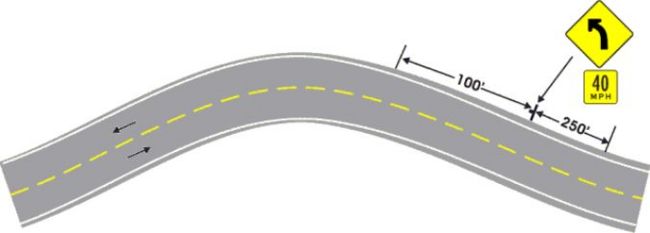
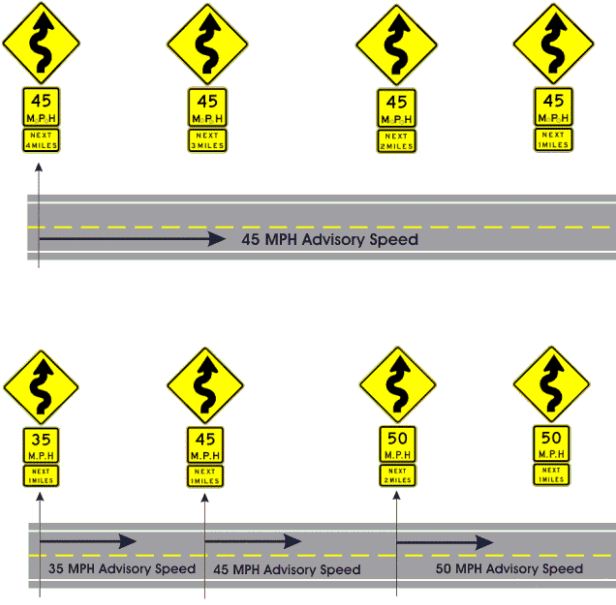
903.6.8 Combination Horizontal Alignment/Advisory Speed Sign (W1-1a, W1-2a) (MUTCD Section 2C.10)
 |
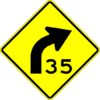 |
Option. The Turn (W1-1) sign or the Curve (W1-2) sign may be combined with the Advisory Speed (W13-1P) plaque (see EPG 903.6.45) to create a combination Turn/Advisory Speed (W1-1a) sign or combination Curve/Advisory Speed (W1-2a) sign.
The combination Horizontal Alignment/Advisory Speed sign may be used to supplement the advance Horizontal Alignment warning sign and Advisory Speed plaque based upon an engineering study.
Standard. If used, the combination Horizontal Alignment/Advisory Speed sign shall not be used alone and shall not be used as a substitute for a Horizontal Alignment warning sign and Advisory Speed sign, but shall only be used as a supplement to the advance Horizontal Alignment warning sign. If used, the combination Horizontal Alignment/Advisory Speed sign shall be installed at the beginning of the turn or curve and the speed displayed shall match the advisory speed below the Horizontal Alignment sign.
903.6.9 Combination Horizontal Alignment/Intersection Signs (W1-10 Series) (MUTCD Section 2C.11)
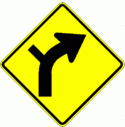
Option. The Turn (W1-1) sign or the Curve (W1-2) sign may be combined with the Cross Road (W2-1) sign or the Side Road (W2-2 or W2-3) sign to create a combination Horizontal Alignment/Intersection (W1-10 series) sign that depicts the condition where an intersection occurs within or immediately adjacent to a turn or curve.
Guidance. Elements of the combination Horizontal Alignment/Intersection sign related to horizontal alignment should comply with the provisions of EPG 903.6.7, Horizontal Alignment Signs, and elements related to intersection configuration should comply with the provisions of EPG 903.6.37 Intersection Warning Signs. The symbol design should approximate the configuration of the intersecting roadway(s). No more than one Cross Road or two Side Road symbols should be displayed on any one combination Horizontal Alignment/Intersection sign.
A layout of the proposed sign should be included when ordering.
Standard. If used, a Curve/Sideroad Left (W1-10L) sign shall indicate a curve to the left, while a Curve/Sideroad Right (W1-10R) sign shall indicate a curve to the right.
903.6.10 One-Direction Large Arrow Sign (W1-6) (MUTCD Section 2C.12)

Standard. The One-Direction Large Arrow sign shall be a horizontal rectangle with an arrow pointing to the left or right. The use of the One-Direction Large Arrow sign shall be in accordance with the information shown in Table 903.6.7. If used, the One-Direction Large Arrow sign shall be installed on the outside of a turn or curve in line with and at approximately a right angle to approaching traffic. The One-Direction Large Arrow sign shall not be used where there is no alignment change in the direction of travel, such as at the beginnings and ends of medians or at center piers. The One-Direction Large Arrow sign directing traffic to the right shall not be used in the central island of a roundabout.
A One-Direction Large Arrow (W1-6) sign shall be used to delineate a change in horizontal alignment where the advisory speed is 30 mph or lower for a turn or reverse turn. (See Fig. 903.6.10.)
Option. A One-Direction Large Arrow (W1-6) sign may be supplemented, or replaced with, Chevron Alignment signs to delineate a change in horizontal alignment of 30 mph or lower.
Guidance. If used, the One-Direction Large Arrow sign should be visible for a sufficient distance to provide the road user with adequate time to react to the change in alignment.
If chevrons are used to supplement the One-Direction Large Arrow sign, chevrons and arrow signs should be installed so they do not visually block each other. See Figure 903.6.10.
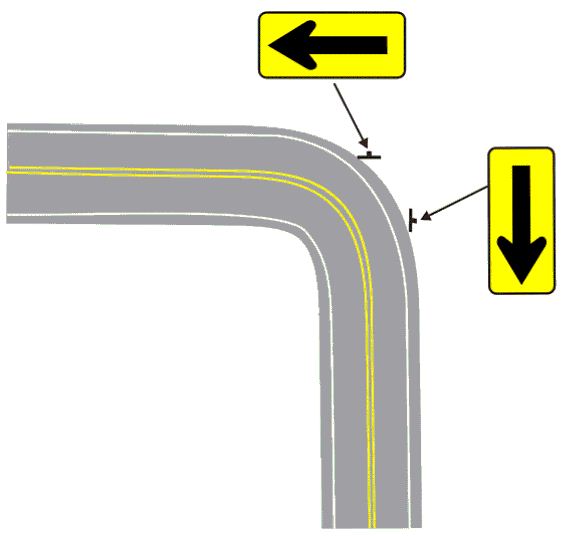
903.6.11 Chevron Alignment Sign (W1-8) (MUTCD Section 2C.09)

Support. Examples of when to use Chevron signs include locations where there is a crash history, evidence of drivers losing control on a curve or turn, a sharp change in alignment not readily visible to the driver, or as a systemic curve improvement program.
The majority of fatal and serious injury crashes are attributed to lane departure crashes (State Strategic Highway Safety Plan). Chevrons are a highly cost-effective way to reduce lane departure crashes in curves and turns.
Implementation of the 2009 MUTCD requirements for chevron deployments resulted in a statewide reduction in severe lane departure crashes in horizontal curves. To maintain this observed safety benefit, MoDOT has established standards based on the 2009 MUTCD criteria, which is above the minimum requirements in the 2023 edition of the MUTCD. For more details on the safety benefits of chevrons, contact the Highway Safety and Traffic Division.
Standard. The use of the Chevron Alignment (W1-8 series) sign to provide additional emphasis and guidance for a change in horizontal alignment shall be applied to roadways with 1,000 AADT or more, on curves where the difference between the advisory speed for the curve and the posted speed limit for the roadway is 15 mph or greater.
The Chevron Alignment sign shall be a vertical rectangle. No border shall be used on the Chevron Alignment sign. If used, Chevron Alignment signs shall be installed on the outside of a turn or curve, in line with and at approximately a right angle to approaching traffic. Chevron Alignment signs shall be installed at a minimum height of 4 feet, measured vertically from the bottom of the sign to the elevation of the near edge of the traveled way. This will place the sign at approximately the driver’s eye height.
Guidance. Based on engineering judgement, chevron alignment signs may be omitted within incorporated city limits.
As chevrons are installed, all horizontal alignment signing (chevrons, curve and turn signing, advisory speed plaques and arrow boards) on a corridor should be evaluated to assure their installations meet current standards. Aspects of existing horizontal alignment signs to look at can include spacing of existing chevrons, offset and mounting heights of any horizontal alignment sign as well as the distance advanced warning signs are installed from the curve/turn. The need for curve/turn signs could also be reevaluated if the ball banking these signs were installed under is out of date due to roadway/pavement improvements or simply the changes in vehicle performance.
Option. Chevron Alignment signs may also be used on any other roadways based on engineering judgment.
Chevron Alignment signs may be used instead of, or in addition to, the One-Direction Large Arrow (W1-6) sign on turns posted at 30 mph or less.
LEDs may be used to enhance the conspicuity of Chevron Alignment signs in accordance with EPG 903.2.9.
Guidance. The approximate spacing of Chevron Alignment signs on the turn or curve measured from the point of curvature (PC) should be as shown in Table 903.6.11. The Chevron Alignment signs should be visible for a sufficient distance to provide the road user with adequate time to react to the change in alignment. In addition to the Chevron Alignment signs placed throughout the curve, there shall be one sign in advance of the PC and one after the PT. These signs shall be spaced the same as the Chevron Alignment signs in the curve.
Table 903.6.11 should be used for determining spacing. The values in Table 903.6.11 are typical and variances for driveways, public roads, and other signs may alter the spacing. Engineering judgment may also be used to modify the spacing as long as travelers always have at least two Chevron Alignment signs in view until the change in alignment eliminates the need for the signs.
At the end of a divided highway, where the traffic reduces to two lanes, chevrons should be used to direct traffic from the dual lanes that are ending and being redirected to the two-lane roadway.
The single-sided Chevron sign side should only be used where only one direction of travel is impacted, such as on an expressway.
The double-side Chevron (W1-8D) should be used on two-lane, two-way roads.
Standard. If used, the LEDs used in the Chevron Alignment sign shall consist of yellow LEDs outlining the chevron symbol.
Chevron Alignment signs shall not be placed on the far side of a T-intersection facing traffic on the stem approach to warn drivers that a through movement is not physically possible, as this is the function of a Two-Direction (or One-Direction) Large Arrow sign. Chevron Alignment signs shall not be used to mark obstructions within or adjacent to the roadway, including the beginning of guardrails or barriers, as this is the function of an object marker.
Chevron Alignment signs directing traffic to the right shall not be used in the central island of a roundabout or a neighborhood traffic circle.
Table 903.6.11 Typical Spacing of Chevron Alignment Signs on Horizontal Curves
| Advisory Speed | Sign Spacing |
|---|---|
| 15 mph or less | 40 feet |
| 20 to 30 mph | 60 feet |
| 35 to 45 mph | 80 feet |
| 50 to 60 mph | 100 feet |
| More than 60 mph | 140 feet |
903.6.12 Truck Rollover Warning Sign (W1-13) (MUTCD Section 2C.13)
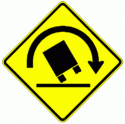
Option. A Truck Rollover Warning (W1-13) sign may be used to warn drivers of vehicles with a high center of gravity, such as trucks, tankers, and recreational vehicles of a curve or turn where geometric conditions might contribute to a loss of control and a rollover as determined by an engineering study.
Standard. If a Truck Rollover Warning (W1-13) sign is used, an Advisory Speed Plaque (W13-1P) plaque indicating the recommended speed for vehicles with a higher center of gravity shall accompany it.
Option. The Truck Rollover Warning sign may be displayed as a static sign, as a static sign supplemented by a flashing warning beacon, or as a changeable message sign activated by the detection of an approaching vehicle with a high center of gravity that is traveling in excess of the recommended speed for the condition.
The curved arrow on the Truck Rollover Warning sign shows the direction of roadway curvature. The truck tips in the opposite direction.
903.6.13 Hill Signs (W7-1) (MUTCD Section 2C.16)
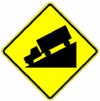 |
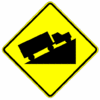 |
Guidance. The Hill (W7-1) sign should be used in advance of a downgrade where the length, percent of grade, horizontal curvature, and/or other physical features requires special precautions on the part of road users.
The Hill sign and supplemental grade (W7-3P) plaque (refer to EPG 903.6.14) used in combination should be installed in advance of downgrades for the following conditions:
A. 5% grade that is more than 3,000 ft. long;
B. 6% grade that is more than 2,000 ft. long;
C. 7% grade that is more than 1,000 ft. long;
D. 8% grade that is more than 750 ft. long;
E. 9% grade that is more than 500 ft. long;
F. 11% grade that is more than 400 ft. long;
G. 13% grade that is more than 300 ft. long;
H. 15% grade that is more than 200 ft. long; or
I. 16% or more grade that is any length.
These signs are also to be installed for steeper grades or where crash experience and field observations indicate a need or at grades of five percent or more where any part of the grade is on a curve sharper than four degrees.
Supplemental plaques (refer to EPG 903.6.14, below) and larger signs should be used for emphasis or where special hill characteristics exist. On longer grades, the use of the Hill sign with a distance (W7-3aP) plaque at periodic intervals of approximately 1 mile spacing should be considered.
Standard. If the percent grade is displayed on a supplemental plaque, the plaque shall be placed below the Hill (W7-1) sign.
Support. The Uphill (W7-1c) sign is also available by special request.
903.6.14 Hill-Related Supplemental Plaques (W7-3 Series) (MUTCD Section 2C.57)
 |
 |
Guidance. Hill-Related (W7-3 series) supplemental plaques or other appropriate legends and larger signs should be used for emphasis or where special hill characteristics exist. On longer grades, the use of the supplemental distance plaque (W7-3aP) at periodic intervals of approximately 1 mile spacing should be considered.
903.6.15 ROAD NARROWS Sign (W5-1) (MUTCD Section 2C.19)
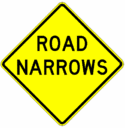
Guidance. Except as provided below, a ROAD NARROWS (W5-1) sign should be used in advance of a transition on two-lane roads where the pavement width is reduced abruptly to such a narrow width that vehicles traveling in opposite direction cannot simultaneously travel through the narrow portion of the roadway without reducing speed.
Option. The ROAD NARROWS (W5-1) sign may be omitted on low-volume local streets that have speed limits of 30 mph or less. Additional emphasis may be provided by the use of object markers and delineators. The Advisory Speed (W13-1) plaque may be used to indicate the recommended speed.
903.6.16 NARROW BRIDGE Sign (W5-2) (MUTCD Section 2C.20)
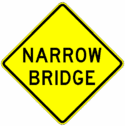
Guidance. A NARROW BRIDGE (W5-2) sign should be used in advance of any bridge or culvert having a two-way roadway clearance width of 16 ft. to 18 ft., or any bridge or culvert having a roadway narrower than the width of the approach travel lanes.
Additional emphasis should be provided by the use of object markers, delineators, and/or pavement markings.
Option. A NARROW BRIDGE sign may be used in advance of a bridge or culvert on which the approach shoulders are narrowed or eliminated.
903.6.17 ONE LANE BRIDGE Sign (W5-3) (MUTCD Section 2C.21)
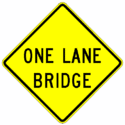
Guidance. A ONE LANE BRIDGE (W5-3) sign should be used on two-way roadways in advance of any bridge or culvert:
A. Having a clear roadway width of less than 16 ft.; or
B. Having a clear roadway width of less than 18 ft. when commercial vehicles constitute a high proportion of the traffic; or
C. Having a clear roadway width of 18 ft. or less where the sight distance is limited on the approach to the structure.
Additional emphasis should be provided by the use of object markers, delineators, and/or pavement markings.
903.6.18 Divided Highway Sign (W6-1) (MUTCD Section 2C.22)
 |
Guidance. A Divided Highway (W6-1) sign should be used on the approaches to a section of highway (not an intersection or junction) where the opposing flows of traffic are separated by a median or other physical barrier.
Standard. DIVIDED HIGHWAY supplemental plaque (W6-1c) has been discontinued. MoDOT shall no longer provide DIVIDED HIGHWAY supplemental plaque (W6-1c). Existing DIVIDED HIGHWAY supplemental plaque (W6-1c) shall be left in place until they reach the end of their service life. The Divided Highway (W6-1) sign shall not be used instead of a Keep Right (R4-7 series) sign on the approach end of a median island.
903.6.19 Divided Highway Ends Sign (W6-2) (MUTCD Section 2C.23)
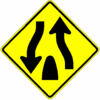 |
Guidance. A Divided Highway Ends (W6-2) sign should be used in advance of the end of a section of physically divided highway (not an intersection or junction) as a warning of two-way traffic ahead.
Standard. DIVIDED HIGHWAY ENDS supplemental plaque (W6-2c) has been discontinued. MoDOT shall no longer provide DIVIDED HIGHWAY ENDS supplemental plaque (W6-2c). Existing DIVIDED HIGHWAY ENDS supplemental plaque (W6-2c) shall be left in place until they reach the end of their service life.
903.6.20 Double Arrow Sign (W12-1) (MUTCD Section 2C.25)
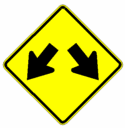
Option. The Double Arrow (W12-1) sign may be used to advise road users that traffic is permitted to pass on either side of an island, obstruction, or gore in the roadway (see Fig. 903.6.20). Traffic separated by this sign may either rejoin or change directions.
Guidance. If used on an island, the Double Arrow sign should be mounted near the approach end. If used in front of a pier or obstruction, the Double Arrow sign should be mounted on the face of, or just in front of, the obstruction. Where stripe markings are used on the obstruction, they should be discontinued to leave a 3 in. space around the outside of the sign.
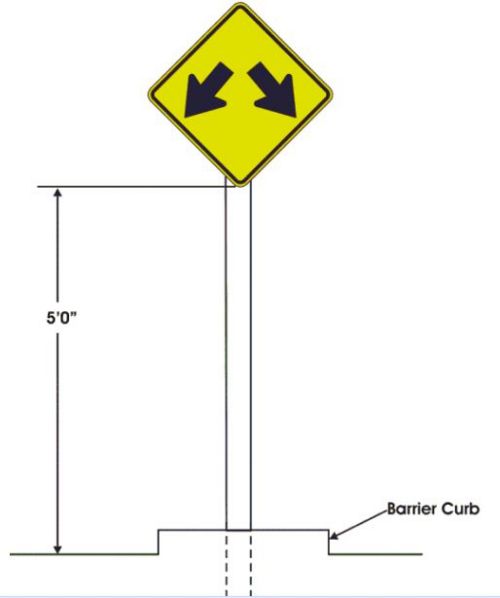
903.6.21 DEAD END, NO OUTLET, and ROAD ENDS Signs (W14-1, W14-2, W14-13) (MUTCD Section 2C.26)
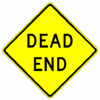 |
 |
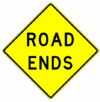 |
Option. The DEAD END (W14-1) sign may be used at the entrance of a single road or street that terminates in a dead end or cul-de-sac. The NO OUTLET (W14-2) sign may be used at the entrance to a road or road network from which there is no other exit in place of the DEAD END sign.
The ROAD ENDS (W14-13) sign may be used to warn of a roadway which has no outlet and which terminates in a dead end and may be used in place of the DEAD END or NO OUTLET sign where the use of the DEAD END and NO OUTLET signs would have a negative effect on traffic generators or public perceptions due to the negative connotation of the message.
Standard. When the W14-1, W14-2, or W14-13 sign is used, the sign shall be posted as near as practical to the entry point or at a sufficient advance distance to permit the road user to avoid the dead end or no outlet condition by turning off at the nearest intersecting street.
The DEAD END sign shall be placed at the appropriate distance from the end of the roadway.
The W14-2 or W14-13 sign shall not be used in place of the DEAD END sign at the end of the roadway.
The DEAD END sign shall be installed at the end of any state route that physically ends or ends at a private entrance.
The W14-1, W14-2, or W14-13 sign shall not be used in place of the ROAD CLOSED (R11-2) sign for temporary conditions, such as high water, bridge out, etc.
Guidance. The W14-1, W14-2, or W14-13 sign should be installed just beyond the entrance to all state-maintained roadways where this condition exists.
903.6.22 Low Clearance Sign (W12-2 and W12-2a) (MUTCD Section 2C.27)
 |
Standard. Low Clearance signing shall be installed to display vertical clearances available under structures within specified limits of statutory maximum vehicle heights. The clearance posted on the signs shall be 2 inches less than the measured clearance to account for possible packed snow and ice, for example, a measured vertical clearance of 15 ft. shall be posted as 14 ft. 10 in. All clearance measurements shall be rounded down to the nearest full inch, for example, a measured vertical clearance of 14 ft. 9 ½ in. would be rounded down to 14 ft. 9 in. and posted as 14 ft. 7 in. The statutory maximum vehicle heights and vertical clearances are as follows:
- Within Commercial Zones = 15 ft. statutory maximum vehicle height (16’ 0” maximum posting)
- On Interstate and designated highway network routes and on all routes within 10 miles of Interstate and designated highway network routes = 14 ft. statutory maximum vehicle height (15’ 0” maximum posting)
- On routes greater than 10 miles from Interstate and designated highway network routes = 13 ft. 6 in. statutory maximum vehicle height (15’ 0” maximum posting).
For specific details on commercial zone limits and designated highway network routes, see Missouri Vehicle Route Map (map inset).
Posting requirements for Low Clearance signs are as follows:
- Case I – Two Signs Required: Where the measured vertical clearance is 15 ft. 2 in. or less, but more than 13 ft. 8 in., two signs shall be used. First, the clearance shall be posted on the structure by an Overhead Low Clearance (W12-2a) sign and, second, a shoulder mounted Low Clearance (W12-2) sign shall be placed approximately 750 ft. in advance of the structure. When an interchange is involved, the shoulder-mounted Low Clearance (W12-2) sign shall be located approximately 750 ft. in advance of the off-ramp. The maximum vertical clearance shown on the signs under these conditions shall be 15 feet.
- Case II – Three Signs: Where the measured vertical clearance is 13 ft. 8 in. or less, three signs shall be used. First, the clearance shall be posted on the structure by an Overhead Low Clearance (W12-2a) sign, second, a shoulder mounted Low Clearance (W12-2) sign shall be placed approximately 750 ft. in advance of the structure, and third, an additional Low Clearance (W12-2) sign shall be placed at the nearest intersecting road or wide point in the road at which a vehicle can detour or turn around. The maximum height shown on the signs under these conditions shall be 13 ft. 6 inches.
- Case III – One Sign: Where the measured vertical clearance is 15 ft. 2 in. or less and where the bridge is state maintained but the road beneath is not, the Overhead Low Clearance (W12-2a) sign shall be mounted on the structure, but the shoulder mounted Low Clearance (W12-2) sign shall not be installed by MoDOT, but may be installed and maintained by the local jurisdiction.
- Case IV – Commercial Zones: Vertical clearance signing shall be provided for structures within commercial zones (see Missouri Statute 304.190). Any structure with a measured vertical clearance of 16 ft. 2 in. or less within the commercial zone limits shall be posted. The signing for measured vertical clearances greater than 15 ft. 2 in. and equal to or less than 16 ft. 2 in. within commercial zones shall be posted on the structure by an Overhead Low Clearance (W12-2a) sign. The signing for measured vertical clearances of 15 ft. 2 in. or less within commercial zones shall be the same as Case I and Case III.
Standard. The Overhead Low Clearance (W12-2a) sign should be mounted on a structure centered over the lane or lanes affected. The vertical clearance displayed on the sign shall represent the smallest vertical clearance for that span.
In the case of an arch structure or a structure which has a sloping span resulting in different vertical clearances per lane, one Overhead Low Clearance (W12-2a) sign shall be centered over each lane displaying the vertical clearance available for that lane. One sign per lane shall be applied if the difference in vertical clearance between adjacent lanes is 6 inches or greater or when the vertical clearance between the far right lane and far left lane is 12 inches or greater.
Option. When only one Overhead Low Clearance (W12-2a) sign is required and mounting one sign centered over the roadway is not practical the W12-2a sign may be double posted with one sign mounted to the right of the travel lanes and one sign mounted to the left of the travel lanes.
Guidance. Clearances should be evaluated periodically, particularly when resurfacing operations have occurred, to assure the displayed clearances are accurate and the information should be updated in TMS.
Standard. Low Clearance (W2-12b) sign has been discontinued. MoDOT shall no longer provide Low Clearance (W2-12b) signs. Existing Low Clearance (W2-12b) sign shall be left in place until they reach the end of their service life.
903.6.23 BUMP and DIP Signs (W8-1, W8-2) (MUTCD Section 2C.28)
Standard. The BUMP and DIP warning signs (W8-1, W8-2) are a limited use sign, only being used for locations where the condition is normal and cannot be corrected, such as low water crossings or rail road grade crossings. BUMP and DIP signs will be available as temporary traffic control signs (WO8-1, WO8-2) for locations where the condition is temporary and/or where the condition can be corrected in the future. Guidance can be found in EPG 616.6.50 Other Warning Signs.
903.6.24 PAVEMENT ENDS Sign (W8-3) (MUTCD Section 2C.30)
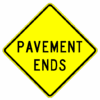
Guidance. A PAVEMENT ENDS (W8-3) word message sign should be used where a paved surface changes to either a gravel treated surface or an earth road surface.
903.6.25 SOFT SHOULDER Sign (W8-4) (MUTCD Section 2C.31)
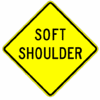
Option. The SOFT SHOULDER (W8-4) sign may be used to warn of a soft shoulder condition.
Guidance. Additional shoulder signs should be placed at appropriate intervals along the road where the condition continually exists.
Standard. When used, the SOFT SHOULDER sign shall be placed in advance of the condition. See Table 903.6.6.
903.6.26 Slippery When Wet Sign (W8-5) (MUTCD Section 2C.32)
Standard. Slippery When Wet warning (W8-5) signs are a limited use sign that should not be installed for locations where the condition can be corrected. Existing Slippery When Wet (W8-5) signs shall be left in place until the condition is corrected. Black on Orange Slippery When Wet Temporary Traffic Control signs (WO8-5) will be available to warn of this condition temporarily until the condition can be corrected. Guidance can be found in EPG 616.6.50 Other Warning Signs.
Option. Black on Yellow Slippery When Wet warning (W8-5) signs for special circumstances can be requested as a special from Central Office Highway Safety and Traffic.
903.6.27 FALLEN ROCKS Sign (W8-14) (MUTCD Section 2C.32)
Option. The FALLEN ROCKS (W8-14) sign may be used in advance of an area that is adjacent to a hillside, mountain, or cliff where rocks frequently fall onto the roadway.
Standard. The district shall perform an evaluation of the Fallen Rocks site to determine whether this sign is still necessary. If it is determined that Fallen Rocks is not an issue at the site, the sign will not be replaced at the end of the service life.
903.6.28 Advance Traffic Control Signs (W3-1, W3-2, W3-3, W3-4) (MUTCD Section 2C.36)
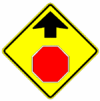 |
 |
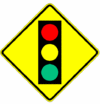 |
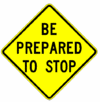 |
Standard. The Advance Traffic Control symbol signs include the Stop Ahead (W3-1), Yield Ahead (W3-2), and Signal Ahead (W3-3) signs. These signs shall be installed on an approach to a primary traffic control device that is not visible for a sufficient distance to permit the road user to respond to the device. The visibility criteria for a traffic control signal shall be based on having a continuous view of at least two signal faces for the distance specified in Table 903.6.6. The criteria for the STOP AHEAD (W3-1) and YIELD AHEAD (W3-2) are specified in Table 903.6.6. (See Fig. 903.6.28 for an example application.)
Support. Permanent obstructions causing the limited visibility might include roadway alignment or structures. Intermittent obstructions might include foliage or parked vehicles.
Guidance. Where intermittent obstructions occur, engineering judgment should determine the treatment to be implemented.
The minimum visibility distance of a signal for a facility with a speed limit above 60 mph should be determined by summing the stopping sight distance (see Table 903.6.5) and the assumed queue length. The assumed queue length should be determined by engineering judgment.
If an advance traffic control sign is warranted for an approach at an intersection of a MoDOT maintained road and non-MoDOT maintained road, the maintainer of the non-MoDOT road should be notified of the condition.
Option. An Advance Traffic Control sign may be used for additional emphasis of the primary traffic control device, even when the visibility distance to the device is satisfactory. An advance street name plaque (refer to EPG 903.6.48) may be installed below an Advance Traffic Control sign.
The Signal Ahead (W3-3) signs may be double posted on the right-hand and left-hand shoulders on a high speed divided approach.
A warning beacon may be used with an Advance Traffic Control sign.
A BE PREPARED TO STOP (W3-4) sign may be used to warn of stopped traffic caused by a traffic control signal or in advance of a section of roadway that regularly experiences traffic congestion.
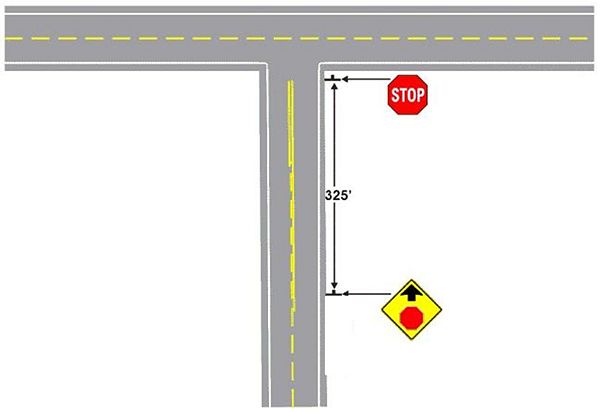
Standard. When a BE PREPARED TO STOP (W3-4) sign is used in advance of a traffic control signal, it shall be used in addition to a Signal Ahead (W3-3) sign and shall be placed downstream from the Signal Ahead (W3-3) sign.
Option. The BE PREPARED TO STOP (W3-4) sign may be supplemented with a warning beacon.
Guidance. When the warning beacon is interconnected with a traffic control signal or queue detection system, the BE PREPARED TO STOP sign should be supplemented with a WHEN FLASHING (W16-13P) plaque.
903.6.29 Advance Ramp Control Signal Signs (W3-7 and W3-8) (MUTCD Section 2C.37)
Option. A RAMP METER AHEAD (W3-7) sign may be used to warn road users that a freeway entrance ramp is metered and that they will encounter a ramp control signal.
Guidance. When the ramp control signals are operated only during certain periods of the day, a RAMP METERED WHEN FLASHING (W3-8) sign should be installed in advance of the ramp control signal near the entrance to the ramp, or on the arterial on the approach to the ramp, to alert road users to the presence and operation of ramp meters.
Standard. The RAMP METERED WHEN FLASHING sign shall be supplemented with a warning beacon that flashes when the ramp control signal is in operation.
903.6.30 Reduced Speed Limit Ahead Signs (W3-5) (MUTCD Section 2C.38)
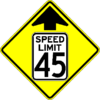
Standard. If used, Reduced Speed Limit Ahead signs shall be followed by a Speed Limit (R2-1) sign installed at the beginning of the zone where the speed limit applies.
The speed limit displayed on the Reduced Speed Limit Ahead sign shall be identical to the speed limit displayed on the subsequent Speed Limit sign.
Speed Reduction signs shall be installed in advance of a speed reduction of 15 mph or greater from the posted speed limit.
Option. Speed Reduction signs may be installed in advance of a speed reduction of 10 mph or less from the posted speed limit based on engineering judgement.
903.6.31 Merge Signs (W4-1, W4-5) (MUTCD Section 2C.40)
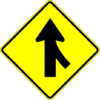 |
 |
Guidance. The Merge sign should be installed on the side of the major roadway where merging traffic will be encountered and in such a position as to not obstruct the road user’s view of entering traffic. Where two roadways of approximately equal importance converge, a Merge sign should be placed on each roadway. When a Merge sign is to be installed on an entering roadway that curves before merging with the major roadway, such as a ramp with a curving horizontal alignment as it approaches the major roadway, the Entering Roadway Merge (W4-5) sign should be used to better portray the actual geometric conditions to road users on the entering roadway. The Merge sign should not be used where two roadways converge and merging movements are not required. The Merge sign should not be used in place of a Lane Ends sign where lanes of traffic moving on a single roadway must merge because of a reduction in the actual or usable pavement width.
903.6.32 Added Lane Signs (W4-3, W4-6) (MUTCD Section 2C.41)
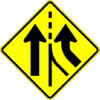 |
 |
Guidance. The Added Lane (W4-3) sign should be installed in advance of a point where two roadways converge and merging movements are not required. When possible, the Added Lane sign should be placed such that it is visible from both roadways; if this is not possible, an Added Lane sign should be placed on the side of each roadway.
When an Added Lane sign should be installed on a roadway that curves before converging with another roadway that has a tangent alignment at the point of convergence, the Entering Roadway Added Lane (W4-6) sign should be used to better portray the actual geometric conditions to road users on the curving roadway.
903.6.33 LANE END Signs (W4-2, W9-1, W9-2) (MUTCD Section 2C.42)
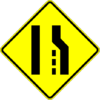 |
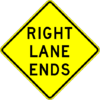 |
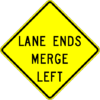 |
Guidance. The LANE ENDS MERGE LEFT (RIGHT) (W9-2) sign or the Lane Ends (W4-2) sign should be used to warn of the reduction in the number of traffic lanes in the direction of travel on a multi-lane highway.
Option. The RIGHT (LEFT) LANE ENDS (W9-1) sign may be used in advance of the Lane Ends (W4-2) sign or the LANE ENDS MERGE LEFT (RIGHT) (W9-2) sign as additional warning or to emphasize that the traffic lane is ending and that a merging maneuver will be required.
On one-way streets or on divided highways where the width of the median will permit, two Lane Ends (W4-2) signs may be placed facing approaching traffic; one on the right-hand side and the other on the left-hand side or median.
Support. EPG 620.2.9 Lane Reduction Transition Markings contains information regarding the use of pavement markings in conjunction with a lane reduction.
Guidance. Where an extra lane has been provided for slower moving traffic (see SLOWER TRAFFIC KEEP RIGHT Sign), a Lane Ends (W9-2) word sign or a Lane Ends (W4-2) symbol sign should be installed in advance of the downstream end of the extra lane.
Lane Ends signs should not be installed in advance of the downstream end of an acceleration lane of an interchange on ramp.
Standard. In dropped lane situations, regulatory signs (see EPG 903.5.12) shall be used to inform road users that a through lane is becoming a mandatory turn lane. The W4-2, W9-1, and W9-2 signs shall not be used in dropped lane situations.
903.6.34 Two-Way Traffic Sign (W6-3, W16-9P) (MUTCD Section 2C.44)
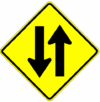 |
 |
Guidance. A Two-Way Traffic (W6-3) sign should be used to warn road users of a transition from a multi-lane divided section of roadway to a two-lane, two-way section of roadway.
A Two-Way Traffic (W6-3) sign with an AHEAD (W16-9P) plaque should be used to warn road users of a transition from a one-way street to a two-lane, two-way section of roadway.
Option. The Two-Way Traffic sign may be used at intervals along a two-lane, two-way roadway and may be used to supplement the Divided Highway Ends (W6-2) sign discussed in EPG 903.6.19.
Standard. The TWO WAY TRAFFIC supplemental plaque (W6-3c) has been discontinued. MoDOT shall no longer provide TWO WAY TRAFFIC supplemental plaques (W6-3c). Existing TWO WAY TRAFFIC supplemental plaques (W6-3c) shall be left in place until they reach the end of their service life.
903.6.35 NO PASSING ZONE Sign (W14-3) (MUTCD Section 2C.45)

Support. The NO PASSING ZONE (W14-3) sign is not to be used on a system-wide basis. It is intended for special use at locations where passing crashes are present and as a measure to correct those accidents.
Standard. The NO PASSING ZONE (W14-3) sign shall be a pennant-shaped isosceles triangle with its longer axis horizontal and pointing to the right. When used, the NO PASSING ZONE sign shall be installed on the left side of the roadway at the beginning of no-passing zones identified by pavement markings or DO NOT PASS (R4-1) signs or both (see EPG 903.5.16).
The use of the NO PASSING ZONE sign shall be approved by the State Highway Safety and Traffic Engineer.
903.6.36 Advisory Exit and Ramp Speed Signs (W13-2 and W13-3) (MUTCD Section 2C.14)
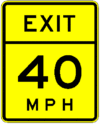 |
Standard. Advisory Exit Speed (W13-2) and Advisory Ramp Speed (W13-3) signs shall be vertical rectangles.
Guidance. If used, the Advisory Exit Speed sign should be installed along the deceleration lane and the advisory speed displayed should be based on an engineering study. When a Truck Rollover (W1-13) sign (see EPG 903.6.12) is also installed for the ramp, the advisory exit speed should be based on the truck advisory speed for the horizontal alignment using recommended engineering practices. If used, the Advisory Exit Speed sign should be visible in time for the road user to decelerate and make an exiting maneuver.
Guidance. If used, the Advisory Ramp Speed sign should be installed on the ramp to confirm the ramp advisory speed.
Option. Where there is a need to remind road users of the recommended advisory speed, a horizontal alignment warning sign with an advisory speed plaque may be installed at or beyond the beginning of the exit curve or on the outside of the curve, provided that it is apparent that the sign applies only to exiting traffic. These signs may also be used at intermediate points along the ramp, especially if the ramp curvature changes and the subsequent curve on the ramp have a different advisory speed than the initial ramp curve.
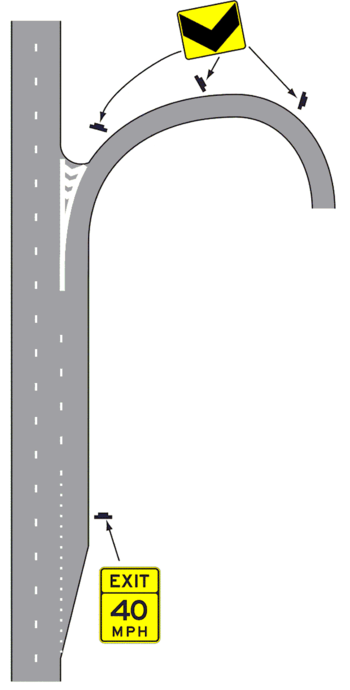
903.6.37 Intersection Warning Signs (W2-1 through W2-8) (MUTCD Section 2C.46)
 |
 |
 |
 |
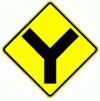 |
Support. Intersection Warning Signs are used when there is limited sight distance, crashes, or based on engineering judgment.
Option. A Crossroad (W2-1) symbol, Side Road (W2-2 or W2-3) symbol, T-Symbol (W2-4), or Y-Symbol (W2-5) sign may be used in advance of an intersection to indicate the presence of an intersection and the possibility of turning or entering traffic.
Intersection Warning signs may be used with Advance Traffic Control signs, but not replace the Advance Traffic Control sign.
The relative importance of the intersecting roadways may be shown by different widths of lines in the symbol.
An Advance Street Name plaque (see EPG 903.6.48) may be installed above or below an Intersection Warning sign.
Guidance. The Intersection Warning sign should illustrate and depict the general configuration of the intersecting roadway, such as crossroad, side road, T-intersection, or Y-intersection.
Where the side roads are not opposite each other, the symbol for the intersection should indicate a slight offset.
Roundabout Warning Signs (W2-6 and W16-17P)
Standard. The Circular Intersection sign shall be installed in advance of any roundabout intersection. The ROUNDABOUT (W16-17P) plaque along with the appropriate Advisory Speed supplemental plaque (W13-1P) shall be installed below the Circular Intersection sign.
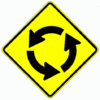 |
Option. If other circular intersections exist, that would not be classified as a roundabout, the Circular Intersection (W2-6) sign may be used.
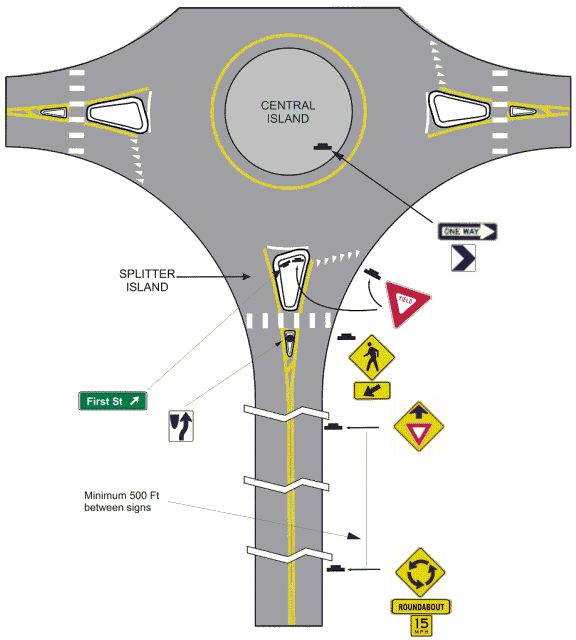
903.6.38 Two-Direction Large Arrow Sign (W1-7) (MUTCD Section 2C.47)

Standard. The Two-Direction Large Arrow (W1-7) sign shall be a horizontal rectangle. If used, it shall be installed on the far side of a T-Intersection in line with, and at approximately a right angle to, traffic approaching from the stem of the T-intersection (see Figure 903.6.38).
The Two-Direction Large Arrow sign shall not be used where there is no change in the direction of travel such as at the beginnings and ends of medians or at center piers.
The Two-Direction Large Arrow sign directing traffic to the left and right shall not be used in the central island of a roundabout.
Guidance. The Two-Direction Large Arrow sign should be visible for a sufficient distance to provide the road user with adequate time to react to the intersection configuration.
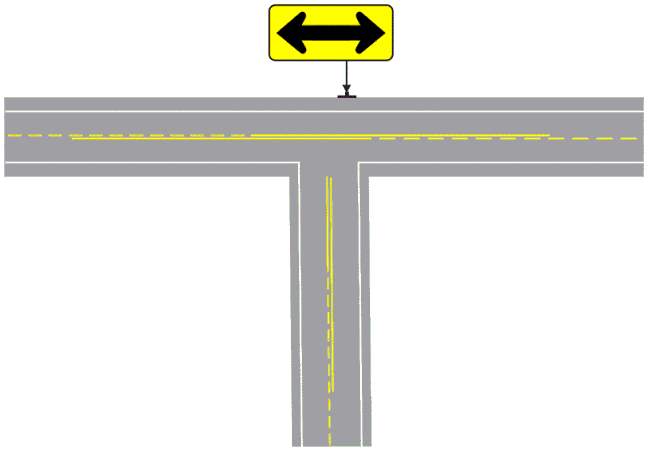
903.6.39 Traffic Signal Signs (W25-1, W25-2) (MUTCD Section 2C.48)
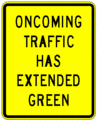 |
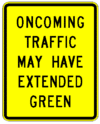 |
Support. If a left turn trap exists a Traffic Signal sign is needed, unless the signal has a permissive left that is tied to the opposing through (i.e. Dallas phasing).
Standard. At locations where either a W25-1 or a W25-2 sign is required based on the provisions in EPG 902.5.11 Application of Steady Signal Indications, the W25-1 or W25-2 sign shall be installed near the left-most signal head. The W25-1 and W25-2 signs shall be vertical rectangles.
903.6.40 Vehicular Traffic Warning Signs (W11-1, W11-1b, W11-5, W11-8, W11-10, W11-12P, W11-14) (MUTCD Section 2C.49)
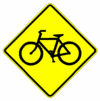 |
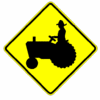 |
 |
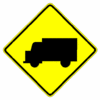 |
 |
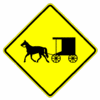 |
Option. Vehicular Traffic Warning (W11-1, W11-5, W11-8, W11-10, W11-12P, W11-14) signs may be used to alert road users to locations where unexpected entries into the roadway by trucks, bicyclists, farm vehicles, emergency vehicles, horse-drawn vehicles, or other vehicles might occur.
Support. These locations may be relatively confined or occur randomly over a roadway segment.
Guidance. Vehicular Traffic Warning signs should be used only at locations where the road user’s sight distance is restricted, or the condition, activity, or entering traffic would be unexpected. If the condition or activity is seasonal or temporary, the Vehicular Traffic Warning sign should be removed or covered when the condition or activity does not exist.
Haul routes that are sporadic should use the portable or turnable Truck Crossing installations and have a contract for Signs at Truck Crossings (TR12) executed. The TR12 Agreement can be found in eAgreements.
When the HORSE DRAWN VEHICLE sign (W11-14) or the BICYLE sign (W11-1) is used to notify motorists of these vehicles traveling along a roadway, the Share the Road supplemental plaque (W16-1P) should be installed below the sign and be repeated in accordance with the Share the Road sign guidance.
Option. Supplemental Warning plaques (refer to EPG 903.6.42) with legends such as AHEAD (W16-9P), XX FEET or NEXT XX MILES may be mounted below Vehicular Traffic signs to provide advance notice to road users of unexpected entries.
Standard. For an entrance to be eligible for “Emergency Vehicle Entrance” signing, the facility shall be adjacent and visible from the roadway, shall be recognizable as such and shall have direct access to the state roadway system. If the entrance is signalized, the Emergency Vehicle (W11-8) sign with the EMERGENCY SIGNAL AHEAD (W11-12P) supplemental plaque shall be placed in advance of all emergency-vehicle traffic control signals.
The Bicycle/Pedestrian Crossing (W11-15) sign shall be used to mark the crossing of a shared use path. A shared use path shall be a minimum of 8 feet wide serving both pedestrian and bicycle traffic. The Bicycle/Pedestrian Crossing sign shall be installed in advance of a marked shared use path crossing. At the shared use path crossing a Bicycle/Pedestrian Crossing sign with a Downward Diagonal Arrow (W16-7P) plaque shall be used, except at signalized and stop controlled intersections. When the shared use path also includes equestrian traffic, the TRAIL CROSSING (W11-15a) sign shall be used instead of the Bicycle/Pedestrian Crossing (W11-15) sign.
903.6.41 Non-Vehicular Warning Signs (W11-2, W11-3, W11-4, W11-7, W11-32, W11-33, W16-9P) (MUTCD Section 2C.50)
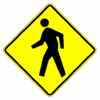 |
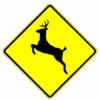 |
 |
 |
Option. Non-Vehicular Warning signs may be used to alert road users in advance of locations where unexpected entries into the roadway might occur or where shared use of the roadway by pedestrians, animals, or equestrians might occur.
Support. The conflicts may be relatively confined or occur randomly over a roadway segment.
Standard. Equestrian (W11-7) Crossing signs should only be installed at Public Equestrian Trail Crossings. Existing Equestrian (W11-7) Crossing signs that do not meet the Public Equestrian Trail Crossing criteria, shall be left in place until they reach the end of their service life.
Deer (W11-3) Crossing has been discontinued due to studies proving these signs provide little or no safety benefit. Existing signs shall be removed at the end of their service life.
The Pedestrian (W11-2) sign shall be used in advance of a marked pedestrian crossing. At a marked pedestrian crossing the Pedestrian sign and the Downward Diagonal Arrow (W16-7P) plaque shall be used, except at signalized and stop controlled intersections.
If a post-mounted W11-2 or W11-7 sign is placed at the location of the crossing point where pedestrians or equestrians might be crossing the roadway, a diagonal downward pointing arrow (W16-7P) plaque shall be mounted below the sign. If the W11-2 or W11-7 sign is mounted overhead, the W16-7P plaque shall not be used.
The Cattle (W11-4) sign shall be issued to an individual only when the Application for Sign at Cattle Crossings contract (TR09) is fully executed. The TR09 Agreement can be found in eAgreements.
Option. Supplemented plaques with the legend AHEAD or XX FEET may be displayed below crossing signs to inform road users that they are approaching a point where crossing activity might occur.
The crossing location may be defined with crosswalk markings (see EPG 620.2.18 Crosswalk Markings).
Guidance. The mixing of standard fluorescent yellow and fluorescent yellow-green backgrounds within a selected site area should be avoided.
903.6.42 FERRY CROSSING AHEAD Sign (W3-18)
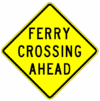
Option. The FERRY CROSSING AHEAD (W3-18) sign may be erected for a ferry crossing. A STOP (R1-1) sign at the ferry crossing may be used as a supplement.
903.6.43 Use of Supplemental Warning Plaques (MUTCD Section 2C.53)
Option. A supplemental warning plaque may be displayed with a warning or regulatory sign when engineering judgment indicates that road users require additional warning information beyond that contained in the main message of the warning or regulatory sign.
Standard. Supplemental warning plaques shall be used only in combination with warning or regulatory signs. They shall not be mounted alone or displayed alone. If used, a supplemental warning plaque shall be installed on the same post(s) as the warning or regulatory sign that it supplements.
Unless otherwise provided in this guidance for a particular plaque, supplemental warning plaques shall be mounted below the sign they supplement.
903.6.44 Design of Supplemental Warning Plaques (MUTCD Section 2C.54)
Standard. A supplemental warning plaque used with a warning sign shall have the same legend, border, and background color as the warning sign with which it is displayed. A supplemental warning plaque used with a regulatory sign shall have a black legend and border on a yellow background. Supplemental warning plaques shall be square or rectangular.
903.6.45 Distance Supplemental Plaques (W16-2 Series, W16-3 Series, W16-4P, W7-3aP) (MUTCD Section 2C.55)
 |
 |
 |
 |
Option. The Distance Ahead (W16-2 series and W16-3 series) supplemental plaques may be used to inform the road user of the distance to the condition indicated by the warning sign.
The Next Distance (W7-3aP and W16-4P) supplemental plaques may be used to inform road users of the length of roadway over which the condition indicated by the warning sign exists.
Standard. Distances shall be shown in ¼ mile or 100 ft. increments. If the distance is less than a ½ mile then feet shall be used.
903.6.46 Advisory Speed Supplemental Plaque (W13-1P) (MUTCD Section 2C.08)

Option. The Advisory Speed (W13-1P) plaque may be used to supplement any warning sign to indicate the advisory speed for a condition.
The Advisory Speed supplemental plaque may be used in conjunction with any standard warning sign.
| The procedure to determine the safe speed on a curve or turn is a ball-bank study. To correctly use the ball-bank indicator, the ball-bank indicator should be mounted on the dashboard of a passenger car and adjusted to read "0" when the car is stationary on a level grade with the ball-bank indicator being in a vertical plane. When adjusting the indicator, all personnel who are to be in the car while testing should be in their seats and all four tires should have the same pressure. It is usually best for at least two persons to be in the car while taking the ball-bank reading: one for driving, the other for observation and recording. |
| The 10-degree reading that can be maintained the complete length of a curve is the appropriate safe speed for that curve. Care must be taken to maintain the car in its proper lane and to maintain a smooth even speed throughout the curve. It will occasionally be found that a curve will have a higher safe speed in one direction than the other. In such cases, the lower safe speed should be used for both directions. Only increments of 5 mph are used on the Advisory Speed Plaque, therefore the curve shall be posted to the nearest 5 mph speed from the survey. |
Standard. The Advisory Speed plaque shall be used where an engineering study indicates a need to advise road users of the advisory speed for other roadway conditions. The Advisory Speed plaque shall be used with all curve, turn and winding road signs where the curve(s) ball-bank at least 5 mph below the posted speed. If the curve(s) ball-bank at, or above, the posted speed limit, the advisory speed plaque shall display the posted speed limit speed. If used, the Advisory Speed plaque shall carry the message XX MPH. The speed displayed shall be a multiple of 5 mph.
Except in emergencies or when the condition is temporary, an Advisory Speed plaque shall not be installed until the advisory speed has been determined by an engineering study. The Advisory Speed plaques shall never be mounted alone. The maximum advisory speed posted shall never be more than the posted speed limit. The Advisory Speed plaque shall only be used to supplement a warning sign and shall not be installed as a separate sign installation. The advisory speed shall be determined by an engineering study that follows established engineering practices.
Guidance. Because changes in conditions, such as roadway geometrics, surface characteristics, or sight distance, might affect the advisory speed, each location should be evaluated periodically or when conditions change.
Support. The Advisory Speed supplemental plaques are available in 5 mph increments.
903.6.47 Supplemental Arrow Plaque (W16-5P, W16-6P) (MUTCD Section 2C.56)
 |
 |
Guidance. If the condition indicated by a warning sign is located on an intersecting road and the distance between the intersection and condition is not sufficient to provide adequate advance placement of the warning sign, a Supplemental Arrow (W16-5P and W16-6P) plaque should be used below the warning sign.
Standard. Supplemental Arrow plaques shall have the same legend design as the Advance Turn Arrow and Directional Arrow auxiliary signs except that they shall have a black legend and border on a fluorescent yellow or fluorescent yellow-green background, as appropriate.
903.6.48 Advance Street Name Supplemental Plaque (W16-8P, W16-8aP) (MUTCD Section 2C.58)
Support. Advance street name signing can provide valuable information to the motorist. Intersections that are signed with Intersection Warning (W2 series) or Advance Traffic Control (W3 series) signs typically have inherent sight distance concerns. The addition of the street name to the warning sign can aid a motorist in making decisions in a timely manner.
Option. An Advance Street Name (W16-8P or W16-8aP) plaque may be used with any Intersection sign (W2 series) or Advance Traffic Control (W3 series) sign to identify the name of the intersecting street.
If the side road being signed is maintained by a public agency, the addition of the street name sign may be considered on request.
Guidance. Advance Street Name supplemental signs are only to be used with intersection or advance traffic control warning signs that are properly installed according to MoDOT guidelines.
Standard. The street name used on an Advance Street Name supplemental sign shall be the approved name used by either the local agency or the Emergency 911 Coordinator.
When used, the Advance Street Name supplemental plaque shall only be mounted below the W2 or W3 series warning sign or the Mileage Plaque on the same post. The Advance Street Name supplemental plaque for a 36 in. x 36 in. warning sign shall be a maximum of 36 in. wide and for a 48 in. x 48 in. warning sign shall be a maximum of 48 in. wide.
The lettering on Advance Street Name plaques shall be composed of a combination of lower-case letters with initial upper-case letters.
If two street names are used on the Advance Street Name plaque, a directional arrow pointing in the direction of the street shall be placed next to each street name. Arrows pointing to the left shall be placed to the left of the street name, and arrows pointing to the right shall be placed to the right of the street name.
903.6.49 CROSS TRAFFIC DOES NOT STOP Plaque (W4-4P) (MUTCD Section 2C.59)

Option. The CROSS TRAFFIC DOES NOT STOP (W4-4P) plaque may be used in combination with a STOP sign when engineering judgment indicates that conditions are present that are causing or could cause drivers to misinterpret the intersection as an all-way stop.
Standard. If a W4-4P plaque or a plaque with an alternate message is used, it shall be mounted below the STOP sign.
903.6.50 SHARE THE ROAD Supplemental Plaque (W16-1P) (MUTCD Section 2C.60)
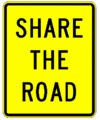
Option. In situations where there is a need to warn drivers to watch for other slower forms of transportation traveling along the highway, such as bicycles or horse-drawn vehicles, a SHARE THE ROAD (W16-1P) plaque may be used.
Guidance. SHARE THE ROAD (W16-1P) plaques should be installed at a point where vehicles will first encounter slower forms of transportation.
Option. SHARE THE ROAD plaques may be installed after any major intersections where new traffic might enter the roadway.
Standard. A W16-1P plaque shall not be used alone. If a W16-1P plaque is used, it shall be mounted below either a BICYCLE (W11-1) or a HORSE DRAWN VEHCLE (W11-14) sign. The background color of the W16-1P plaque shall match the background color of the warning sign with which it is displayed.
903.6.51 PHOTO ENFORCED Plaque (W16-10aP) (MUTCD Section 2C.61)

Support. The PHOTO ENFORCED (W16-10aP) word message plaque is no longer used on MoDOT roadways due judicial issues. The limited number of red light photo enforcement sites are signed using the R10-18a, see EPG 903.5.31.
903.6.52 IMPASSABLE DURING HIGH WATER Sign (W8-18, W8-19a, W8-34, W8-35) (MUTCD Section 2C.35)
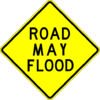 |
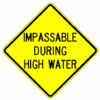 |
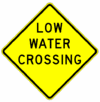 |
Option. The IMPASSABLE DURING HIGH WATER (W18-34) sign may be used to warn of a low water crossing, or a section of highway where normal rainfall will cause water to be over the roadway, see EPG 616.23 Traffic Control For Field Operations. Where used, this sign may be a flip sign with the combination of a ROAD MAY FLOOD sign (W8-18).
The LOW WATER CROSSING (W8-35) may also be used to warn of low water crossings.
Standard. The Flood Gauge (W8-19) sign shall be used at all low water crossings as a supplement to the IMPASSABLE DURING HIGH WATER sign and shall indicate the depth of the water at the deepest point on the roadway.
903.6.53 Sign Barricades (MUTCD Section 2B.67)
 |
 |
 |
 |
Option. Sign Barricades (GB-2 or GB-3) may be used when added emphasis is needed for a change in horizontal roadway alignment (see Fig. 903.6.53.1).
Sign Barricades (GB-4) may be used opposite the stem of the tee intersection (see Fig. 903.6.53.2).
Guidance. Sign barricades should be centered with the approaching lane of traffic. Sign barricades should not be used at transitions from 4-lane divided to 2-lane roadways for typical signing at these locations.
Standard. Sign Barricades shall be installed per Std. Plan 903.02.
GB-4 barricades shall be placed on the far side of the T-intersection with the lines sloping downward in both directions from the center of the barricade.
GB-3 barricades shall be placed in the line of site of the driver approaching the left turn with the stripes sloping downward from the right to the left.
GB-2 barricades shall be placed in the line of site of the driver approaching the right turn with the stripes sloping downward from the left to the right.
GB-5 barricade shall be placed where roadways end and no vehicular movements are provided, the stripes shall slope downward toward the center of the barricade.
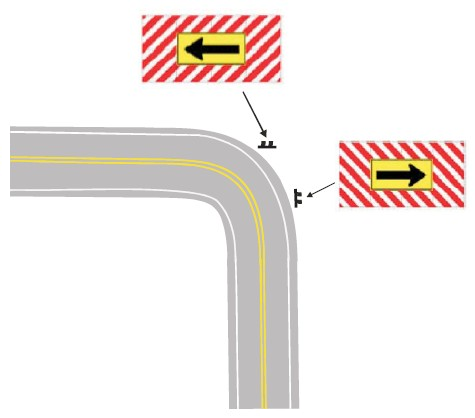
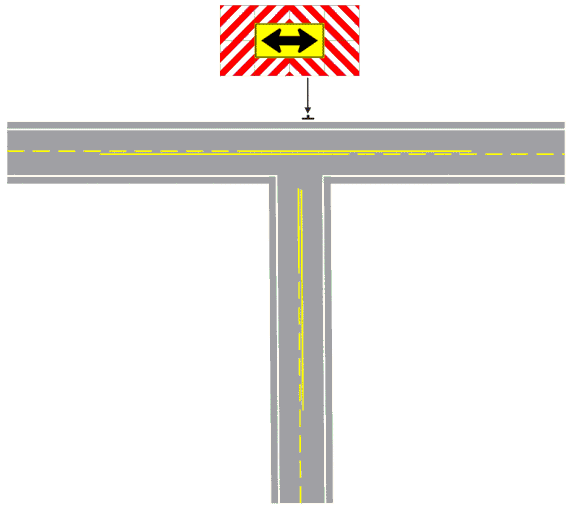
903.6.54 Shoulder Barricade Assembly
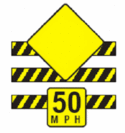
Option. Shoulder barricades may be used for added emphasis of standard warning sign installations at the direction of the engineer.
Standard. The shoulder barricade assembly shall consist of three horizontal boards (GB-1L or GB-1R) marked with reflective diagonal stripes and a 48-inch standard warning sign and a 48 in. standard warning sign with the appropriate 30-inch advisory plaque. See Figure 903.6.54 for typical construction.
GB-1R shoulder barricades shall be installed on the right side of the travelway and have diagonal stripes sloping downward from the right to the left.
GB-1L shoulder barricades shall be installed on the left side of the travelway and have diagonal stripes sloping downward from the left to the right.
Option. Supplemental signs may be installed on the shoulder barricade at the direction of the engineer.
Guidance. Shoulder Barricades should be installed on the appropriate sized wood post or on wide flanged structural steel posts.
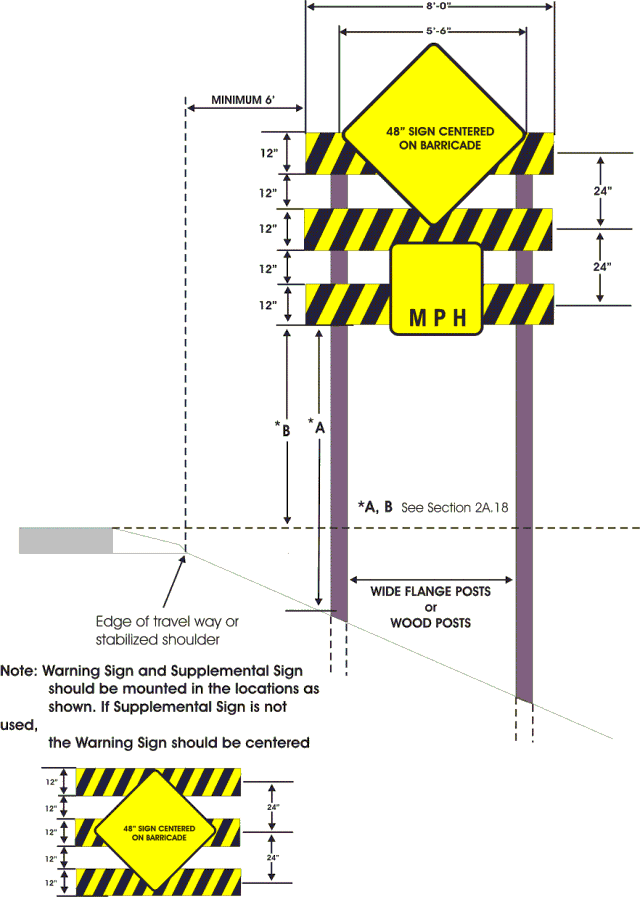
903.6.55 Warning Signs Provided for Other Agencies
Support. MoDOT will provide, if requested by the appropriate local traffic authority, warning signs for conditions beyond the end of state-maintained right of way.
If the location for placement of an advance warning sign for a curve, turn, paved road, stop condition or other condition deemed appropriate falls on state-maintained right of way, MoDOT will place and maintain the traffic control device on state-maintained right of way at the request of the local traffic authority.
Standard. The placement of all traffic control devices on the state highway system shall be governed by the Engineering Policy Guide. MoDOT is responsible for the placement and maintenance of all signs on state-maintained right of way.
903.6.56 Passing Lane Warning Signs (W6-6a, W6-6aP, W6-16, W6-17)
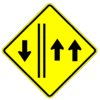 |
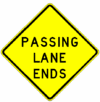 |
 |
Support. Alternating passing lanes may be provided on rural, two-lane highways to provide motorists with an opportunity to pass slower vehicles without crossing the centerline. Where passing lanes are provided, operations and safety may be improved by giving motorists advance information about the location of passing lanes. Providing motorists with advance notice of passing lanes may reduce the number of passing maneuvers.
Standard. The PASSING LANE ENDS (W6-16), WATCH FOR LEFT-TURNING TRAFFIC IN PASSING LANE (W6-17), PASSING LANE SYMBOL (W6-6a), and PASSING LANE PLAQUE (W6-6aP) signs shall be black legend and fluorescent yellow background and shall only be used in alternating passing lane sections.
The PASSING LANE ENDS sign shall be used prior to the end of the passing lane to warn motorists the passing lane in that direction of travel is ending and merging back to a single lane. The sign shall be placed in advance of the LANE ENDS MERGE RIGHT (W9-2) sign at a distance determined by Table 903.6.6 Guidelines for Advance Placement of Warning Sign.
The PASSING LANE SYMBOL sign shall be placed at the beginning of each passing lane to indicate a passing lane is now available. The sign shall be oriented so that the arrows on the sign correspond to the actual lane configurations. The PASSING LANE PLAQUE (W6-6aP) shall be used above the PASSING LANE SYMBOL. The supplemental distance plaque (W7-3aP) shall be used below the PASSING LANE PLAQUE.
Option. The WATCH FOR LEFT TURNING TRAFFIC IN PASSING LANE sign may be used at locations in a passing lane segment where left turns are common, such as at a county road. This sign may be installed at the judgement of the engineer.
903.6.57 TRAVEL SAFE ZONE – FINES DOUBLED Sign (W26-1)
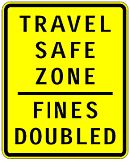
Support: The TRAVEL SAFE ZONE - FINES DOUBLED (W26-1) sign is not to be used on a system-wide basis. It is intended for special use at locations where severe crashes are occurring. There is a requirement for regional support to focus a safety campaign involving local law enforcement and public information efforts to reduce the number and severity of crashes within the travel safe zone (see EPG 907.3).
Standard: A TRAVEL SAFE ZONE – FINES DOUBLED sign shall be used to mark the beginning of a designated travel safe zone. This sign is installed in conjunction with the FINES DOUBLED ENDS (R2-20) sign.
903.6.58 NOTICE Plaque (W16-18P) (MUTCD Section 2A.15)

Support: It is sometimes necessary to increase the conspicuity of a regulatory sign to attract drivers’ attention to the message the sign is conveying. This may be necessary to help notify drivers to a speed limit reduction, turning movement prohibition, or bridge weight restriction. The NOTICE (W16-18P) plaque is an alternate to the use of red flags (see EPG 903.2.17 Enhanced Conspicuity for Standard Signs).
Option: Based on engineering judgment, where the improved conspicuity of a standard regulatory sign is desired, a NOTICE (W16-18P) plaque may be mounted above regulatory signs to attract additional attention to the sign.
Standard: The NOTICE (W16-18P) plaque shall not be used alone and the plaque shall be installed directly above the regulatory sign it is enhancing.
Guidance: The use of the NOTICE (W16-18P) plaque should be based on engineering judgment and not systematically applied to a specific sign unless otherwise specified in the EPG.

903.6.59 Vehicle Speed Feedback Plaque (W13-20aP) (MUTCD Section 2c.13)
-
W13-20aP
Option: A Vehicle Speed Feedback (W13-20aP) plaque that displays the speed of an approaching vehicle to the vehicle operator may be used to provide warning to drivers of their speed in relation to a speed limit sign.
Standard: When used to display the speed of an approaching vehicle in relation to the posted speed limit, the Vehicle Speed Feedback (W13-20aP) plaque shall be mounted below a Speed Limit (R2-1) sign. The speed limit sign shall be a minimum of 30”x36” on conventional roads and a minimum of 36”x48” on freeways and expressways. The Vehicle Speed Feedback assembly shall not be installed at a location where the posted speed limit on the route changes. Vehicle Speed Feedback assemblies shall be placed anywhere downstream of a speed limit change but shall be a minimum of 200 feet down stream of a speed limit change on conventional routes and a minimum of 400 feet down stream of a speed limit change on expressways of freeways. Vehicle Speed Feedback assemblies shall be installed in accordance with the Vehicle Speed Feedback Assembly Typical Application.
The legend YOUR SPEED shall be a black legend on a yellow retroreflective background with the YOUR SPEED text on one line. The changeable legend displaying the speed of the approaching vehicle shall be a yellow luminous legend on a black opaque background. The vehicle speed displayed on the changeable portion of the sign shall be displayed as an integer. The Vehicle Speed Feedback sign and plaque shall not flash, strobe, change color, or use other animated elements integrated into the changeable legend display. When no vehicles are approaching, the changeable display shall not display a legend.
No Speed Sign shall have the capability to collect, store or transmit data of any type.
Guidance: The changeable portion of the Vehicle Speed Feedback legend should be approximately the same height, width, and stroke of those on the Speed Limit sign it supplements or is mounted below.
The W13-20aP should be approximately the same width of the Speed Limit sign it is mounted below.







